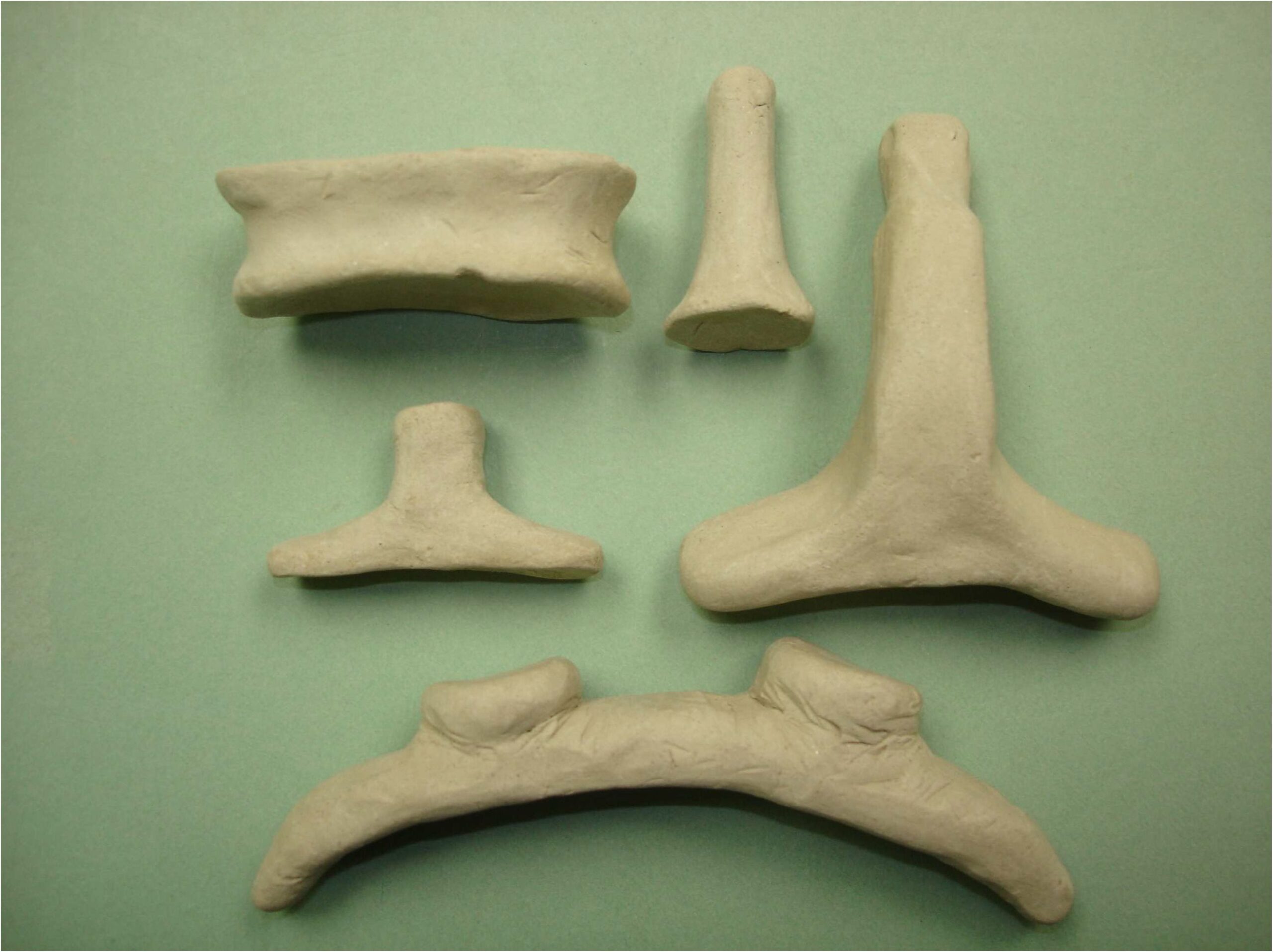2007.
By Grant Keddie
Introduction
In my publication: “The Use and Distribution of Labrets on the North Pacific Rim” (Syesis 14:59-80, 1981), and paper: “Symbolism and Context: The World History of the Labret and Cultural Diffusion on the Pacific Rim” (Keddie 1989 – this web site), I presented an overview of the geography, timing, gender relations and symbolism pertaining to labrets or lip plugs.
I have argued that Labrets are artifacts of significant importance in the interpretation of past human behaviour. As highly visual body adornment, labrets provide evidence of relationships between and among people. Labrets have taken on complex symbolic meanings beyond the obvious indicators of group membership, age, gender and class identity. Once they become established in a traditional society they become elements of conservatism. In each culture they take on an ingrained symbolic function.
People that initially wear labrets within a region are involved in some kind of close exchange relationship – usually one that involves marriage ties.
As artifacts, labrets are a material expression that reflects the special extent and intensity of both intra-regional and inter-region social networks. Archaeological evidence has demonstrated that their introduction and disappearance from various regions of the world go hand-in-hand with other items of culture or behaviour – such as a change in economy or settlement pattern. These changes are often seen at the level of regional networks.
Our knowledge of the archaeological occurrence of labrets remains undeveloped. All but 7 of the 158 labrets in the RBCM collection come from the Gulf Islands, the Lower Fraser River and S.E. Vancouver Island. Eighty one of these come from only 6 archaeological sites. A similar pattern can be seen for labrets held in the collection of the University of British Columbia and Simon Fraser University. By showing the multiple varieties of labrets in the RBCM collections, that span a time period of at least 4500 years, I hope to promote better documentation of and stimulate further discussion on this important type of artifact.
What was the relationship of labret wearers within the southern coast of British Columbia, and what was the relationship between those on the southern part and the rest of the coast before two thousands years ago? Where did the practice of wearing labrets originate? What was the process by which it spread and the reasons for the practice disappearing?
We know from historic examples of labrets from parts of the northern coast of British Columbia that most are made – in whole or in part – of wood. It is likely that wooden labrets were a common feature on the southern coast where all labrets disappeared from the record around 2000 years ago. In addition to labrets made completely of lignite coal, purple hinge scallop shell, bone and many varieties of stone, there appear to have been many composite examples made of different raw materials.
Many of the unidentified artifacts that archaeologists have traditionally called “Gulf Island Complex artifacts” are likely parts of labrets, but we need to await further evidence to be certain in regard to some varieties.
An example of one type of the latter is the small stylistic tabular stones that were likely symbolic parts of wooden labrets. Some of these, such as a quartz crystal example from Pender Island – recorded as artifact DeRt4:612 – show wear patterns on their flat ends similar to the kind of wear that occurs on the proximal surface of a stone labret. That is, micro-scratching and general weathering that occurs while the labret is in a persons’ mouth.
I made a model of an arbutus wood labret (Figure 1) to demonstrate how the quartz crystal artifact DeRt4:612 might appear from the inside of a labret. Figure 1B shows the distal end as it would appear from the side when the mouth was closed. The middle and distal portion does not have the microscratching that is on the flat proximal end. When this hypothetical composite labret would be worn in the sun light, the light would shine through from one surface to another – sometimes with a prism effect.
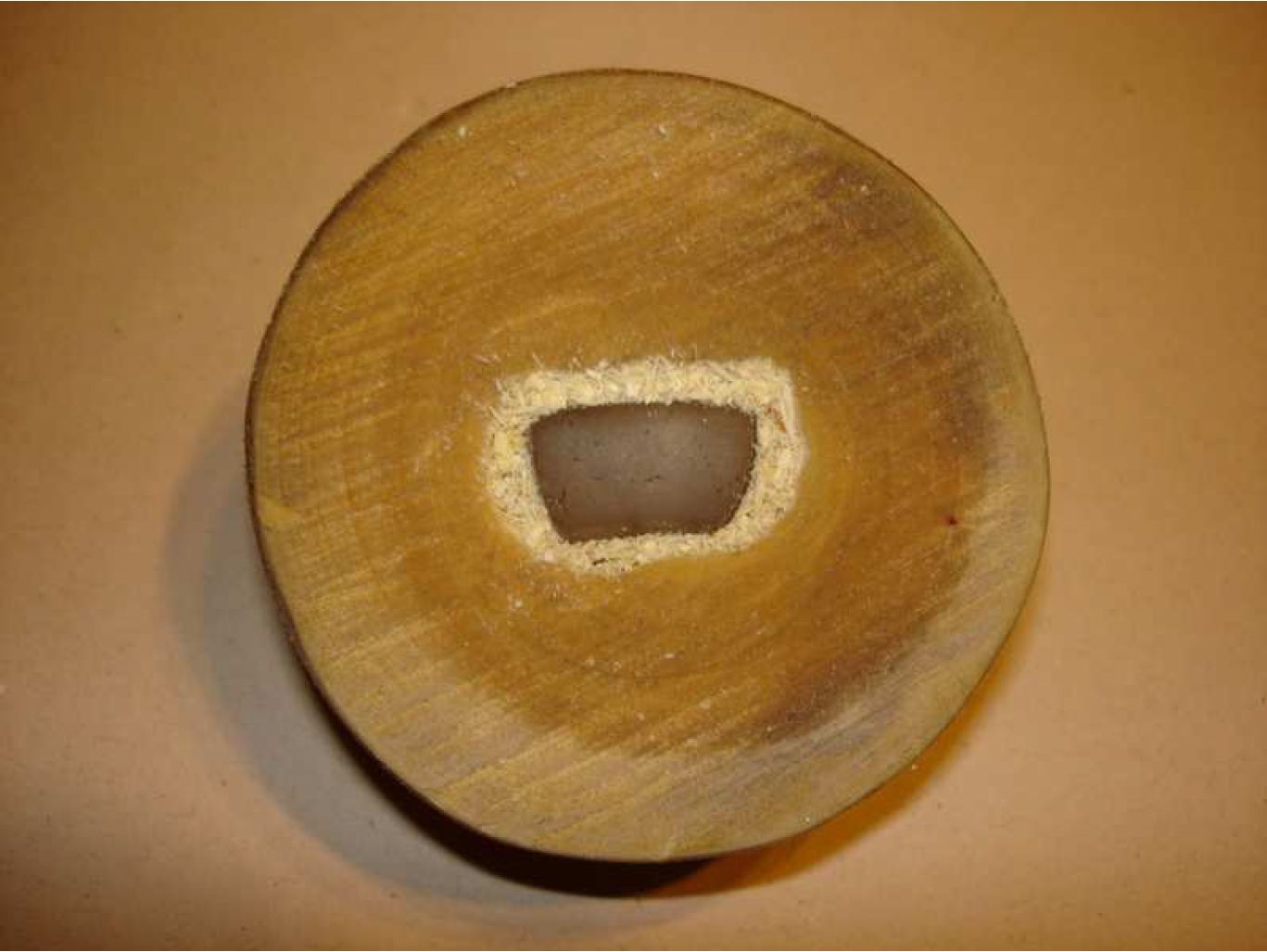

The Collections
A total of 158 labrets or labret parts are described here. These include all examples from both the ethnology and archaeology collections. Only three or four are true ethnological examples.
The Ethnographic Collection
[For descriptive terminology see appendix 1].
There are eight labrets in the ethnology collection. Only three or four of these are likely to be ethnological artifacts that had been used near to the time they were collected. Four or five appear to have been found in an archaeological context but placed in the ethnology collection.

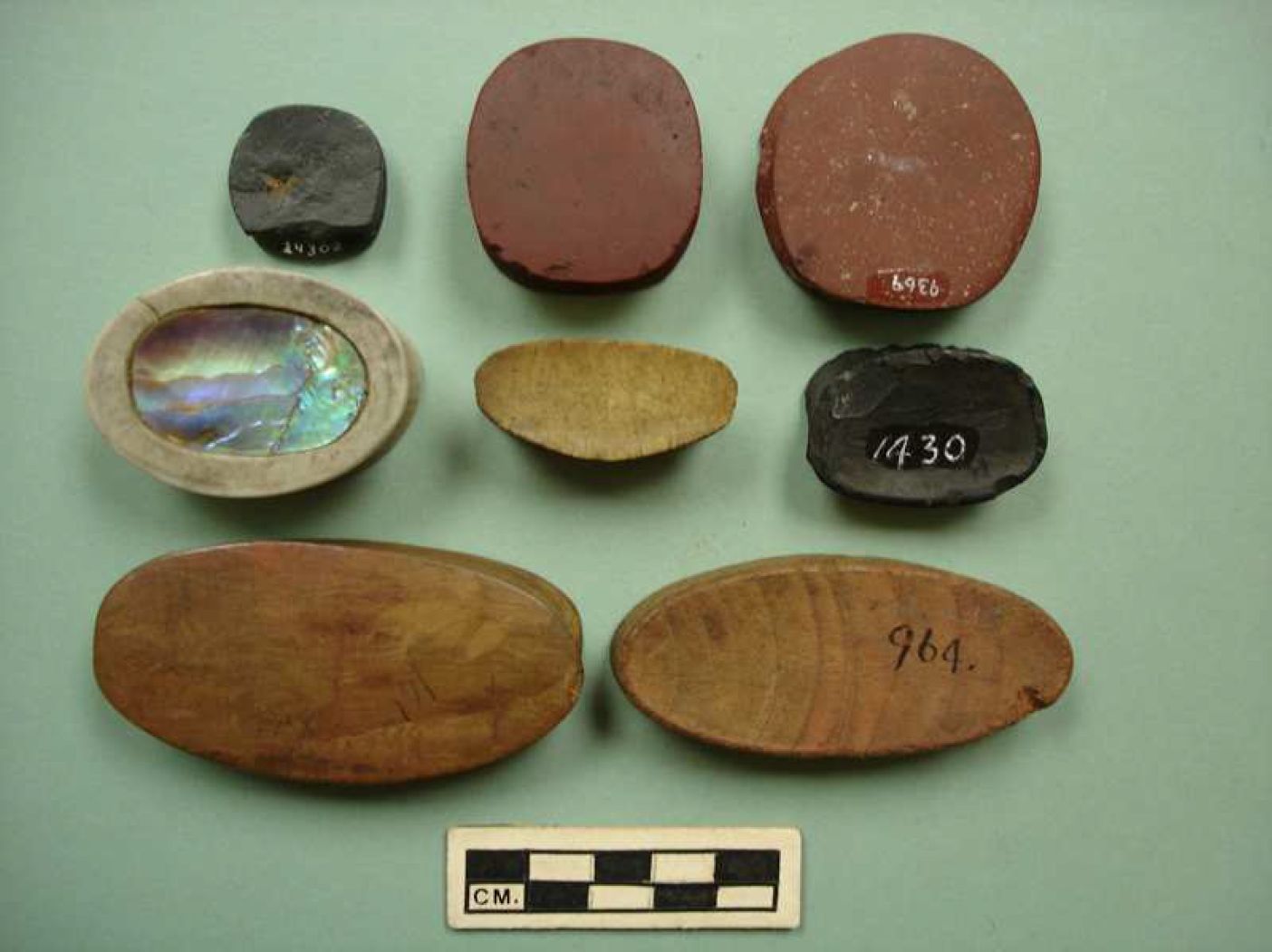
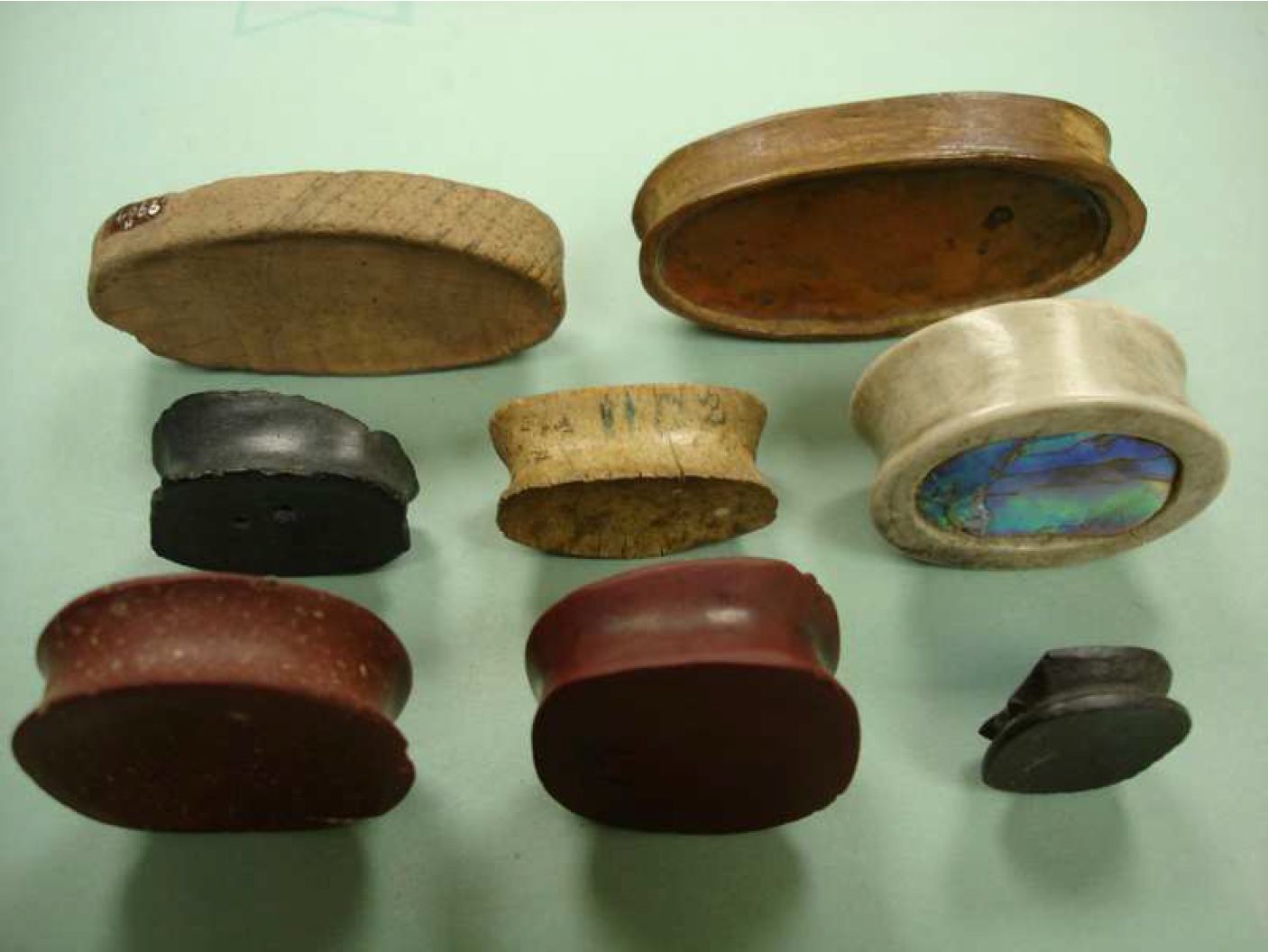

172. Circular flange Oval shaped bone labret with central hole containing abalone inlays on both sides. It is uncertain weather the hole is shallow or continues through the bone. There may be a piece of material other than bone between the two abalone inlays, in which case the main body of the labret is like an oval ring. There is no obvious distal (facing out from the body) or proximal surface, but one side that has more tooth scratches was likely the end most commonly placed against the teeth, and is here referred to as the proximal surface . The length (distal to proximal) varies from 18.3mm at one end to 18.8mm in the middle and 19mm at the other end. Distal surface measurements are W. 46.5mm; Height 33.2mm. Proximal measurements are W. 46.5mm; H. 32mm. The outer bone ring varies in thickness on the distal side from 5.5mm to 6mm. The abalone inlay is 32mm by 22mm on this side. The proximal surface has a bone rim thickness of 5mm to 8mm and the inlay is 32mm by 23mm. The width across the groove is 42.4mm. The intensity of the colours may suggest that the abalone is the California abalone. Weight: 29 grams. It was purchased on Haida Gwai by James Deans about 1892.
9964 (old number 964). Circular flange Oval shaped wooden labret. Concave on both surfaces. Annual rings in wood are clearly visible. Maximum length: 13.5mm. Distal surface: Width: 70.5mm; H. 30.5mm. Proximal surface: Width 70mm; H. 30.5mm. Length (Distal-proximal) 15mm. Weight: 14.22 grams. Weight: 14.4 grams. Rodent chew marks on proximal and distal edges of one end. Pencil marks on the artifact “Skid. X13” indicate that it was collected in Skidigate in November of 1913 by Charles Newcombe. Newcombe’s notes indicate it was from “ex (chief) Wihat. Massett”. Newcombe number “164” – “Labret. Wood, old plain ex Wihat – Masset”. “Wiat of Yagan New Tow[n?] Kliellan Kugawai”.
10012 (old number 1012). Circular flange oval shaped wooden labret with a thin piece of copper inlay on the distal surface. The distal surface is concave and the proximal surface slightly convex. Maximum length (distal- proximal): 15mm. Distal surface 74mm; height 36.2mm. Copper inlay W. 65mm; H. 30.2mm. Proximal surface W. 72mm; H. 35.2mm. No visible seasonal rings in wood. Weight: 18.7 grams. From estate of William A. Newcombe. Collected by Charles Newcombe in 1913. Notebook indicates it is from “Chaath”.
1429 (old unknown number “1102” in ink on side). Mammal bone. Oval shaped with more slight extension on one side. Slight concavity of both surfaces. Tooth scratches on both surfaces but more pronounced on one (proximal). Maximum L. 16.5. Maximum H. 19.2. Distal W. 38.6. Proximal W. 37.5. Width across groove 34mm. Weight: 14 grams. This labret was collected by Charles Newcombe in 1913 from the Haida village of Chaatl. It is uncertain weather it was collected from a living person or found as an archaeological item.
1430. Small circular flange oval shaped black argillite labret. Both surfaces concave to about 1mm. Extensive edge chipping on both surfaces. Horizontal tooth scratches on proximal surface. Maximum L. 14.5mm. Distal rim W. [34] mm (small piece missing- original width c. 35mm). H. 25mm. Proximal W. [36] mm (original c. 37); H. 25mm. Width across groove 31.5mm. Weight: 16.4 grams. “183’ is written on it in pencil. This appears to be an archaeological specimen. Purchased by Charles Newcombe on Sept. 2, 1911 from Ben Chapman in Massett (Haida Gwai).
14302. Small circular flange near circular shaped black argillite labret. Slightly more concave on distal surface. Piece broken off proximal end. Max. L 8mm. Width of distal end 23mm; H. 22.5mm. Proximal end W. [20] mm; H. 23mm. Width across groove: 18.5mm. Weight: 6.9 grams. Collected by William H. Collinson. This is an archaeological specimen. It is likely the specimen referred to by Charles Newcombe in his notes of May 21 under Lakalzah. He notes that a labret found in a 12 ft. ditch with skeletons on the property of A. Calder “is now in the possession of Archdeacon Collison”. (RBCM Archives Add Mss, Vol. 32, file 8). Later RBCM records record the artifact as being Nisga’a.
9709 (old number 709). Circular flange, nearly round shaped red slate or argillite labret. Minimal edge chipping. Slightly higher to one side. Both surfaces flat – difficult to determine which is distal and proximal. Max. L. 15.8mm. Both ends similar: W. 36.5mm; H. 35mm. W.36.5mm; H. 35.5mm. Width across groove 33mm. From William A. Newcombe estate. Collected by Charles Newcombe from Ole Robinson in Kitamaat c. 1910. “Kitamat 5” is written on specimen in pencil. Weight: 39.2 grams. This is likely an archaeological specimen. Later listed as being “Haisla”.
9369. Circular flange, nearly round shaped red slate or red argillite labret. Distal surface concave. A 3mm flat area extends along the edge of this surface, except for one side. The proximal surface is slightly convex. Distal W. 42.5; H. 41.8mm. Proximal W. 41.6; H. 41.4mm. Width of groove: 38.5mm. Max. L. 13.7mm. Weight: 38.7 grams. Found by George L. Moody about 1956 and donated in 1960. Found at “Chimdamish Creek, 15mi[les] E[ast] of Terrace”. “S. side Chimdemash 4 miles up”.
Archaeology Collection
West Coast Vancouver Island

DfSj100:61. Lateral flange. Round, hollowed out body design. It is likely that the hollowed out distal surface held some kind of an inlay – such as a mother-of-pear disc. Portions are broken off the body and flange. The flange extends slightly past the body portion on the non-flange sides. Body: L. [13mm], W. 52mm, H. [37mm]; Flange: W. [67mm], H: [38mm]. Original width/height of flange about 75mm by 51mm. The thickness from the base of the hollowed out body through to the flange is 6.2mm. The body wall base is 6mm-6.5mm thick and the broken upper portions 4.5mm-5.1mm thick. Weight: 30.8 grams. Notes: Permit 1991-94. Arcas Consulting Archaeologists Ltd. Site provenience: Trench II, Bulk B4, layer 6-7, c. 120 cm B.S. Deposits date between 2500 and 4000 year ago.
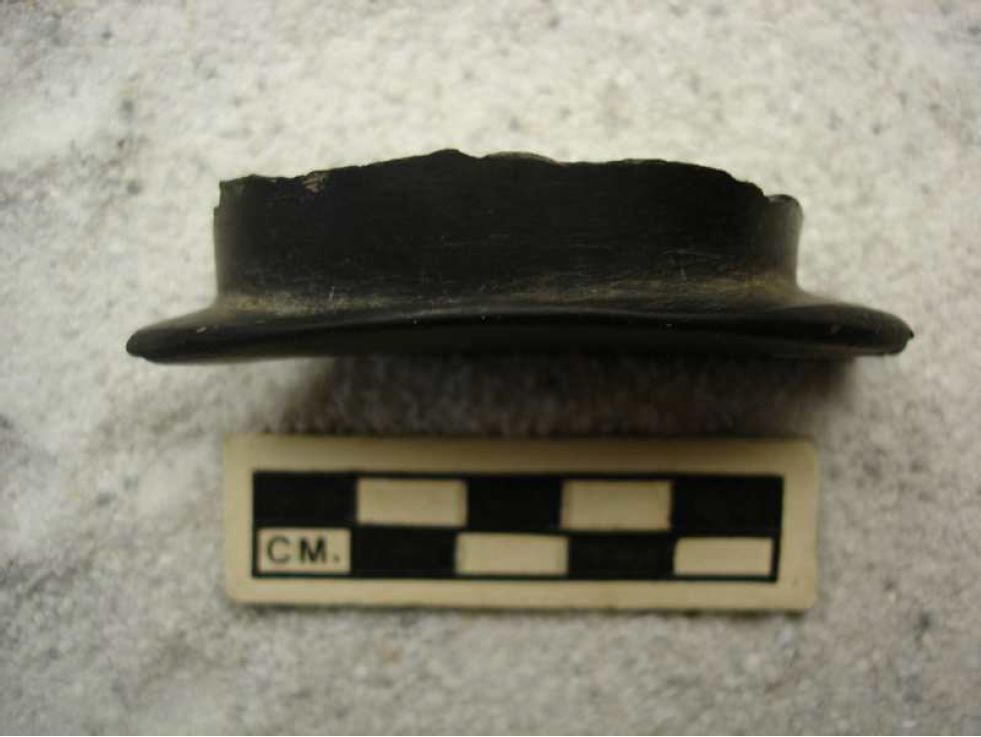
DfSj100:63. Fragment of circular flange labret with a cylindrical body extension. Black slate-like stone. Body: L. 28mm; W. [4.5mm]; height 1.2mm]. The flange is inset 2mm from rim. Weight: 2.04 grams.
South end of Vancouver Island – Sooke to Saanich.
DbRv17:1. Rocky Point area. Stone. Lateral flange extended body labret. Portion of body missing. Body: L. [7mm], [original estimated at about 15mm], W. 7mm; H. 6.1mm. Flange: W. 14.5mm; H. 6.1mm. Weight: 0.5 grams. Notes: Excavation, Mathews (2003, 2006). Test Pit 2, 30cm DBS.
DcRu12:1007. Lateral flange labret with an oval shaped projecting body that has a secondary downward extending part. The downward extension is concave on top (with a slight raised area in the proximal centre of the groove) and broken at the distal end. The distal end has V-shaped cut extending to the broken end on the dorsal surface and a small cut area on the ventral surface which suggests that the end may have had an ornament attachment hole or a bi-furcated end. Body: L. 12mm, W. 28.5mm, H. (main part of body) 17mm, Height – including downward extension: [35mm]. W. 41mm; H. 16mm. Weight: 16.8 grams. Notes: Surface beach find. The site has a lower component dating to c. 2900 – 2055 B.P. This is the only labret found at the site in spite of extensive excavations.
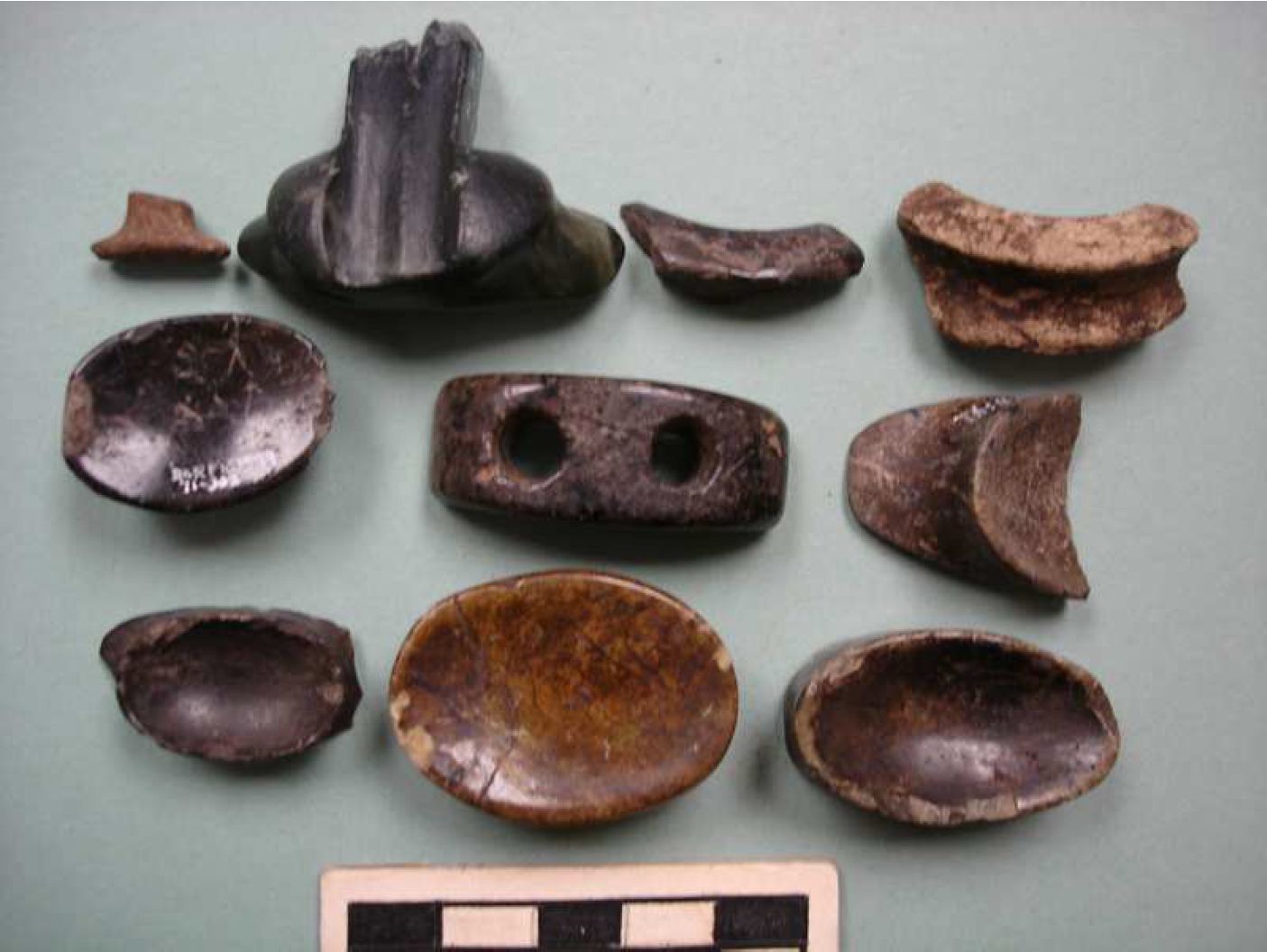
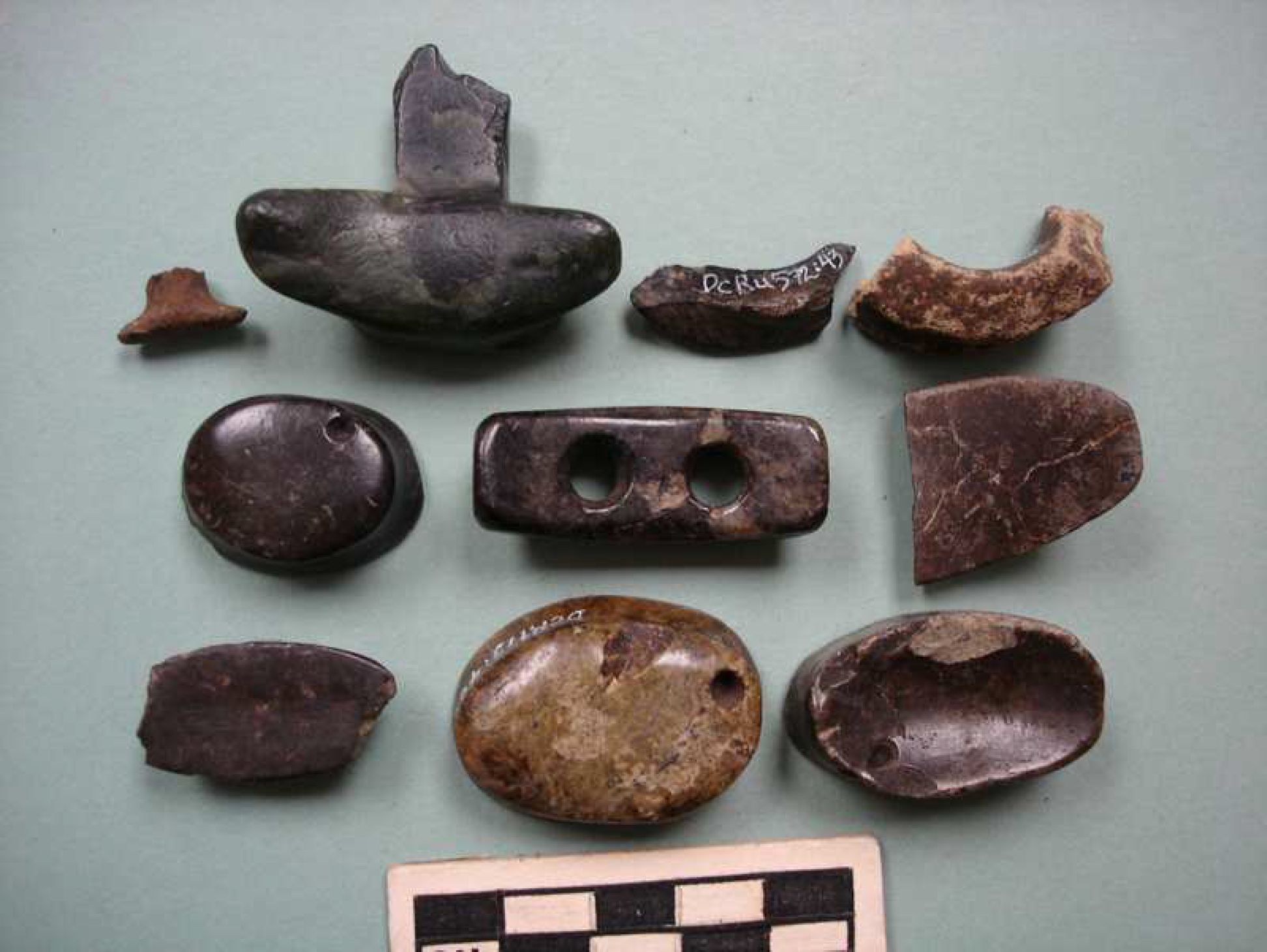
DcRu572:43. Langford. Vancouver Island. Portion of rim of labret or ear spool. The remnants of a large drilled hole is visible adjacent to a flat rim or flange. Raw Material: Stone. Body: W. [27mm]. Distance across from hole to edge of rim: 8.5mm. Weight: [1.6] grams. Notes: Permit 1995-045.
DcRu576:139. Langford. Vancouver Island. Labret flange. Two bi-conically drilled holes. W. 39mm, H. 15.5. Length at centre: 9.2mm. Distance between drilled holes on Distal surface: 9mm; Proximal surface: 7.5mm. Weight: 8.8mm. Notes: Permit 1995-045. Uncorrected shell date 3280-+70. Reservoir correction would date site to around 2400 years ago.
DcRt10:599. Willows Beach. Circular flange labret with tooth cord attachment hole penetrating on the left corner from the proximal surface to the side. Stone. Outer Rim: W. 27.5mm, H. 20mm; Inner Rim: W. 23.5mm; Height 10.2mm, Width at centre between rims: 18.3mm. Tooth cord attachment hole outer concavity 2.5mm and inner concavity 2.8mm. Weight: 5.1 grams. [Old acc. 71-302]. Notes: Permit report. Ray Kenny Thesis, 1974. From Zone B dated between 2630+-95 B.P (Gak 5102) and 2490+-85 B.P. (Gak5103) Uncorrected.
DcRt13: 26. Circular flange labret with tooth cord attachment hole penetrating on the left corner from the proximal surface to the side. Outer Rim: W. 35.1mm, H. 26mm. Inner Rim: W. 33.6mm, H. 22mm. L. 11.5mm. Tooth cord attachment hole outer concavity 3mm and inner concavity 2.4mm. Weight: 9.7 grams. Notes: Surface. Ken Martin collection.

DcRt13:123. Circular flange labret. Two 3mm holes were drilled for a cord attachment hole, but were not finished all the way through. This may have been an unfinished labret. Distal surface had “30mm by 15mm shallow depression”. Proximal surface slightly convex. Raw Material: Lignite coal. Body: L. 19mm, W. 31mm (outer Rim), H. 21mm (outer Rim). Weight: Not recorded. Notes: University of Victoria excavations 1967. Unit S8.4, E22.94, stratum B/68, S/20. No longer exists – it dried out and crumbled. [Bowker Creek: A microblade site on south-eastern Vancouver Island. Syesis, Vol. 12, 1979, p. 90 & Fig. 11, Donald H. Mitchell] Uncorrected dates [2740-+ 100 (9790 B.C.) Gak-2761; 2910-+100 ( 960 B.C.) are shell dates. With the reservoir correction for shell dates, the site deposits would are around 1900 to 2100 years old.
DcRt13:467. Circular flange labret with attachment hole penetrating on the left corner from the proximal surface to the side. Outer rim: W.35.1mm, H. 26mm; Inner rim: W. 33.7mm; H. 22mm. L. 11.3mm. Tooth cord attachment hole outer concavity 3.5mm and inner concavity 3mm. Weight: 12.3 grams. Notes: Originally given number DcRt13:74. Surface. Ken Martin collection.
DcRt13:479. Lateral flange short body labret. Flange has both ends partly missing. Body L. 23mm, W. 15.3mm, H. 7.2mm. Flange W. [22.5mm] [original L. c. 33mm], H. 15.3mm. 4mm concavity of distal surface. Weight: 3.6 grams. Notes: Found on disturbed surface at end of Lulie Street, Oct. 30, 1966. Ken Martin Collection.
DcRt15:1608. Portion of circular flange labret rim. Groove under rim. Central hole was likely fit with flat oval decorative material. Soft pumicelike material. W. [13.5mm]; H. (32mm); L. 16mm. 8.8mm across rim. Weight: [5.74] grams. Old #12658.
DcRt71:42. South of Cadboro Bay. Municipality of Oak Bay. Lateral flange short body labret. One half missing. The distal surface is concave to a depth of 5mm. The bottom of the body at the centre is only 2mm thick. Body: L. 7mm. W. [19mm], H. 22mm. Flange: W. 27mm, H. 22mm. Weight: [4.8] grams. Permit report. 1999. Millennia Research.
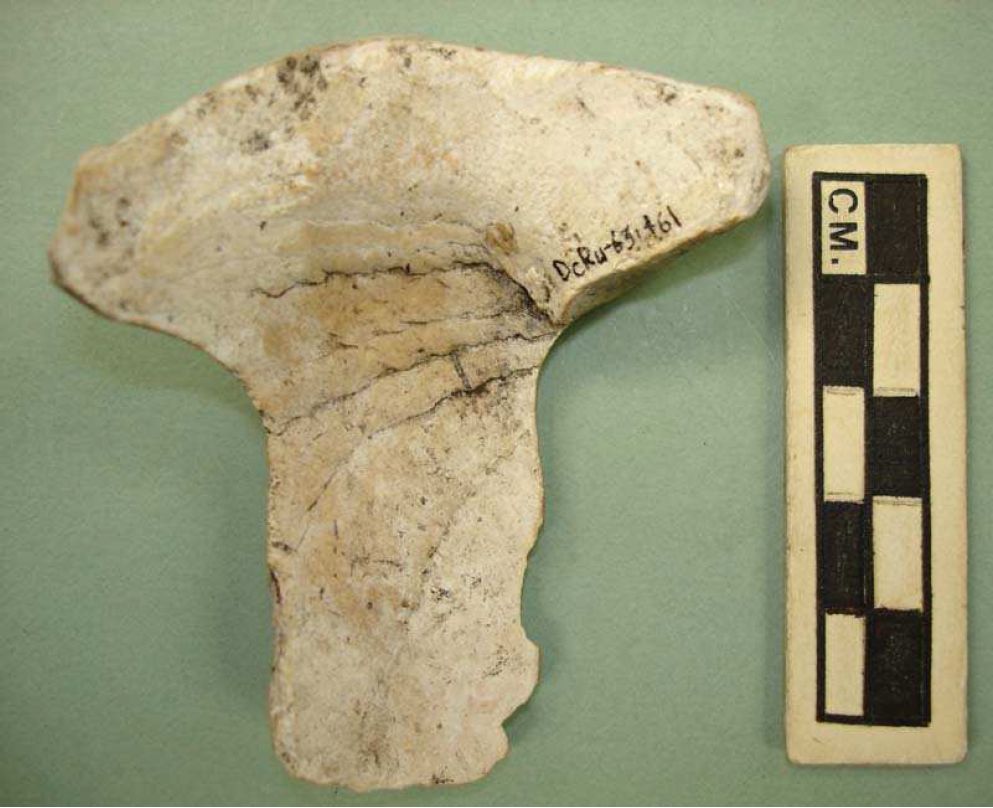

Esquimalt Harbour. Lateral flange labret with downward extension. Body turns downward 41mm below the edge of the main part of the body. Maximum length from top of labret to distal end of extension 66mm. The extension is straight down and only curves slightly toward the posterior. When it was worn the protrusion would cover the person’s chin. Purple Hinge Scallop shell. Body: L. 15.4mm, H. 25mm, W. 43.3mm. Flange: W. 58mm, H. 25mm. The downward body extension is concave with a thin edge becoming thicker toward the vertical axis. Max. thickness 9mm, but centre area 6mm thick. Width across extension averages about 24.5mm. Weight: 40 grams. Accession 2007-34. Permit 2005-226. Millennia Research Limited, April 2007. Archaeological Investigations for installation/replacement of power poles at the terminus of Stewart Avenue, View Royal, B.C. From disturbed deposits.
East Coast Vancouver Island. Cowichan Region.
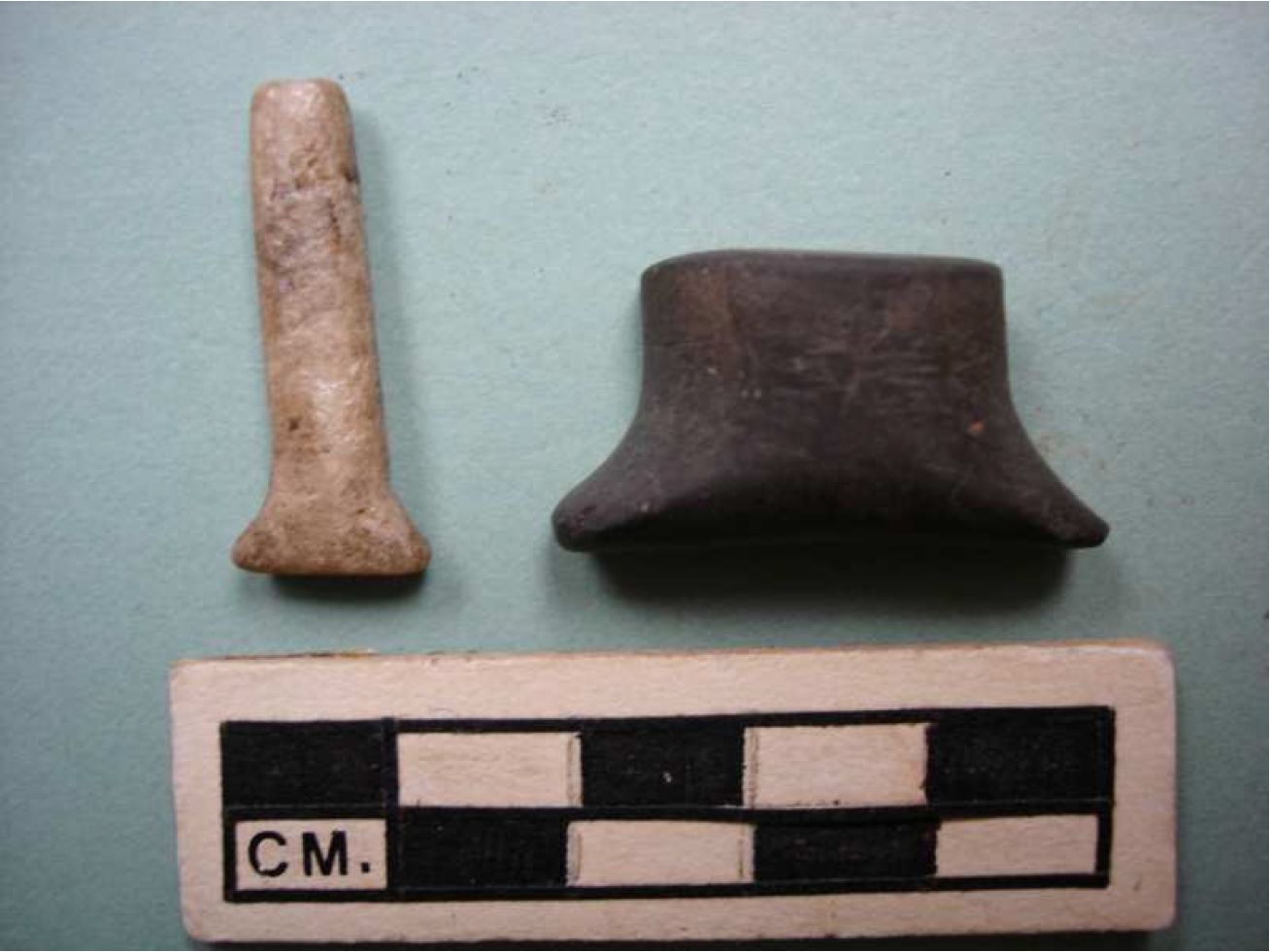
DeRv107:61. Cowichan Bay. Lateral flange short body labret. It is split vertically and missing about 1/3. Shale-like stone. L. 16mm. Body: W. 19.5mm, H. [11.8mm]. Weight: [7.9] mm. [Permit Report].
DeRv6:1. Mt. Tzuhalem. Lateral flange labret with a body that turns downward and curves inward to the flange. When it was worn it would cover the person’s chin. Body: Length extends out 16mm but downward extension is to 59mm; Max. Width: 30mm (26mm at proximal end); Th.16mm (proximal and distal ends with reduced thickness of 12mm at centre of body extension). Purple hinge scallop. Umbo of scallop shell forms the distal end. Flange: W. 42mm (end of left side broken off – Original width c. 50mm); H. 15mm. Weight: 50.5 grams.
DeRv6:3. Mt. Tzuhalem. Lateral flange labret with flat downward protruding body. Similar in appearance to DeRv6:1, but it has notches acrossthe flange 8mm from the ends – which would have served to tie the labret onto the teeth to prevent it from falling out. Length extends out 16mm but downward extension is to 53mm. Body: L. 52mm; W.33mm; Th. 15mm at distal end. Flange: W. 54mm; H. 12mm. Weight: 49.6 grams. Purple hinge scallop shell. Notes: From small ledge inside the entrance to a rock shelter.
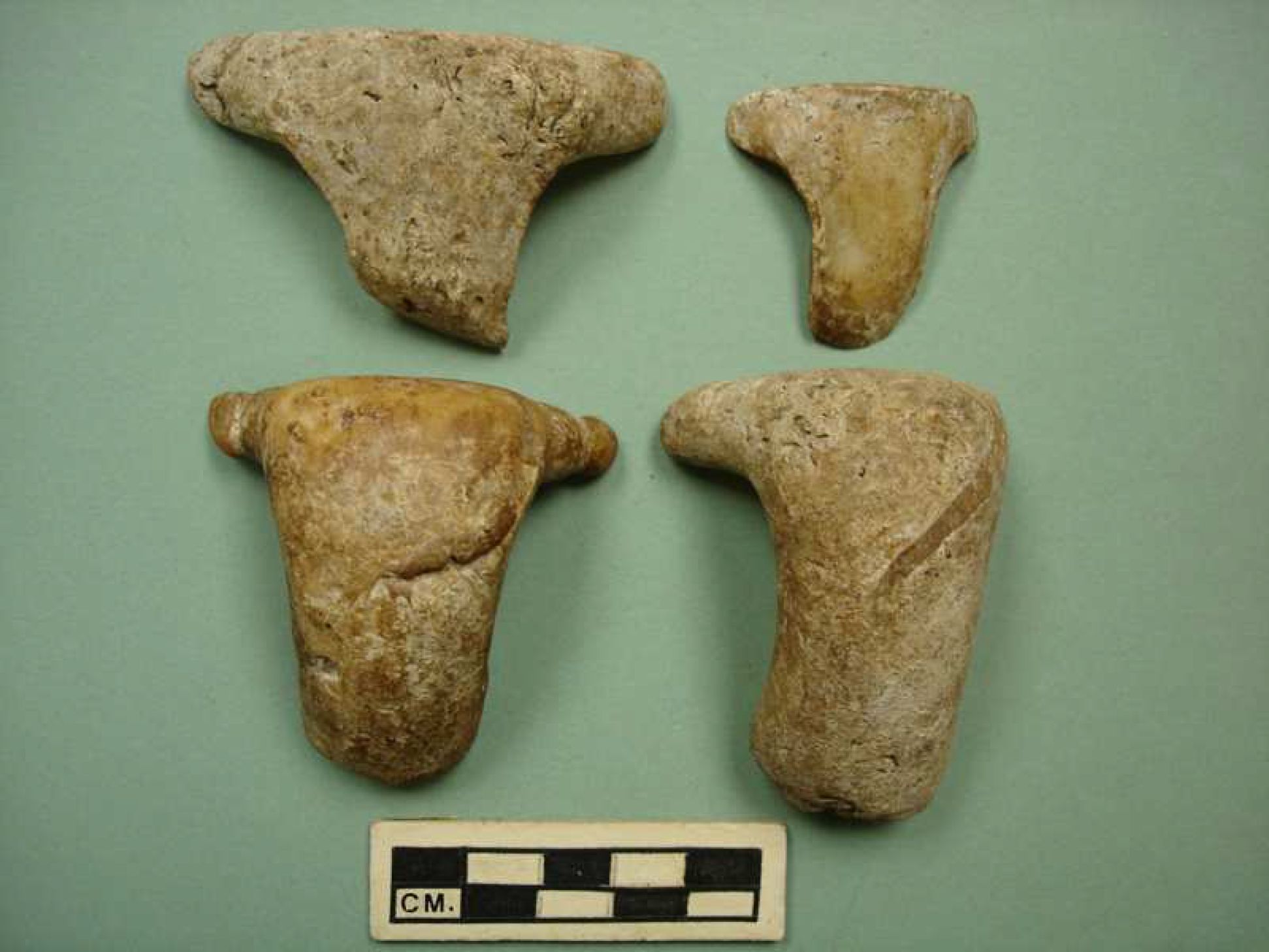
DeRv6:4. Mt. Tzuhalem. Lateral flange labret with flat downward protruding body. Body: L. 35mm; W. 22mm; Th. 5mm. Flange: W. 34.5mm;
H. 10mm. Weight: 6.3 grams. Purple Hinge scallop. Notes: One of four labrets found together on a small ledge inside the entrance to a rock shelter.
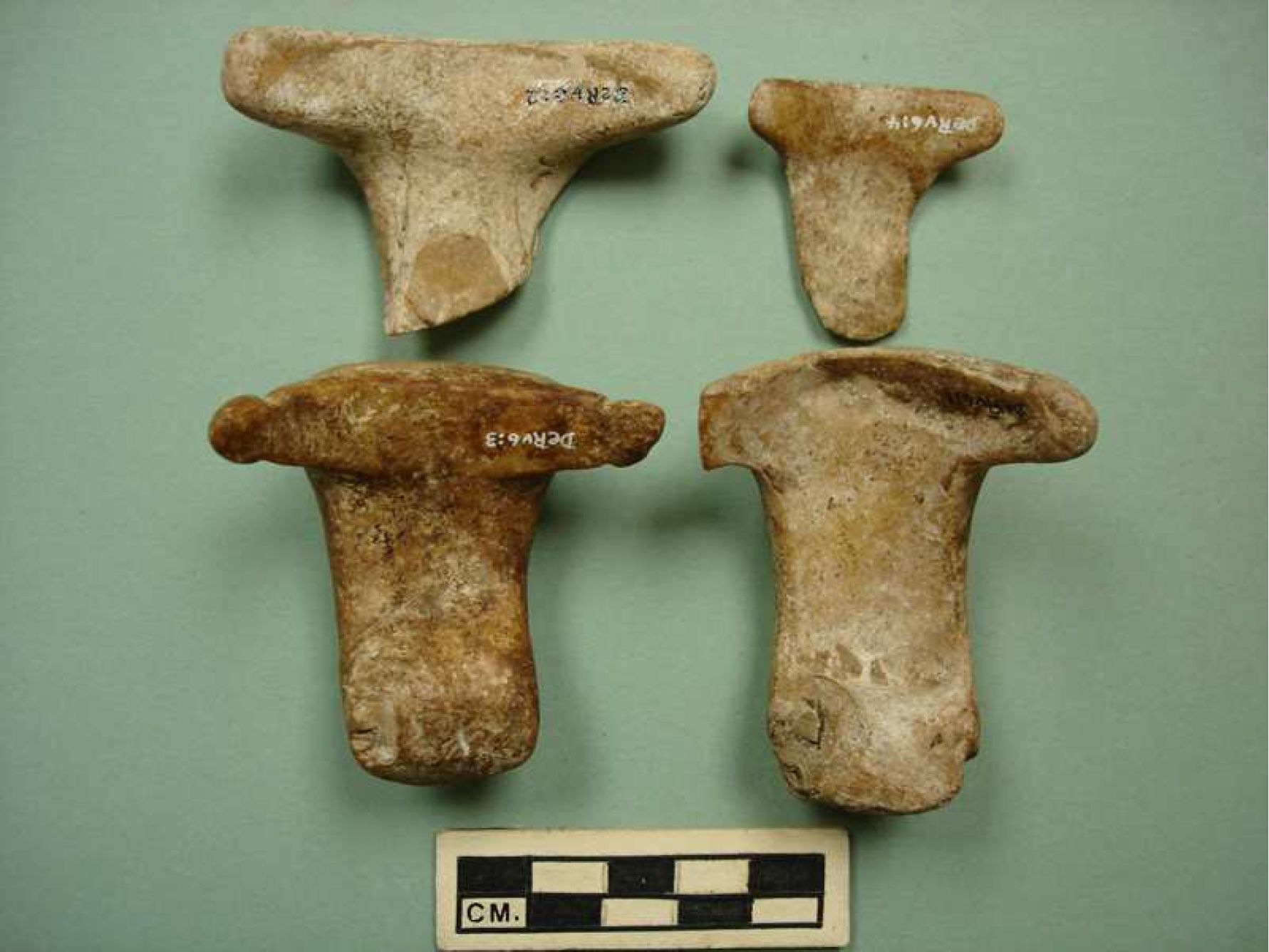
DeRv6:3. Mt. Tzuhalem. Lateral flange labret with flat downward protruding body. This specimen may have once been similar to DeRv6:1-2, but a piece sheared off that included the distal end and the upper portions of the proximal end. It was either re-ground or naturally weathered smooth. The distal end is asymmetrical – angling to one side. Body: L. [40mm]; W. 30mm; H. 8.5mm. Flange: W. 62mm; H. 16. Weight: 25.4 grams. Purple hinge scallop shell. Notes: One of four found together on a small rock ledge inside the entrance to a rock shelter created by large boulders piled together.
Eastern Vancouver Island. Nanaimo & Gabriola Island to Comox.
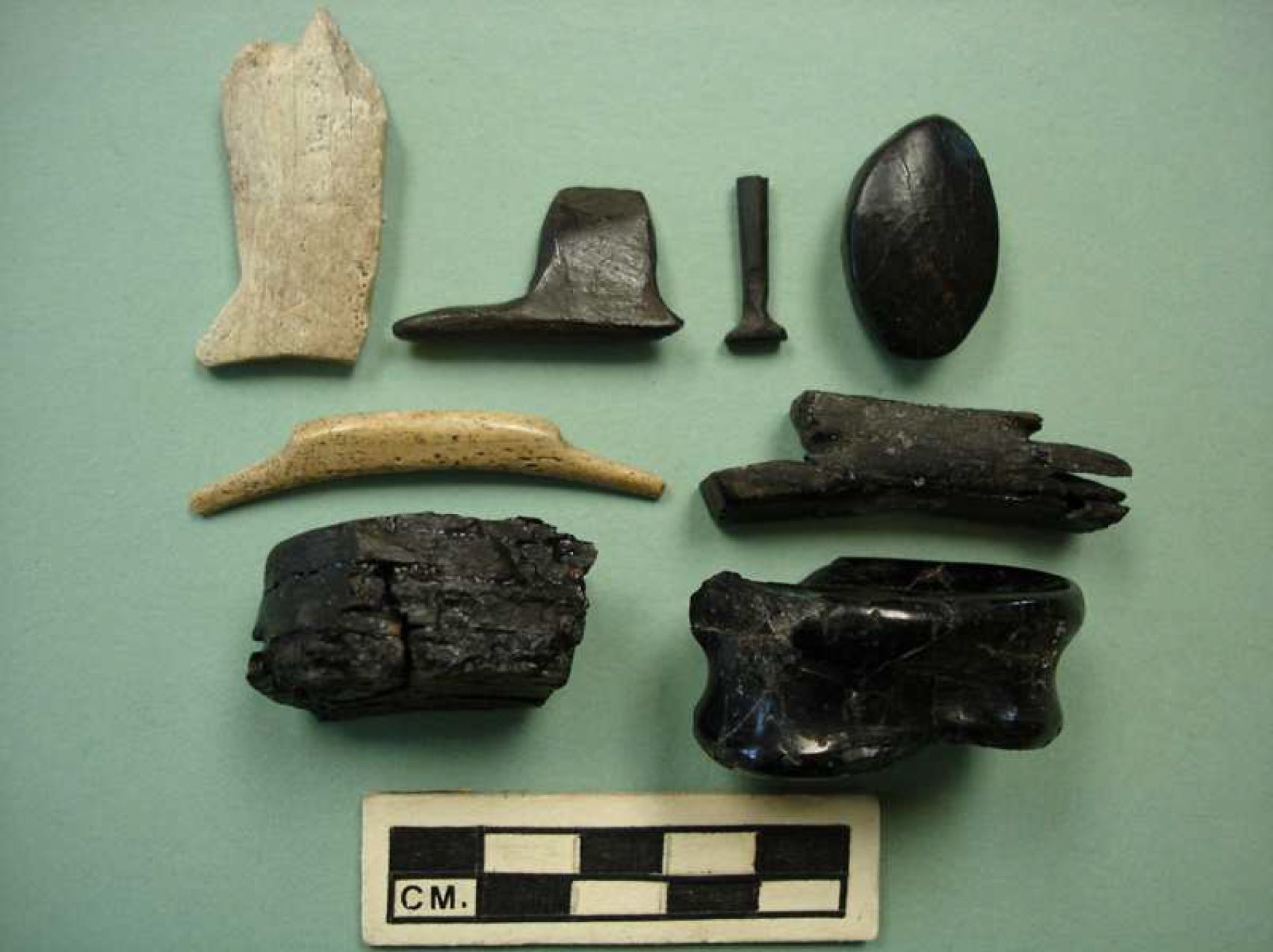
DgRw4:365. False Narrows, Gabriola Island. Lateral flange with extended body. Bone. One broken off flange and distal end broken. Portion of hole at distal end suggests a bifurcated end or an end that circled around a small hole. There is a small incomplete X-shape carved on the proximal end of the dorsal surface of the body. Body: L. [40mm]; W. [17.5mm]; H. 5.9mm. Flange: W. (17.5mm) original c. 23mm; H. 4.1mm. Weight: 3 grams. DgRx5:36. Jack point (near Duke Point). Bone. Lateral flange with short body. Flange broken off from one side. Body: L. 17.2mm; W. 14mm; H. 4.8mm. Flange: W. (32mm) Original c.42mm; H. 6mm. Weight: 1.8 grams. From test pit 10 in Area A, 63cm below surface. Reference: Murray 1982.
DgRx5:1482. Jack Point (near Duke Point).Unfinished circular flange labret or labret inlay. Lignite coal. Fracture fissures on surface. Oval shaped. Body: W. 27mm; H. 17mm. Weight: 3.4 grams. Recessed on proximal side. Reference: Analysis of artifacts from Four Duke Point Area Sites, Near Nanaimo, B.C. : An Example of Cultural Continuity in the Southern Gulf of Georgia Region. National Museum of Man Mercury Series. Archaeological Survey of Canada Paper No. 113. Rebecca Anne Murray, 1982. Component II, Area A. Fig. 25, p.199. Note: Re-dating of Component II of this site to a much earlier time period, suggests that a late date of around A.D. 910 attributed to artifacts in Area A of the site is wrong.
DgRx5B-1177. Duke Point. Lateral flange with extended body. Small labret with round thin body. 3mm deep drilled hole in distal end of body. Black slate. Body: L. 18.4mm; W. 3.8mm; Th. 3.5mm. Flange: W. 7mm, H.3.4mm. Weight: 0.5 grams. Excavated lower levels of unit 296. Fig. 20b, p. 162. Reference; Murray 1982.
DhRx6:1189. Newcastle Island. Bone. Lateral flange with flat body. The end of the flanges curve down 4mm from the centre of the body. Body: L. 6.4mm, W. 29mm; H. 5mm. Flange: W. 50mm; H. 5mm. Weight: 1.5 grams. Notes: Permit Report. Systematic Excavations – Zone 1, N88.54, E 84.39, 70cm below surface. Pre 2000 B.P. assemblage. [Old acc. 71-63].
DhRx16:2773. Departure Bay. Circular flange labret. Raw Material: Lignite coal. Tooth cord attachment hole on left lower side extending from proximal surface to side. The labret has been chemically treated due to many fractures which have damaged it on most sides. The proximal surface with the cord attachment hole appears to have been flat. The edges of what was once the larger rim on the distal surface if missing. Body: L. 11.5, Distal rim: W. [32mm], H. [25mm]; Proximal: W. [32mm], H. [22mm]. Weight: 11.0 grams. Collected by John Sendey from disturbed deposits.
DiSc26:1. Qualicum Beach. Lignite coal. Circular flange with tooth cord attachment hole on right lower side extending from proximal surface to side. Longer distal portion is partly broken off. L. 18mm. Outer surface: W. (40mm) (original c.42mm), H. 28.5mm; Inner surface: W. 38mm, H. 27mm. Weight [15.5] grams. Notes: [acc. # 72-137; previously DiSc1:7]. Collected by D. Rickard from disturbed surface at golf course.
DkSf26:894. Comox area. Lateral flange labret. Rectangular flange with part of one end and distal surface missing. Fragmented. 2mm deep flat bottomed groove on dorsal surface that expands distally from 6mm to 10mm. Body: L. [12mm], W. [27.5mm], H. 10mm. Flange: W. 45mm, H. 11.5mm. Raw Material: Lignite coal. Weight: 5.6 grams. Notes: Systematic excavation, Zone II. Corrected radio-carbon dates for Zone II span period 317-+173BC (SFU114) to 1012-+270BC (SFU124). (Donald Mitchell, 1988, fig.7j, referred to as “miscellaneous coal object”. The J. Puddleduck site: a northern Strait of Georgia Locarno Beach component and its predecessor.
Contributions to Human History No.2, Royal B.C. Museum, Victoria B.C.).
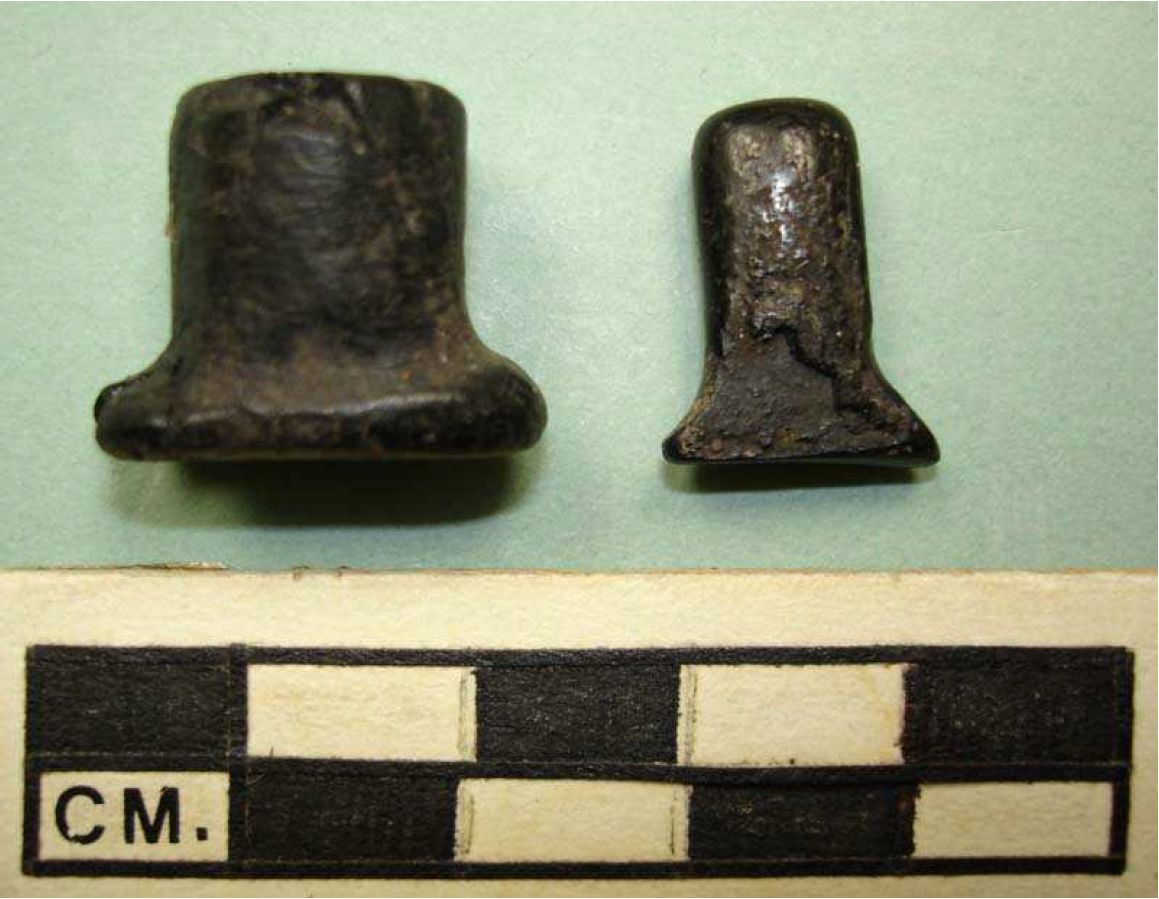
DiSe7:2247. Deep Bay (North of Qualicum Bay). Lateral Flange short body labret. Body: L. 15.8mm, W. 12.8mm, H. 12.4. Flange: W. 19.4mm, H. 11mm. Small pieces missing from one flange end and distal part of body. Lignite coal. Weight; 2.8 grams. Notes: From disturbed surface. Permit 2003-071, I.R. Wilson Consultants LTD.
DiSe7:2247. Deep Bay (North of Qualicum Bay). Lateral Flange short body labret. Body: L. 16.2mm, W. 7.6mm, H. 5.4mm. Flange: W. 12.6mm, H. 4.3mm. Lignite coal. Weight; 0.83 grams. Notes: From disturbed surface. Permit 2003-071, I.R. Wilson Consultants LTD.
Gulf Islands
Saturna Island
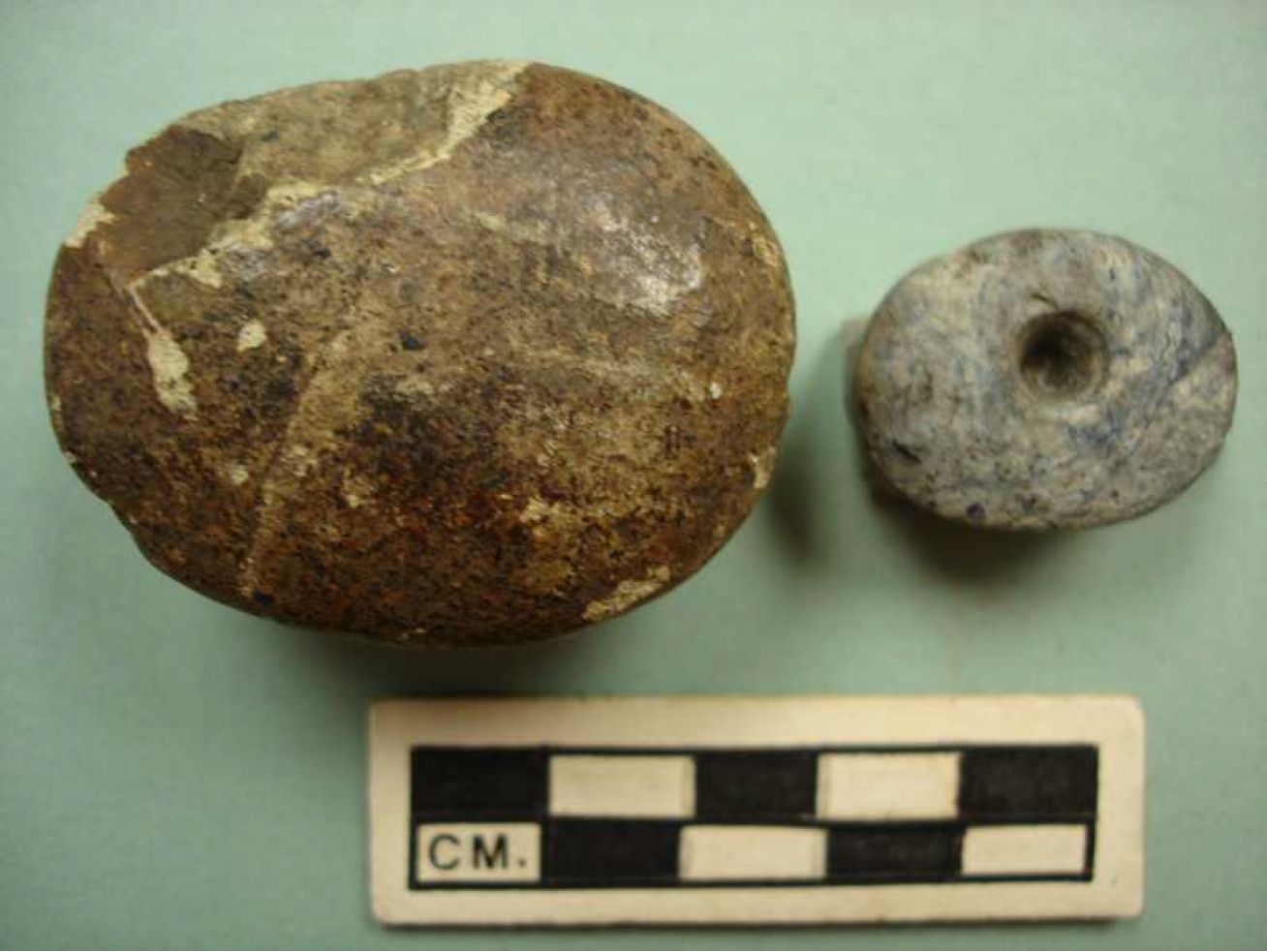
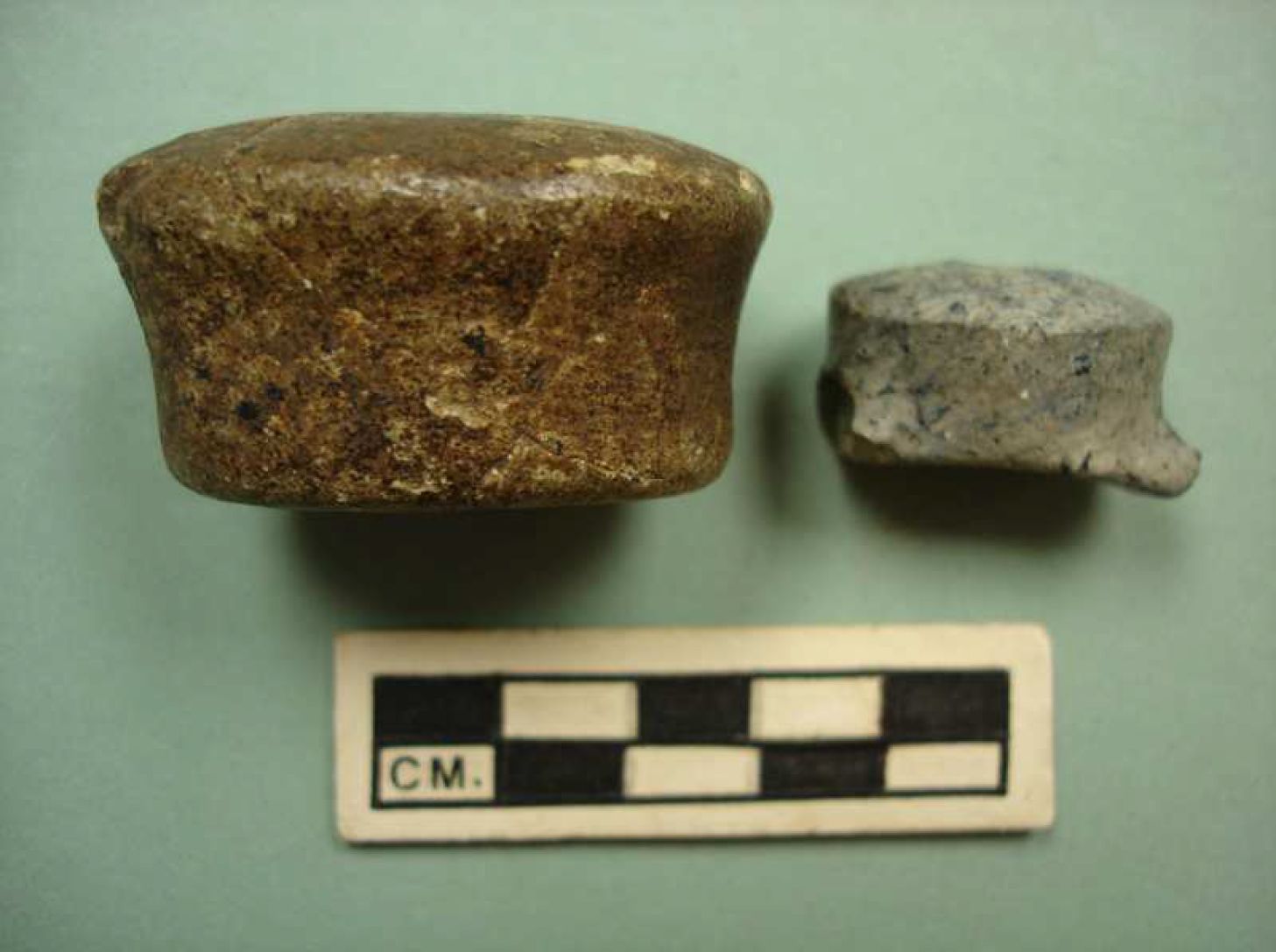
DeRs1:25. Saturna Island. N of Taylor Point. Raw material: nephrite. Lateral Flange short body labret. Both flanges broken off. Hole in centre of distal surface of body for inlay: 6mm diameter, depth 7mm. Body: L. 14.8, W. 26mm, H. 20.1mm; Flange: W. [29mm], H. 15.6mm. Weight: 11.1 grams. Notes: [accession 67-49].
DeRst-Y:11. Saturna Island. Stone. Circular flange labret. No tooth cord attachment hole. Possibly an unfinished labret. Body: L. 25mm. At centre of constriction between flanges: W. 39mm; H. 31.5mm. Larger outer flange: W. 44.5mm; H. 35.8mm; Inner rim: W. 38.2mm; H. 30mm. Weight: 51.9 grams. Notes: [Old RBCM number “4875”; formerly DeRt-Y:5; Donated by E.B. Reid in 1936].
PENDER ISLAND

DeRt-Y:38. Lateral flange extended body labret. Steatite-like stone. Body has slight taper toward distal end. Body: L. 21mm, W. 7.3mm, H. 6mm. Flange: W. 14mm, H. 5.9mm. Weight: 2.1 grams. Notes: Herbert Spaulding # 222 – found 1923. “From Pender Canal on beach” – most likely from DeRt2.
DeRt-Y:40. Pender Island. Lateral flange short body labret. Split vertically in half through body and flange. Concave distal surface. Body: L. 15mm, W. [11.8mm], H. [6mm]; Flange: W. [18.4mm], H. [5.2]. Weight: [1.5]. Notes: Herb Spaulding collection #224 – found 1924.
DeRt-Y:66. Circular flange angled labret. This is likely one of a pair of lateral labrets. The proximal and distal ends are weathered more than the middle. The curved proximal end would fit opposite the molar teeth and a double pointed and curved surface would extend outside the lip. Small pieces are broken off of each side of one end. One end is 30mm wide and 13mm high, and the other [28mm] wide and 14mm high. The mid body width is 28.5mm and height 14.1mm. Weight: 15.5 grams. Notes: Herb Spaulding collection #56
DeRt-Y:70. Pender Island. Labret flange with two holes for body extension pieces. Raw material: steatite-like. L. 11.2mm (at centre), H. 10.2mm (at centre). W. 46.5mm, Hole diameters: 6.5mm. Width between holes: Distal 20mm, Proximal: 18.2mm. Weight: 8.3 grams. Notes: Herb Spaulding collection # 260.
DeRt2:9. Pender Island. Labret flange with two holes for body extension pieces. Portion of one end missing. Raw material: Steatite-like. L. 14.8mm (at centre), H. 12mm (at centre). W. [39mm], original c. 54mm. Hole diameter: 6.2mm. Width between holes: Distal:19mm, Proximal: 15mm. Weight: [11.8] grams. Provincial Museum excavation of Michael Kew and Wilson Duff July 22-25, 1957. Test Pit No. 1, field # 26. [old cat. #8583].
DeRt19-104. (now part of site DeRt2). Pender Island. Lateral flange, short body. Raw material: Nephrite-like. Body: L. 11.4mm, W. 19mm; H. 19.5mm. Flange: W. 27mm; H.19mm. Weight: 8.1 grams. Notes: This site is now part of DeRt2. Originally separated by the artificial Pender canal. Surface collected. From collection of Herbert Albert Spaulding.
DeRt2:168. Pender Island. Circular flange labret with tooth cord attachment hole penetrating on the right corner from the proximal surface to the side. L. 9.5mm. Outer or distal Rim: W. 29.4mm, H. 18.4mm; Inner Rim: W. 27.5mm; H. 17.5mm. Tooth cord attachment hole outer concavity 4mm and inner 3.5mm. Weight: 8.3 grams. Herbert Spaulding collection # 22.
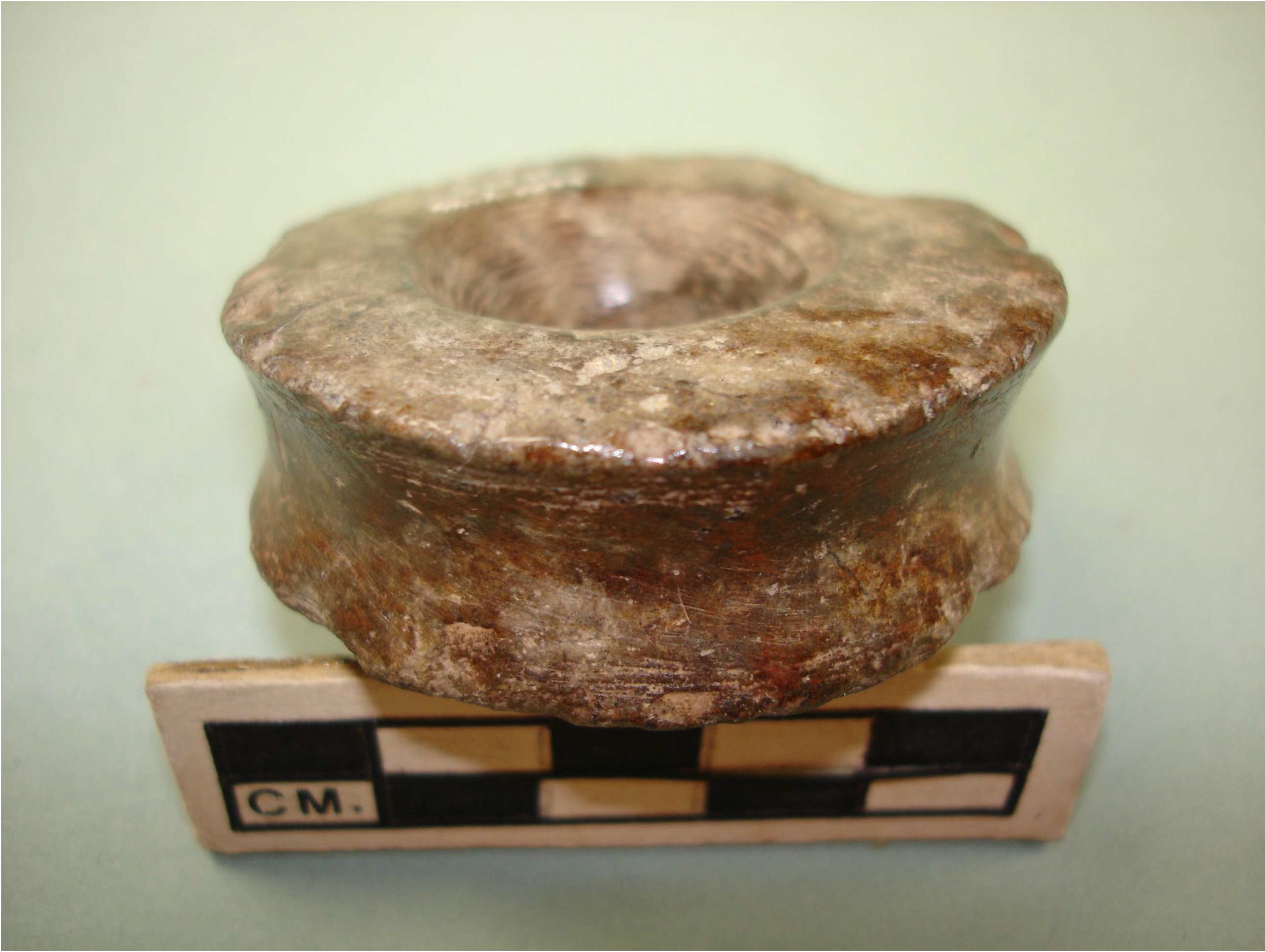
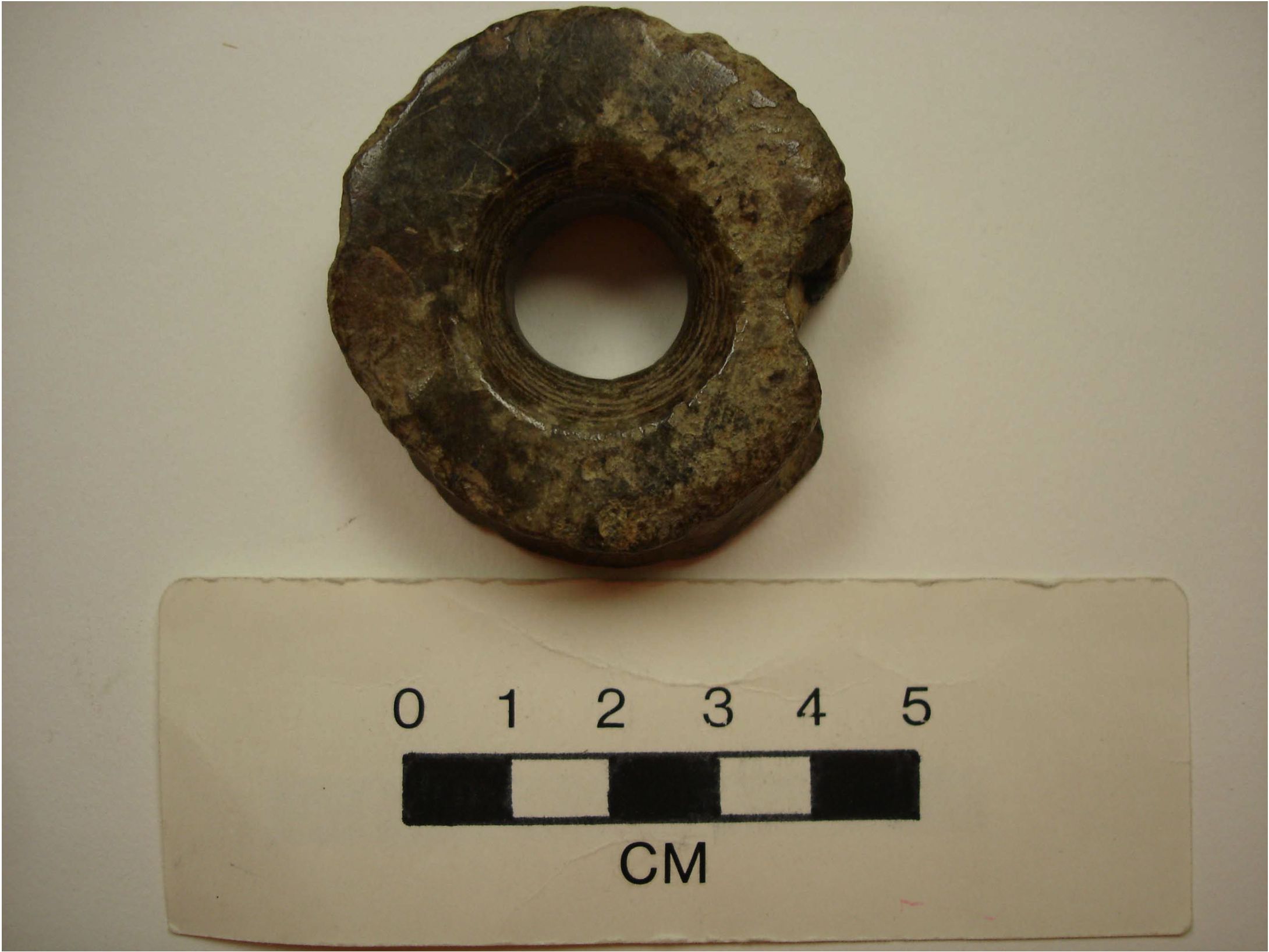
DeRt-Y:46. Pender Island. Ear spool or circular flange labret. Raw material: Steatite-like. L. 17.9mm. Out rim: W. 52mm. Inner rim: L. 50mm. Diameter of central hole opening on outer surface 27mm and inner surface 25mm. Innermost hole diameter 15mm. Weight: 53.6 grams. Notes: Found in 1915. H.A. Spalding collection #231. “Found in Spaulding Valley (between barn and peat field)”.
Poets Cove, Bedwell Harbour
There are 26 labrets or parts of labrets from the Poets Cove site in Bedwell Harbour. Although the site has dates covering the period of 510-680 B.P. and 33700-3700 B.P. from undisturbed column samples, all of the labrets were screened or surface collected from disturbed contexts. Reference: Archaeological Studies. DeRt4, Poets Cove at Bedwell Harbour. Pender Island, B.C. Permit 2002-388. I. R. Wilson Consultants Ltd.
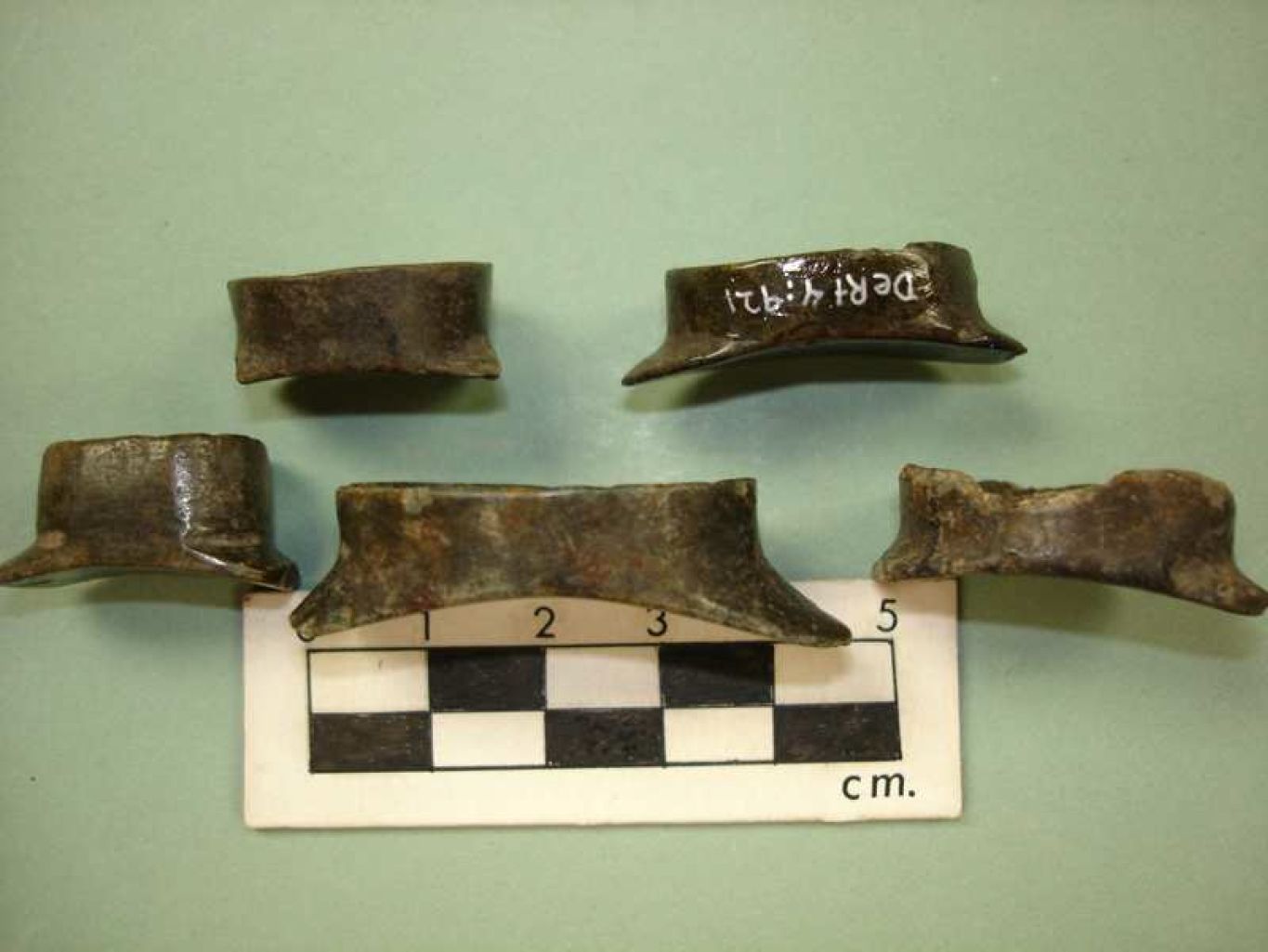
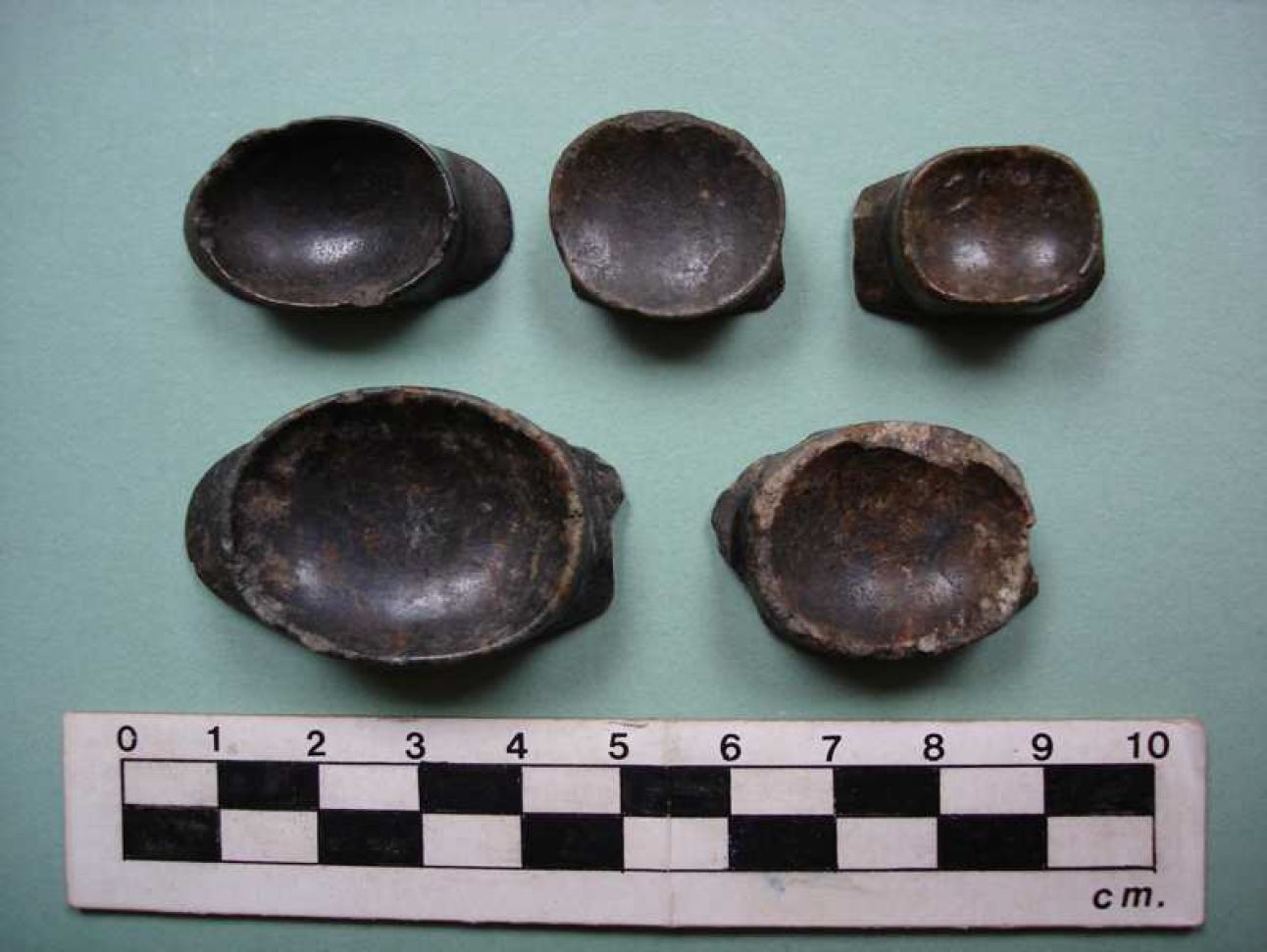

DeRt4:749. Poets Cove, Bedwell Harbour. Lateral flange short body. Raw Material: Stone (nephrite-like). Holes (3mm) drilled at the edge of body on two sides are for the re-attachment of broken flanges. Ragged broken edges suggest that the item was not reused as it is. Body: Distal surface concave to 3mm. Slight outward height flare toward distal surface. W. 21.8mm, H. 19.1mm. Flange: W. [22mm], H. 17.7mm. Weight: [5.1] grams.
DeRt4:921. Poets Cove, Bedwell Harbour. Lateral flange short body. Raw Material: Stone (nephrite-like). Maximum length: 8mm. Body: Slight height expansion of body toward distal end. W. 25mm, H. 18mm. Concave surface 4mm deep. Flange: W. 33mm, H 22mm. Weight: 4.4 grams.
DeRt4:918. Poets Cove, Bedwell Harbour. Lateral flange short body. Raw Material: Stone (nephrite-like). Maximum length: 11mm. Body: W. 18.3mm, H. 14.9mm. Distal surface concave to 2mm. Flange: Flanges on both sides of the body have been broken and re-ground to square them off. Original flanges would be more tapered to a round point. W. 24mm, H. 15.2mm. Weight: 5.9 grams.
DeRt4:1000. Poets Cove, Bedwell Harbour. Lateral flange short body. Raw Material: Stone (nephrite-like). Maximum length: 8.2mm. Body: W. 33mm. H. 25mm. The body height expands out slightly to the distal end. The body surface is concave to a depth of 5mm. Flange: One end of flange broken off. Width: [43mm], original about 49mm. Height: 24.6mm. Weight: 10.5 grams.
DeRt4:1010. Poets Cove, Bedwell Harbour. Lateral flange short body. Raw Material: Stone (nephrite-like). Maximum length: 7mm. Body: Surface concave to depth of 4mm. W. 26mm. H. 21.5. Flange: Broken at ends. W. [31mm], H. 22mm. Weight: 5.8 grams.
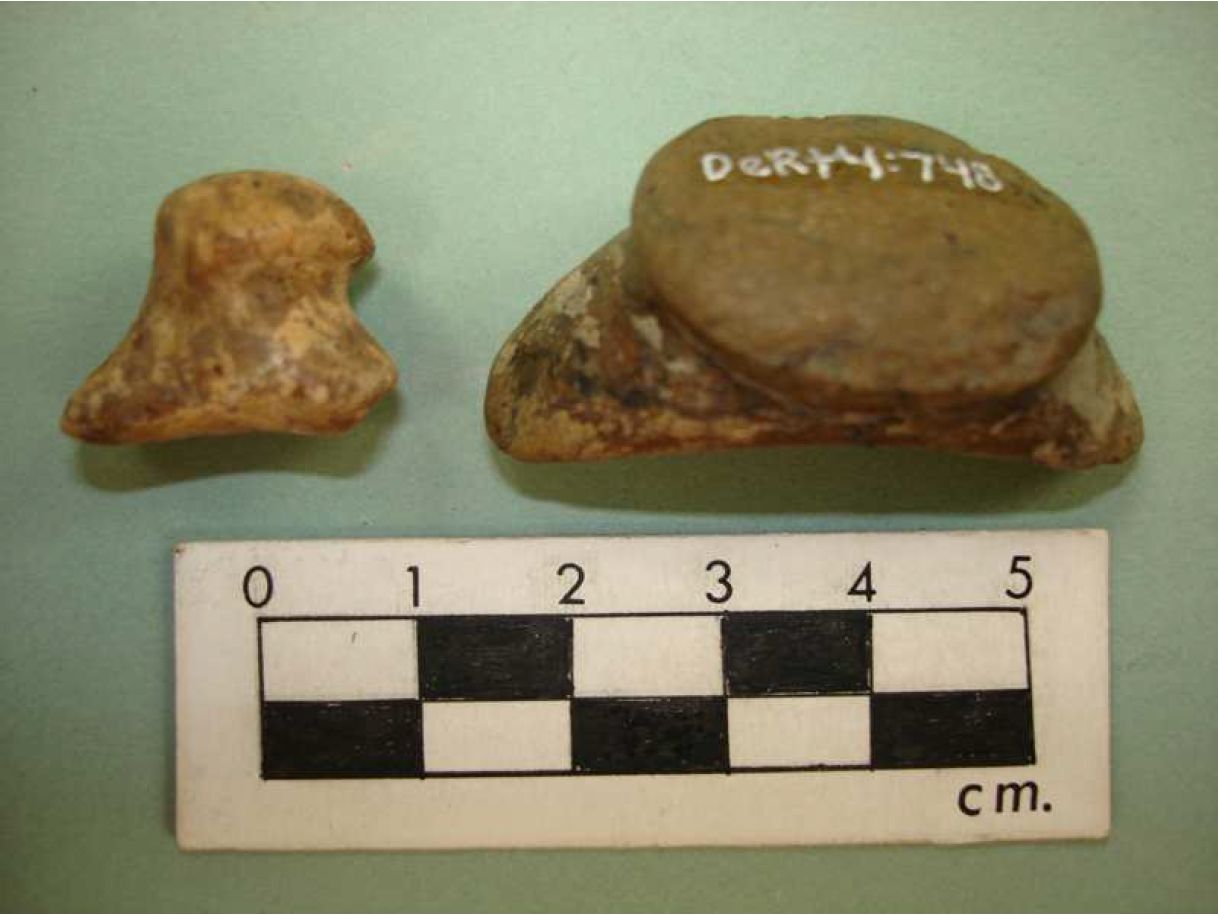
DeRt4:748. Poets Cove, Bedwell Harbour. Lateral flange short body labret. This may be one separate part of a set of lateral labrets that were tied together. This assumption is based on its asymmetry and a small 1.5mm hole at the centre of one of the flanges. A low rounded body is distinct on broad flanges that have a curvature that extends to a distance of 7mm below the centre of the body. Body: L. 7mm, W. 27.2mm, H. 22.5mm. Flange: L. 7mm, W. 42.5mm, H. 21.6. Cord attachment hole opening on proximal side is 5mm, but hole to through to distal side is 1.5mm. Weight: 16 grams.
DeRt4:701. Poets Cove, Bedwell Harbour. End portion of double body labret. One broken and weathered end and asymmetry of the rounded body suggest this is one end of a double lateral labret. Material: Limestone-like. Maximum height at high end 16.3mm. Body: L. 9mm, W. 13.5. Flange: W. [21mm]; H. 6.5mm. Weight: [4.7] grams.
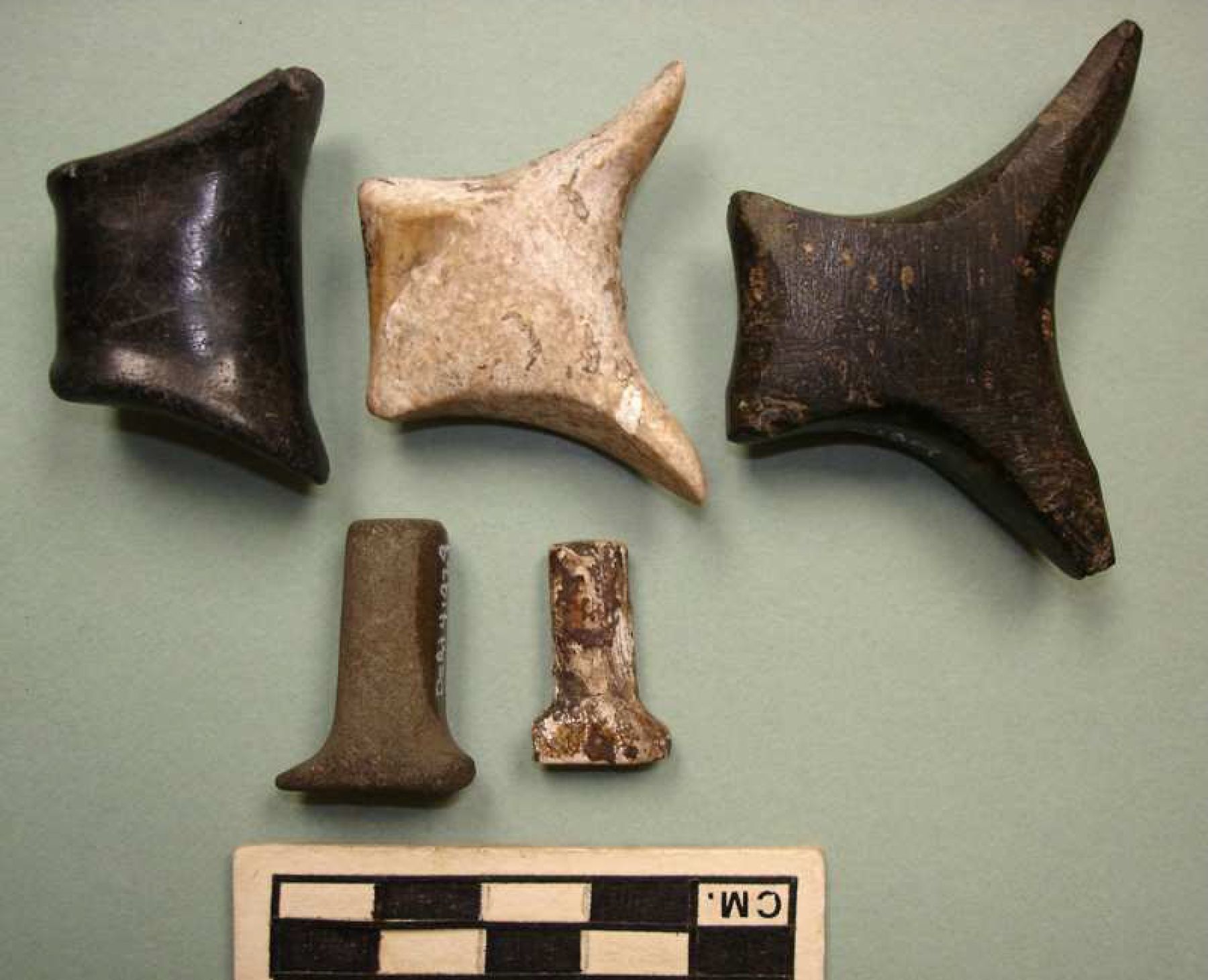
DeRt4:723. Poets Cove, Bedwell Harbour. Circular flange angled labret. This is likely one of a pair of lateral labrets. The proximal and distal ends are weathered more than the middle. The curved proximal end would fit opposite the molar teeth and a pointed and curved surface would extend outside the below the lip. Both surfaces with rims are 25mm wide and 16mm high. The length is 37mm on one side and 21mm on the other. The mid body width is 22mm and height 15.mm. Weight: 17.3 grams.
DeRt4:2514. Poets Cove, Bedwell Harbour. Circular flange angled labret. This is likely one of a pair of lateral labrets. The proximal and distal ends are weathered more than the middle. The curved proximal end would fit opposite the molar teeth and a pointed and curved surface would extend below the lip. Both surfaces are 31mm wide and 11mm high. The length is 39.5mm on one side and 22mm on the other. The mid body width is 23.1mm and height 12.1mm. Material: Purple hinge scallop. Weight: 14.4 grams.
DeRt4:869. Poets Cove, Bedwell Harbour. Circular flange angled labret. This is likely one of a pair of lateral labrets. The proximal and distal ends are weathered more than the middle. The curved proximal end would fit opposite the molar teeth and a pointed and curved surface would extend outside the cheek. This appears to be a nearly finished example that was not used. Extensive shaping marks cover all surfaces. The end of one surface is broken off. One surface is 41mm wide and 12.2mm high and the other missing one end is 35mm wide and 11.5mm high. The mid body width: 29mm and height 12.5mm. Material: Steatite-like. Weight: 20.4 grams.
DeRt4:929. Poets Cove, Bedwell Harbour. Lateral flange, extended straight rounded body. One end of flange broken off. Total length: Body: L. 25mm; W. 10; H. 10.5. Flange: W.[18.2mm]; H. 11mm. Weight: 5.6 grams.
DeRt4:2493. Poets Cove, Bedwell Harbour. Lateral flange, extended straight oval body. Piece of flange missing from one end. Body: L. 21mm; W. 7.9mm; H. 6mm. Flange: W. [13mm]; H. 6mm. Material: Purple hinge scallop. Weight: 1.9 grams.

DeRt4:620. Poets Cove, Bedwell Harbour. Circular flange labret – 40% missing. Both surfaces are deeply concave with a thin 1.3mm centre between. Raw material: Stone (Steatite-like). Maximum L. 11.6mm. Body: W. [25mm]; H. [22mm]. Weight: [4] grams.
DeRt4:659. Poets Cove, Bedwell Harbour. Circular flange labret with cord tie hole on bottom right side. Distal surface is concave to 2mm. Proximal surface is slightly convex with many tooth scratch patterns. Wear chipping around distal edge. Maximum L. 13mm. Body: W. 35mm; H. 33.2mm. Raw Material: steatite-like. Weight: 14.4 grams.
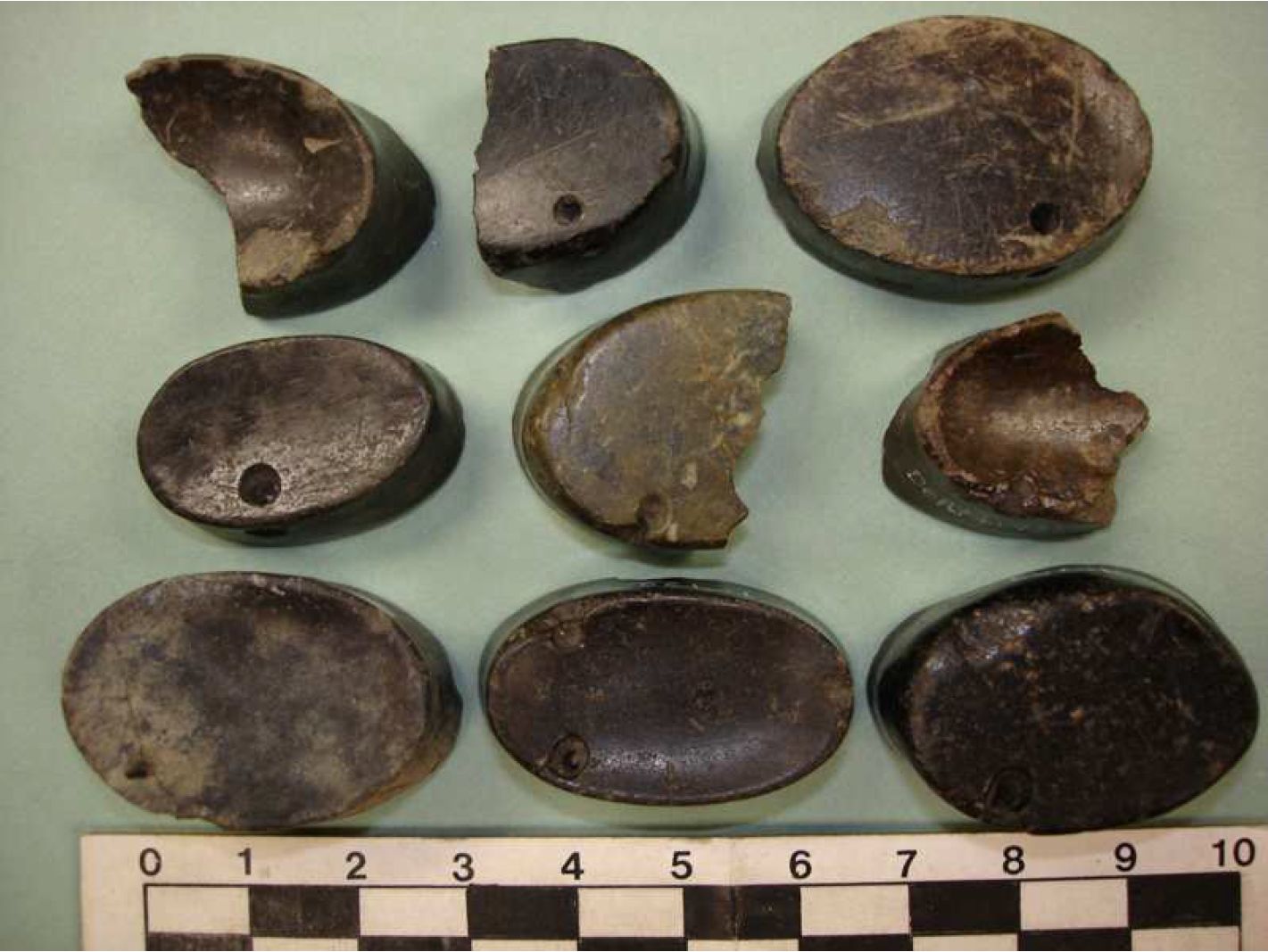
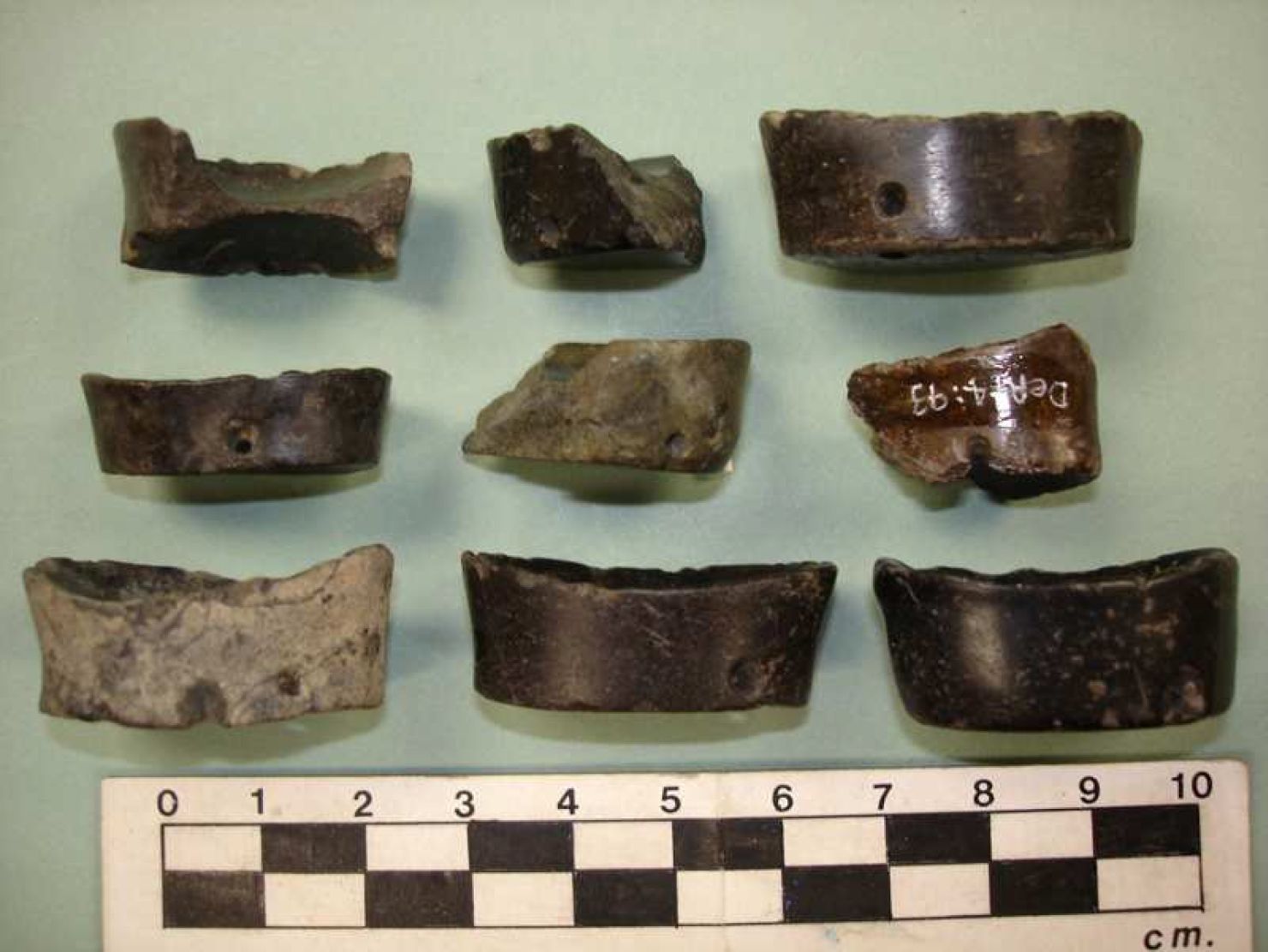
DeRt4:949. Poets Cove, Bedwell Harbour. Circular flange labret with cord tie hole on bottom right side. About 50% missing. Distal surface is concave to 2mm. Proximal surface is slightly concave. Tooth cord attachment hole on right lower side extending from proximal surface to side. Tooth scratching on proximal surface and wear chipping around edge of distal surface. Maximum L. [11] mm. Body: W. [19] mm: H. [22] mm. Raw material: Stone (steatite-like). Weight: [6.5] grams.
DeRt4:938. Poets Cove, Bedwell Harbour. Circular flange labret with cord tie hole on bottom left side. Distal surface is concave to 3mm. Proximal surface is concave to 1mm. Tooth wear chipping around distal edge. Tooth cord attachment hole was originally on right lower side extending from proximal surface to side, but this broke through and was then drilled across on the other side. Maximum L. 12mm. Body: W. 34mm; H. 20mm. Raw Material: Stone (steatite-like). Weight: 10.4 grams.
DeRt4:93. Poets Cove, Bedwell Harbour. Circular flange labret with cord tie hole toward bottom left side, but more centered than most examples. Distal surface is concave to 2.5mm. Proximal surface is concave to 1mm. Tooth wear chipping around distal edge and tooth scratching on proximal surface. Maximum L. 9mm. Body: W. 29mm; H. 17.9mm. Raw Material: Stone (steatite like). Weight: 6.4 grams.
DeRt4:872. Poets Cove, Bedwell Harbour. Circular flange labret with about 40% missing. The bridge on the cord tie hole on left bottom is broken through. Distal surface concave to 2.5mm. Proximal surface flat with tooth abrasion scratches. Maximum L. [11.8] mm. Body: W. [25] mm; H. [23] mm. Weight: [7.2] grams.
DeRt4:951. Poets Cove, Bedwell Harbour. Circular flange labret with cord tie hole toward bottom left side. Distal surface concave to 3mm and proximal surface to 1mm. Tooth scratching on proximal surface and edge wear chipping on distal rim. Small piece of distal rim missing. Maximum L. 14mm. Body: W. 33mm; H. 22mm. Raw Material: Stone (steatite-like). Weight: 11.3 grams.
DeRt4:709. Poets Cove, Bedwell Harbour. Circular flange labret with cord tie hole on bottom left side. Distal surface is concave to 2.5mm. Proximal surface is flat. Tooth wear chipping around distal edge and tooth scratching on proximal surface. Maximum L. 14.3 mm. Body: W. 33mm; H. 22mm. Raw Material: Stone (steatite-like). Weight: 14.2 grams.
DeRt4:913. Poets Cove, Bedwell Harbour. Circular flange labret with about 55% missing. The bridge on the cord tie hole on left bottom is broken through. Distal surface concave to 3mm and proximal surface to 2.5mm. Body thins to 4.2mm at centre. Maximum L. [13] mm. Body: W. [22.5] mm; H. [17.5] mm. Raw Material: Stone (steatite-like). Weight: [3.7] grams.
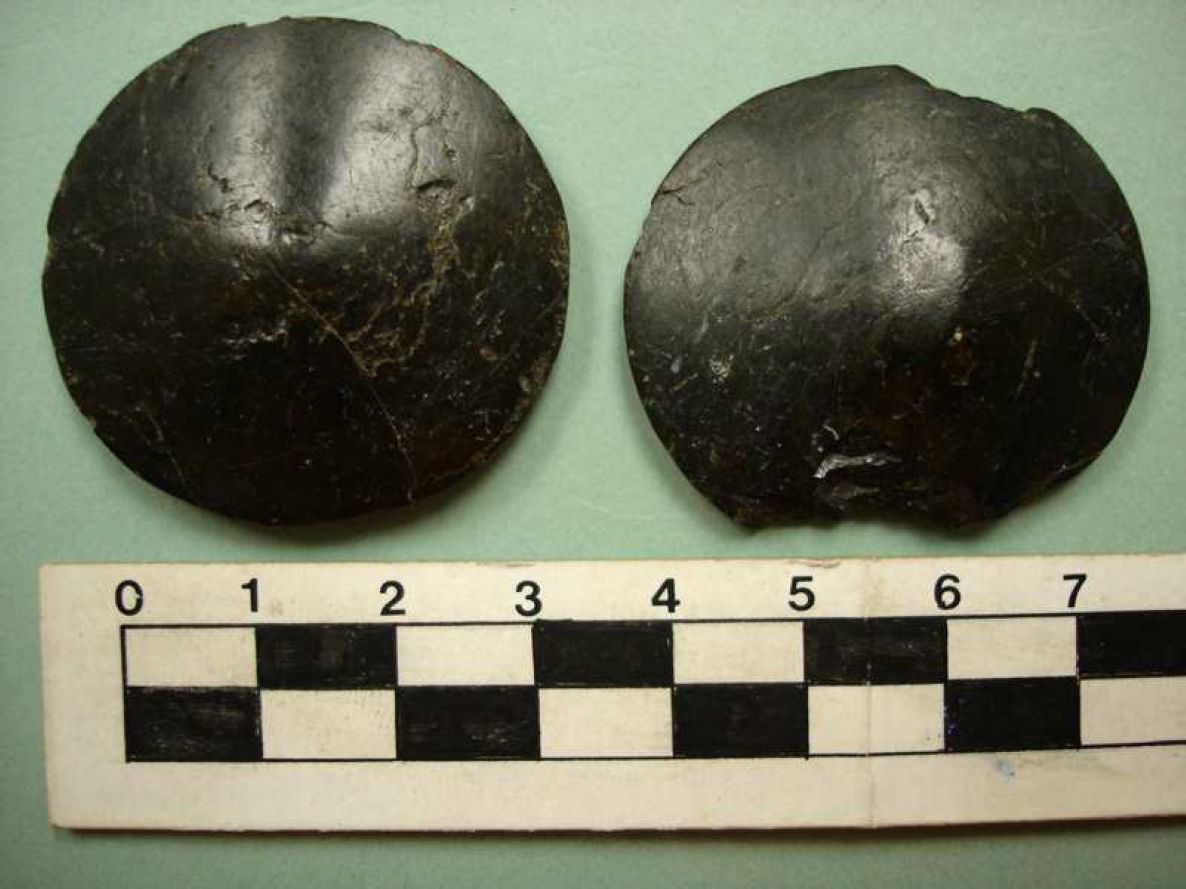
DeRt4:720. Poets Cove, Bedwell Harbour. This is likely a labret insetthat fit into a circular bone of wood labret. It is flat on the proximal surface and slightly conical on the distal surface. The surfaces show similar scratch patterns to those found on the surfaces of labrets. Possibly a matching pair with DeRt 4: 873. Diameter: 38mm. Thickness: 5mm at rim to 9mm at centre. Raw Material: Stone (steatite-like). Weight: 14.3 grams.
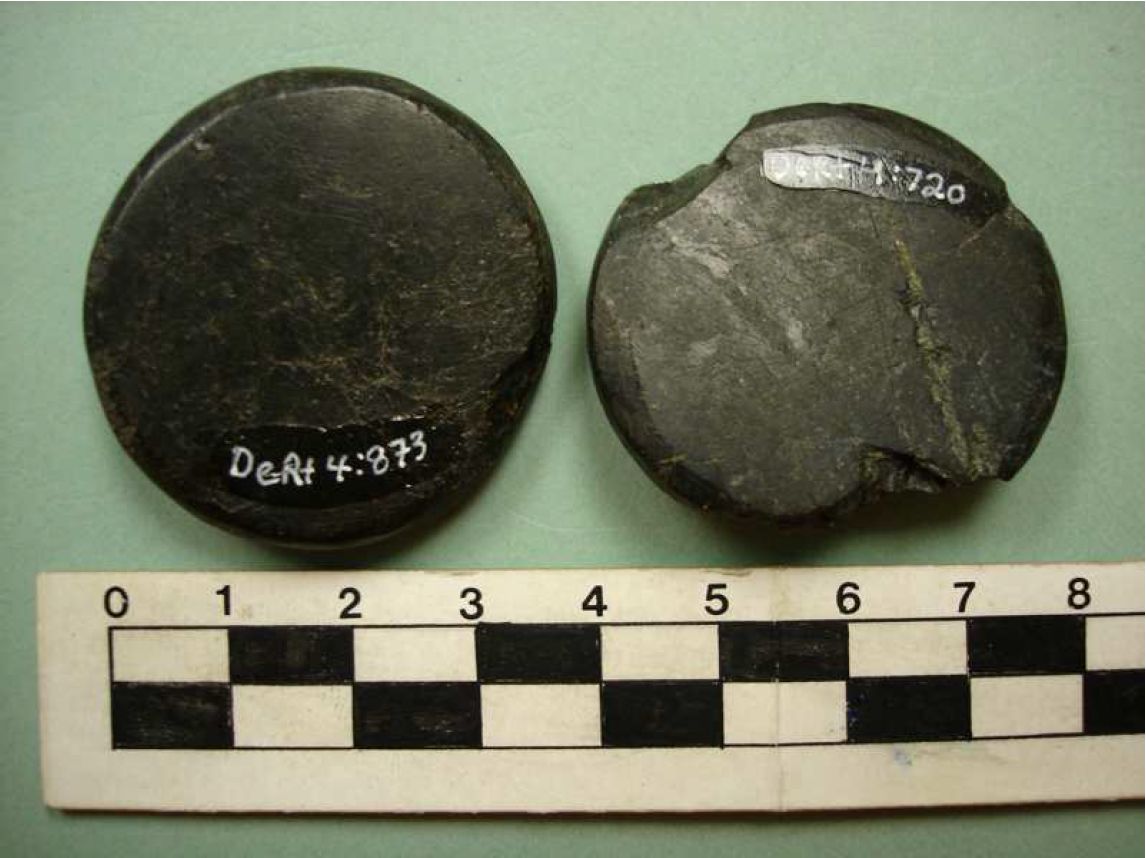
DeRt4:873. Poets Cove, Bedwell Harbour. This is likely a labret inset that fit into a circular bone of wood labret. It is flat on the proximal surface and slightly conical on the distal surface. The surfaces show similar scratch patterns to those found on the surfaces of labrets. Diameter: 38mm. Thickness: 5mm at rim to 8.5mm at centre. Possibly a matching pair with DcRt4:720. Raw Material: Stone (steatite-like). Weight: 14.1 grams.
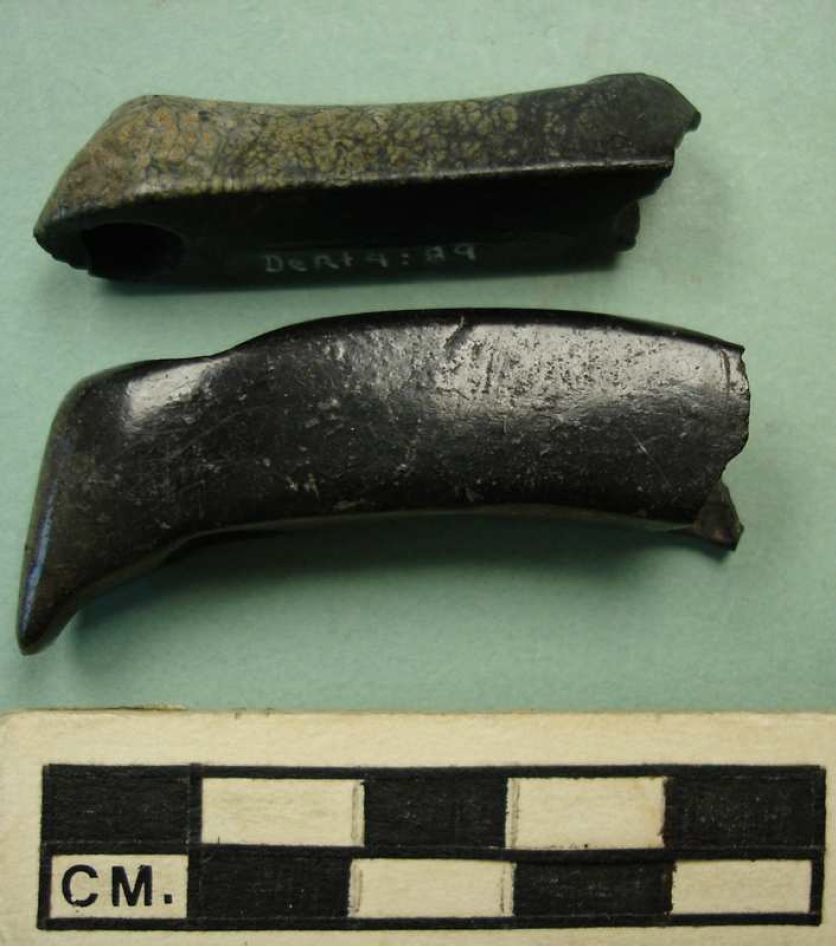
DeRt4:89. Lateral flange with two (2mm) holes for body extensions. Tooth scratch patterns on proximal surface. The distal surface has small rounded raised protrusions around the holes. A piece is broken off at one end. Maximum L. at centre 8.5mm; W. [42] mm (original c. 43mm). Material: Stone (steatite-like). Weight: 6.7 grams.
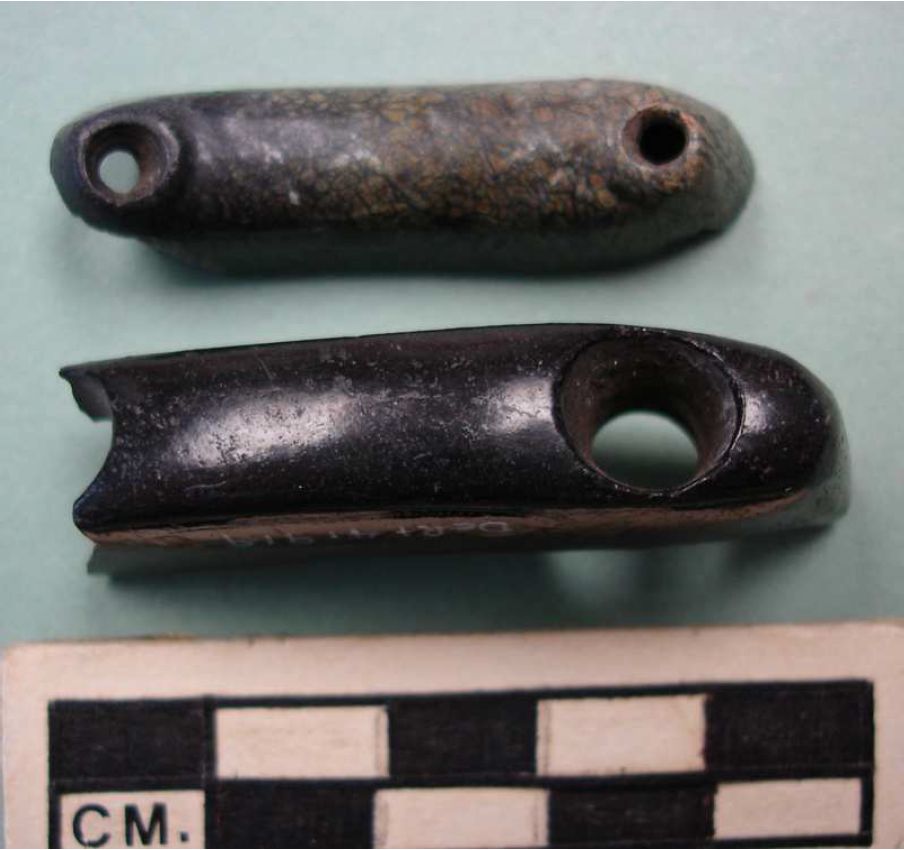
DeRt4:919. Lateral flange with two (6mm) holes for body extensions. Tooth scratch patterns on proximal surface on both flat area and on corner curve. A piece is broken off at one end. Maximum L. at centre 13.2mm; W. [46] mm (original c. 56mm); H. 10.8mm. Raw Material: Stone (steatite-like). Weight: 10.7 grams.
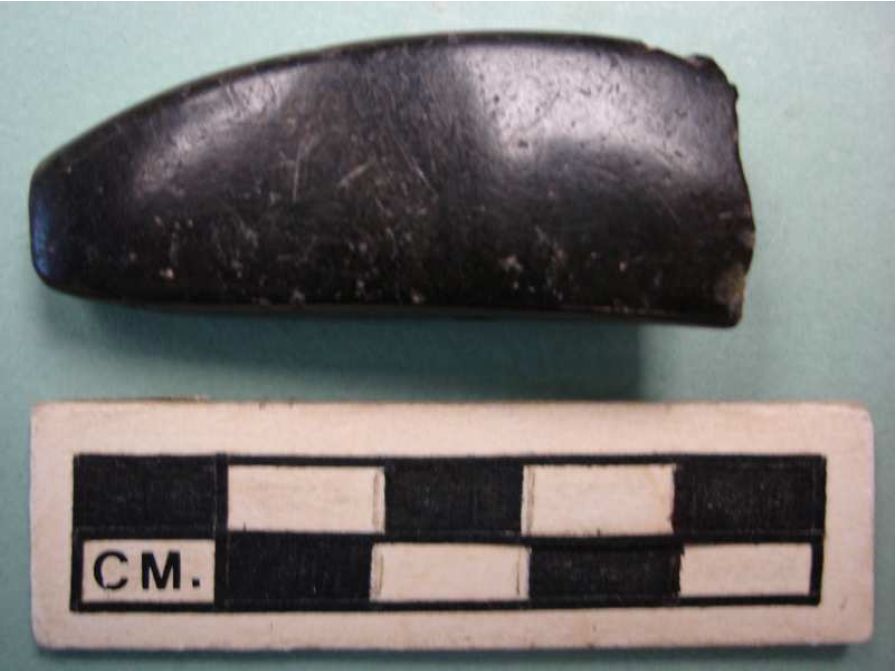

DeRt4:948. Portion of labret body with no flange. This is a flat body section with a slightly curved proximal end and long curving distal end. There is a tooth cord attachment hole at one end extending through to the short .9mm side. Another cord attachment hole is 28mm form this end. If the latter hole was at the centre, the original labret body would be c. 56mm wide. L: 17.3mm; Width: [44] mm; H: 11.3mm. Highly polished on the proximal, distal and upper surfaces. Bottom surface more roughly worked. Weight: [14.7] grams.
Mayne Island
Only two of the ten labrets from Mayne Island are from an excavated context. Both are reported in: The Archaeology of Helen Point, Mayne Island, S.F.U. Master of Arts thesis by John McMurdo, 1970, page 80.
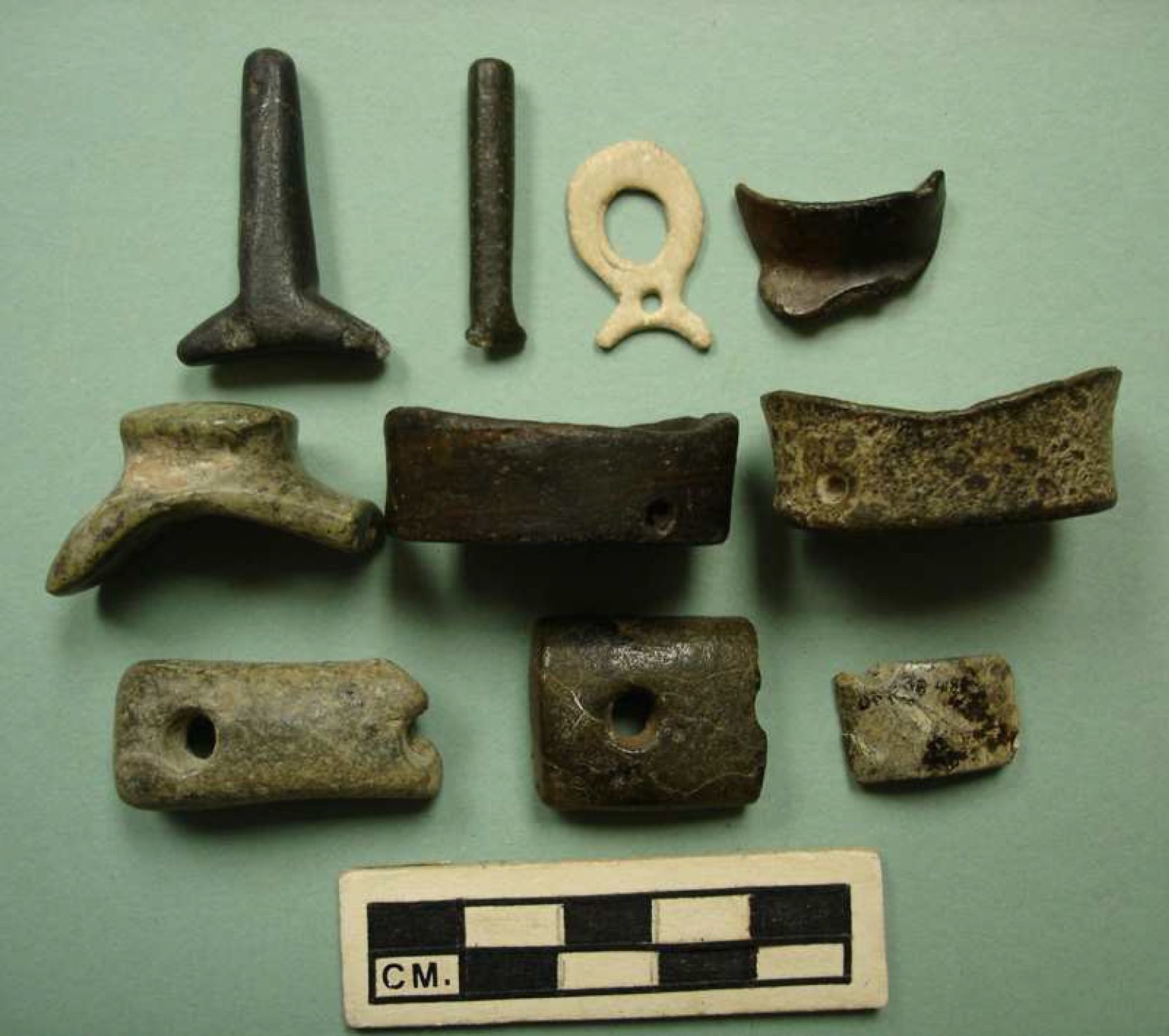
DfRu8:5. Mayne Island. Helen Point. Lateral flange thin extended body labret. One flange partly broken off. Body tapers to slightly larger end. Small 2mm dia. and 4mm deep inset hole at distal end. Total L. 30mm. Body: L. 27.1mm, W. 5mm, H. 5mm. Flange: L. 2.9mm, W. [6.4mm], original c. 7mm, H. 4.9mm. [Old #11600] Surface find. Weight: 1.5 grams.
DfRu8:1171. Mayne Island. Helen Point. Steatite-like stone. Circular flange labret. Flat proximal end with tie hole on left side. H. 11.5mm. Distal flange: W. 34.5mm, H. 23mm. Proximal flange: W. 23.5mm, H. 22.5mm. Attachment hole outer dia. 2.5mm. Weight: 15 grams. [Surface finds].
DfRu8:3560. Mayne Island. Helen Point. Fragment of lateral flange labret. Steatite-like stone. Distal surface concave. Only a small fragment of one flange present. H. [10mm], Body: L. 7mm. W. [8mm], H. [22mm]. Flange: L. [2.2mm].Weight: 1.7 grams. [acc. 68-20].
DfRu8:4341. Mayne Island. Helen Point. Flat lateral flange extended body labret. Bone. The body has an 8mm by 6.9mm hole in its centre and another small 2.5mm hole at the junction of the body and flange. Total L. from middle of flange to distal end of body: 20mm. Body: L. 16mm, W. 14mm, H. 1.9mm. Flange: L. 6mm, W. 12.2mm, H. 1.5mm. Weight: .4 grams.
DfRu8:4380. Mayne Island. Helen Point. End portion of double body labret. Nephrite. Broken near middle. Total L. 11.4mm. Body: L. 6mm, W. 17.8mm, H. 15.9mm. Flange: L. 5.4mm, W. [31mm], H. 16.2mm. Weight: 8.8 grams. [access. 68-20].
DfRu8:4380. Mayne Island. Helen Point. Section of ring shaped circular flange labret. The centre would have been set with inlays. Body: L. 12.1, W. [18.5]mm. Nephrite-like material. Weight: [1] gram.
DfRtu-Y:23 (formerly DfRuv-Y:8). Mayne Island, Active Pass. Circular flange labret with cord tie hole on bottom right side. Distal surface is concave to 4mm. Proximal surface is concave to 1mm. Chipping around thinner distal edge. Maximum L. 13mm. Body: W. 35.3mm; H. 22.6mm. Material: Stone (steatite-like). Old RBCM # 8725. Weight: 12.9 grams.
DfRtu-Y:17. Mayne Island. Active Pass. Portion of two holed labret flange. Broken through hole at one side. The distal surface is rounded and curves to a 4.5mm proximal extension. L. 10mm, W. [33.5]mm’ H. 9mm. The intact 6mm hole is 7.5mm from the side. The height increases to 15mm at the end of the side. Weight: 7.7 grams. Schist-like material. Surface collected by F.J. Barrow. Old Accessions 5241 & 1944-12, Barrow Collection #111.
DfRtu-Y:18. Mayne Island. Active Pass. Portion of two holed labret flange. Remnant of second hole at broken side. The distal surface is slightly curved with a flat end that extends proximally 4.5mm. It is wider and flatter than the similar flange DfRtu-Y17. L. [7.2]mm, W. [24]mm’ H. 20mm. The intact 6mm hole is 7mm from the side. The height increases to 19.8mm at the end of the side. Weight: 7.7 grams. Material: Possibly burnt nephrite. Weight: [6.3] grams. Surface collected by F.J. Barrow. Old Accessions 5239, Barrow Collection #109.
Galiano Island
Twenty four examples of labrets from Galiano Island are from three sites. The twelve from DfRu 24, on Active Pass, are mostly beach finds. Most were collected during a formal excavation project in 1968. Test Excavation at Georgeson Bay, British Columbia. British Columbia Provincial Museum No. 19 occasional Papers Series. 1976, James C. Haggarty and John H. W. Sendey. Associated with the earlier deposits dating c. 3200 to 2900 B.P.
Some of the ten labrets from DfRu13 Montague harbour are described (some as Gulf Island Complex artifacts) in: Archaeology of the Gulf of Georgia area, a natural region and its culture types. Sysesis. Published by the British Columbia Provincial Museum. Volume 4, Supplement 1, 1971 by Donald Mitchell. Two labrets are from house pit excavations at the Dionisio Point site at the north end of Galiano Island. Colin Grier, 1997; 1998; 2002.
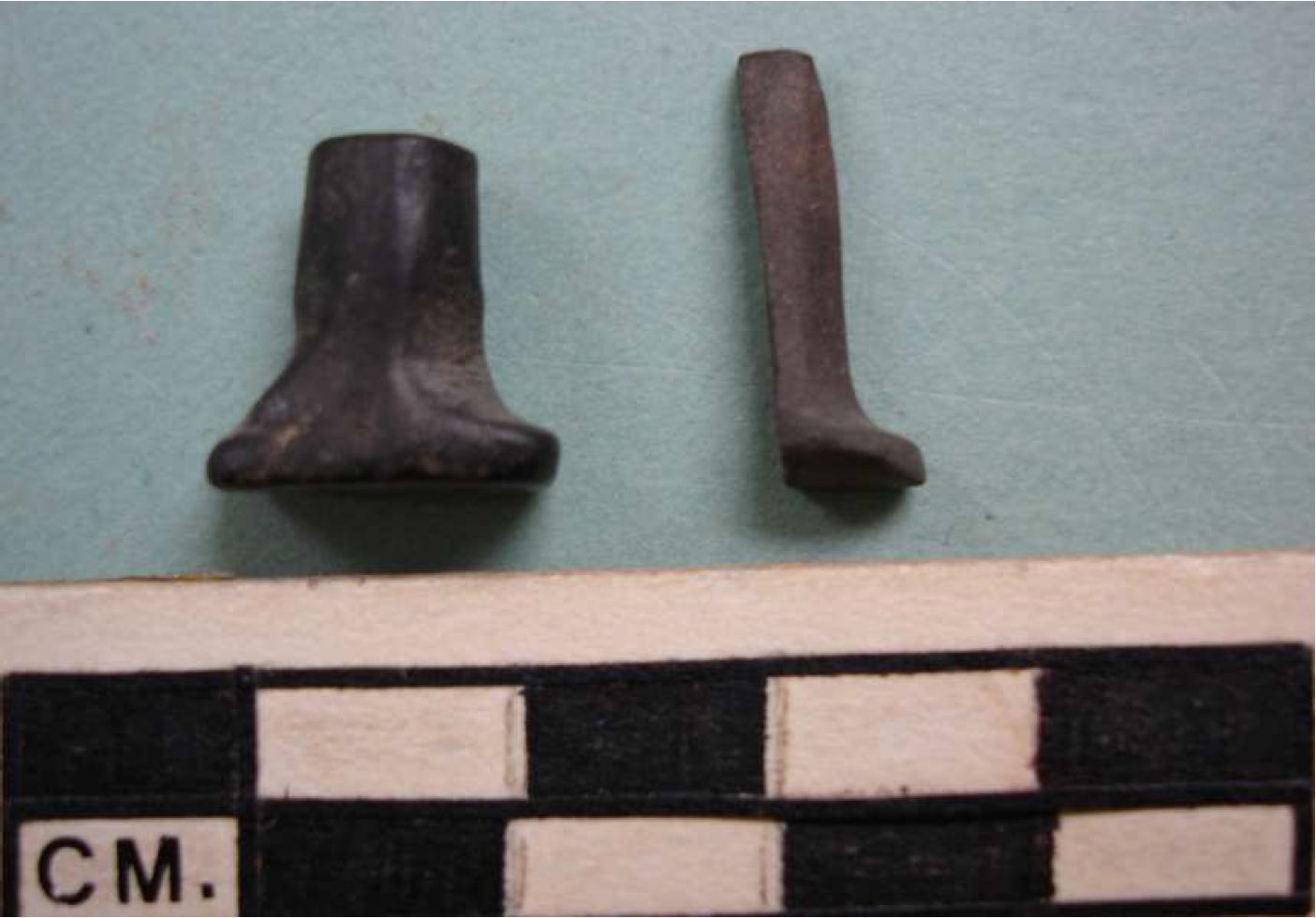
DgRv3:138. Dionisio Point. Extended body, lateral flange. Laterally split- off section missing. Body: L. 17.4mm, W. [3]mm; H. 4mm. Flange: W. [5.4]mm; H. [5.2]mm. Weight: 0.34 grams. Material: Slate-like. Unit 151N 116E. Layer C1.
DgRv3:157. Dionisio Point. Extended body, lateral flange. Cylindrical body. Body: L. 13.1mm, W. 6.7mm, H. 7.0mm. Flange: W. 8mm, H. 7mm. Material: Steatite-like. Weight: 1.56 grams. From House 2, Unit N142 E116, level C4, BD 3.36-3.41m. Found in screen.
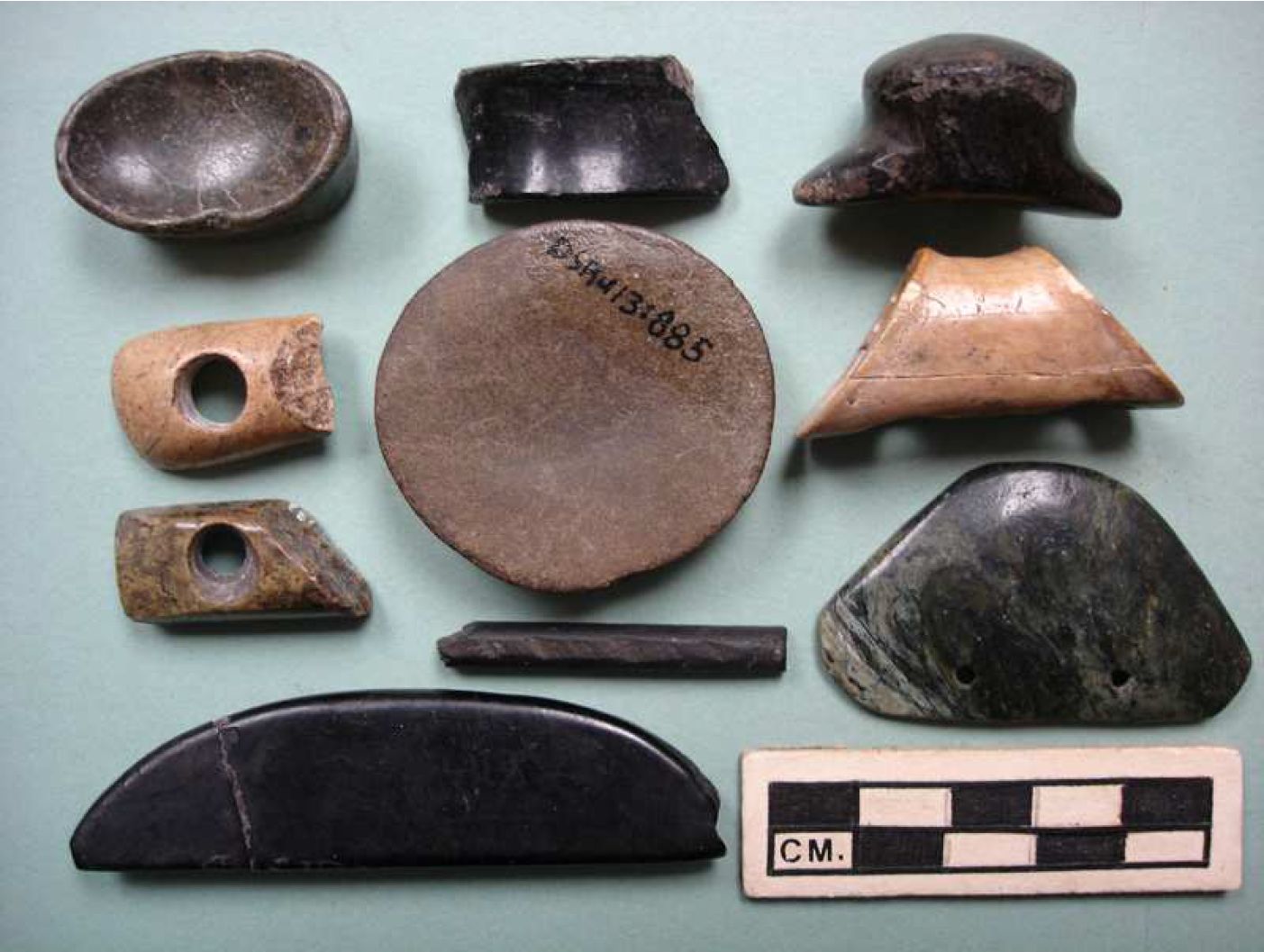

DfRtu-Y:32. Active Pass-Galiano Island. Material: Nephrite-like stone. Circular flange labret with tooth cord attachment hole penetrating on the right corner from the proximal surface to the side. Length: 10mm. Outer Rim: W. 32mm, H. 20mm; Inner Rim: W. 29.5mm, H. 18.8 Width at centre between rims: 18.6mm; Tooth cord attachment hole outer concavity 2.5mm and inner concavity 3mm. Weight 9.3 grams. Notes: (Old accession # 5506; New accession 1944-51, formerly DfRu-Y:5). (Probably from DfRu24 – surface coll. by Dick Morgan. Part of F.J. Barrow Collection donated 1944).
DfRu13:1025. Galiano Island. Montague Harbour Park. Lateral flange short body labret. Portion broken off one flange, but weathering indicates it continued to be worn in this state. Body: L. 17.5mm, W. 22.1, H. 19.4mm. Flange: W. 34.5mm, H. 16.5mm. Weight: 12.6 grams.
DfRu13:471. Galiano Island. Montague Harbour Park. Portion of oval shaped circular flange labret wall section. This is part of a hollow body labret with a slightly flanged ends. L. 15.5mm; W. [29] mm. Wall thickness at rims 4mm and 5mm. Nephrite-like. Weight: 2.9 grams.
DfRu13:885. Galiano Island. Montague Harbour Park. Possible labret inlay. Sandstone. Finely ground concavity. L. 10mm, W. 42mm, H. 38.2mm. Weight: 26.4 grams.
DfRu13:155. Galiano Island. Montague Harbour Park. Portion of antler flange. Flat proximal surface and rounded proximal surface. L. 9.3mm, W. [24.8] mm, H. 15.8mm. Hole diameter: 8mm distal and 11mm proximal. Polished surfaces. Weight: 3.5 grams.
DfRu13:133. Galiano Island. Montague Harbour Park. Portion of nephrite flange. Flat proximal surface. Rounded surface onto nearly straight sides and end. L. 9.5mm, W. [27] mm, H. 13.4. Hole circumference: 8.5 distal and proximal. Weight: 3.7 grams.
DfRu13:133. Galiano Island. Montague Harbour Park. Distal portion of thin lateral flange labret. Body: L. [39]mm, W. 5mm, H. 4.5mm. Material: black slate. Weight: [2] grams.
DfRu13:133. Galiano Island. Montague Harbour Park. Possible labret body with no flange. This is a flat body section with a straight proximal end and long curving distal end. There is a tooth cord attachment hole that extends through the entire length of the body centered at 3.5mm above the base. The inside hole was bi-conically drilled and has a slight curvature. Polished on all surfaces. Does not have tooth scratch marks on proximal surface where they would be expected with this type of material. Raw material: Lignite coal. Weight: 7 grams.
DfRu-Y:2. (Probably from DcRu13) Galiano Island. Montague Harbour. Possible labret body with no flange. Resembling a rounded edged triangle this body may have been tied inside the lip or hung down below the lip. The dorsal surface is more polished than the ventral surface. Two 2mm cord attachment holes, each 14mm from the sides, are 16mm apart and 5mm from the proximal edge. Body: L. 28.6mm, W. 49mm, H. 5.5mm. Nephrite-like material. Surface collected by Francis J. Barrow. Old Accession number 5232. Barrow collection number 102. Weight: 10.6 grams.
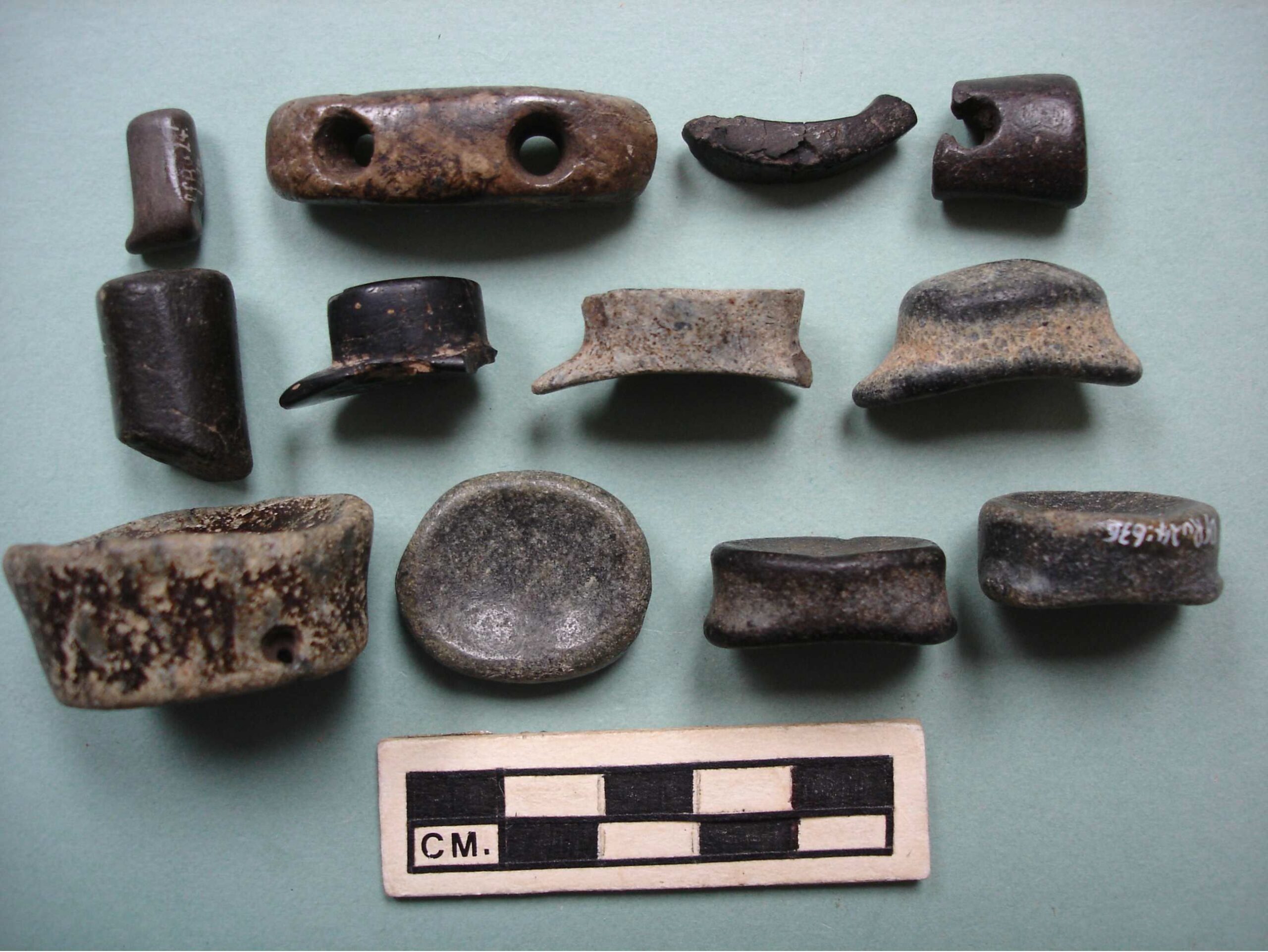
DfRu24: 1288. Galiano Island. Tolan’s Beach. Flange for composite labret. Two holes for attachment of two body extensions that would protrude outside the lip. Flange: W. 39.5mm, L. (at middle), 10.5mm, H. 11.8mm. The holes are 4mm in diameter with a distance of 13.8mm between the holes on the distal surface and 11mm between the holes on the proximal surface. Weight: 5.3 grams.
DfRu24: 944. Galiano Island. Tolan’s Beach. Fragment of flange (original would have had two holes) for composite labret. Lignite coal-like material. End portion with one hole and slight backward curve at end. Flange: W. [15] mm, L. [9] mm, H. [12.8] mm. Weight: [2.3] grams.
DfRu24: 1829. Galiano Island. Tolan’s Beach. Weathered body portion of lateral flange short body labret. Flanges weathered off. Concave distal and proximal surface. Body: L. 6.4mm, W. 26mm, H. 21.5mm.Weight: [5.5] grams. Notes: Surface collection. [Acc. # 69-82].
DfRu24: 1828. Galiano Island. Tolan’s Beach. Body portion of lateral flange short body labret. Flanges mostly weathered off. Concave distal and proximal surface. Body: L. 8.3mm, W. 22.6mm, H. 18.1mm, Flange: W. [25] mm, H. 17.5mm. Weight: [7.2] grams. [acc. # 69-82].
DfRu24:635. Galiano Island. Tolan’s Beach. Circular flange labret. Tooth cord attachment hole penetrating on the left corner from the proximal surface to the side. Raw material: steatite-like. Body: L. 16mm. Distal Rim: W. 35mm, H. 25.9mm; Proximal Rim: W. 31mm. H. 24mm. Tooth cord attachment outer hole concavities: 3mm. Weight 17.7 grams.
DfRu24: 636. Galiano Island. Tolan’s Beach. Weathered body portion of lateral flange short body labret. Flanges mostly weathered off. Concave distal surface. Body: W. 23mm, H. 19mm, L. 8.8mm. Flange: W. [25] mm, H. 18.2mm. Weight: [6.4] grams.
DfRu24: 1791. Galiano Island. Tolan’s Beach. Body portion of lateral flange short body labret. Flanges half weathered off. Convex distal body surface. Body: L. 11.6mm, W. [20.5mm], H. [14.5] mm. Flange: W. [28.5] mm, H. 13mm. Weight: [7] grams. Notes: [Acc. #69-66]. [Surface find].
DfRu24: 2000. Galiano Island. Tolan’s Beach. Nephrite-like material. Lateral flange short body labret. One flange broken off. Concave distal body surface. Body: L.8.2mm, W. [21.5] mm, H. [11.8] mm, Flange: W. [28.5] mm. H. 15.2mm. (Original W. c. 33.5mm). Weight: [4.4] grams. Notes: [acc. # 70-103]. [Acc. # 70-103]. [From cultural deposits below high tide].
DfRu24: 998. Galiano Island. Tolan’s Beach. Lignite coal-like material. Lateral flange short body labret. One flange broken off. Convex round distal body surface. Body: L. 10mm, W. 15.1mm, H. 14.6mm. Flange: W. [22] mm, H. 14.1mm… (Original W. c. 28mm0. Weight: [2.4] grams. Notes: [acc. # 68-19]. [From cultural deposits below high tide].
DfRu24:1333. Galiano Island. Tolan’s Beach. Raw Material: Lignite coal. Possible rim of a circular flange hollow body labret. The angle of the curve would imply that the complete artifact would be oval in shape. Body; W. [24mm]. Thickness of body wall: 5mm. Weight: [0.8] grams.
DfRu24: 1416. Galiano Island. Tolan’s Beach. Lateral flange short round thin body labret. One flange broken off. Body: L. 14mm, W. 7.5mm, H. Flange: W. 9.5mm, Original c. 13mm, H. 6.5mm. Weight: [12.7] grams.
DfRu24: 1900. Galiano Island. Tolan’s Beach. Distal portion of lateral flange labret. Part of a strait body or a broken-off upward extension. Body: L. [22]mm, W. 13.8mm, H. 12.5mm. Weight: [5.8] grams.
Saltspring Island
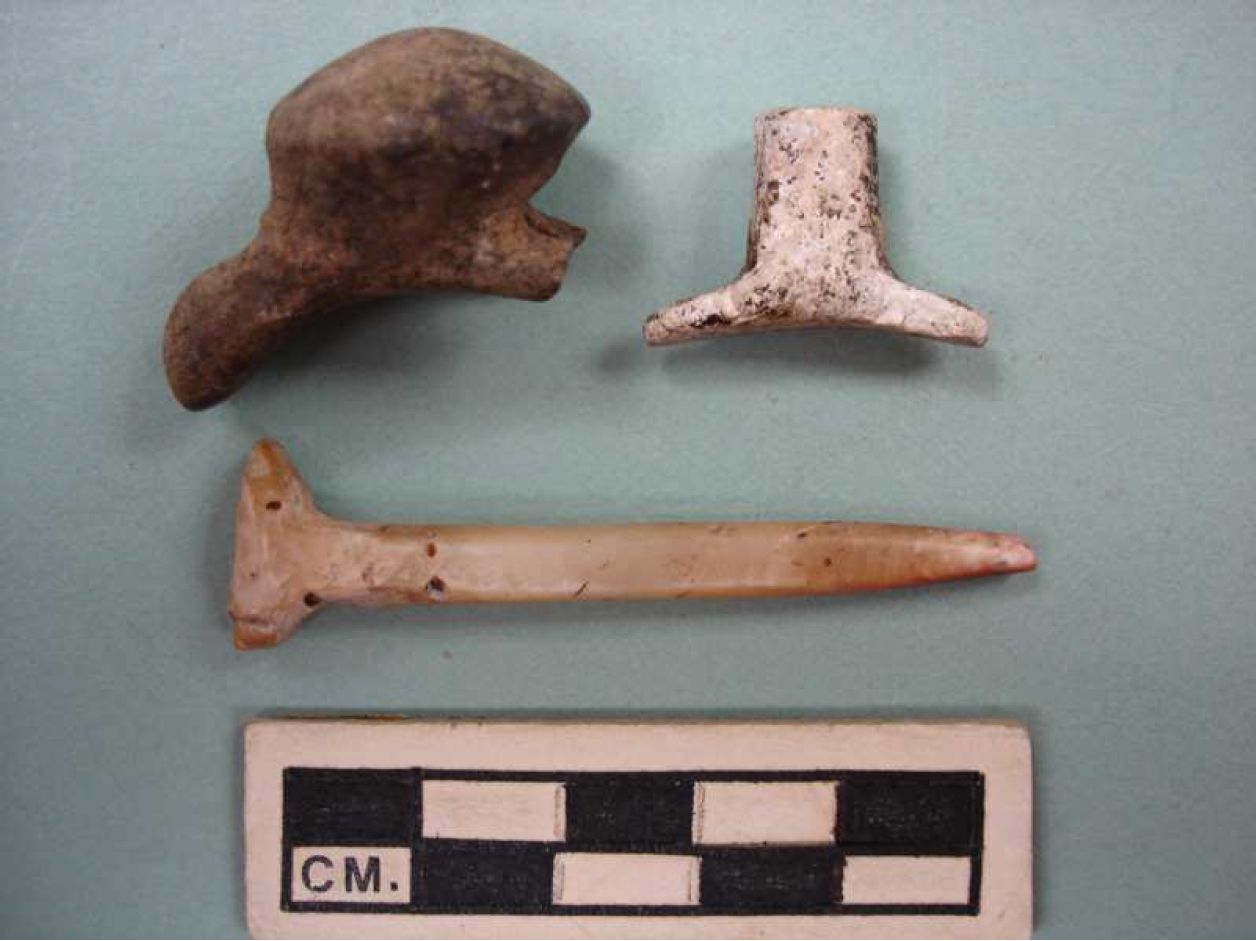
DeRu21. Beddis Bay. (Currently mistakenly recorded as DeRt-Y: 4 from Bedwell Harbour, Pender Island). Lateral Flange extended body labret. Purple Hinge Scallop shell. Body taper to point. Body: L. 56mm, W. 6mm, H. 6.5mm. Flange: W. 15mm, H. 7mm. Weight: 3.6 grams. Note: The original record in 1932 (old RBCM # 4590) mistakenly lists this Artifact as being from “Bedwell Hbr, Saltspring Island. In the 1970s the Saltspring Island part was changed to Pender Island – the correct location for Bedwell harbour. However, I believe that it is more likely that the “Bedwell hbr” part is wrong and should have been changed to Beddis Bay. Sometimes Beddis Bay was also referred to as Beddis Harbour. Another artifact donated at the same time by Inspector T.W. Parsons was from “Fulford Hbr, Saltspring Island”, and shortly before Mr. A. Beddis of Beddis Bay on Saltspring brought in an artifact from his property. It is more likely that police inspector Parsons was visiting Mr. Beddis at his farm – where Beddis gave him two artifacts to give to the Museum.
DfRu2:28. Walker Hook, Saltspring Island. Purple Hinge Scallop shell. Lateral flange, extended straight body labret. Small piece missing from near end of flange. Body: L. 15.8mm (from base of centre of flange to distal end of body), W. 9.3mm; H. 7.1mm. Flange: W. 24mm; H. 7mm Weight: 2.1 grams. Accession 2004-53. Notes: Permit Report 2003-123. I. R. Wilson Consultants, Dec. 2004.
DfRw3:3. Saltspring Island. N.W. end of Ganges Harbour. One end of double body labret. The broken end to ward the centre has a 5mm drill hole suggesting that the two sides were tied together after breaking. Slight firecracking. Raw Material: sandstone-like. Body: L. 17.2mm, W. 21.5mm, H. 20.2mm. Flange: W. [30mm], H. 15mm. Weight: [9.9] grams.
DfRu4:77. Hill property, Saltspring Island. Siltstone. Lateral flange, extending straight body labret. Body: L. 40mm (from base of centre of flange to distal end of body), W. 24.9mm; H. 15.9mm. Flange: W. 57.6mm; width 11.6mm. Weight 29.4 grams. Found with burial (#18) of adult male “probably in his 20’s”.
DfRu4:51. Hill property, Saltspring Island. Possible labret inlay for a circular flange labret. Purple-hinge scallop. Circumference 27.6mm; Thickness 3.6mm; Weight 3.5 grams.
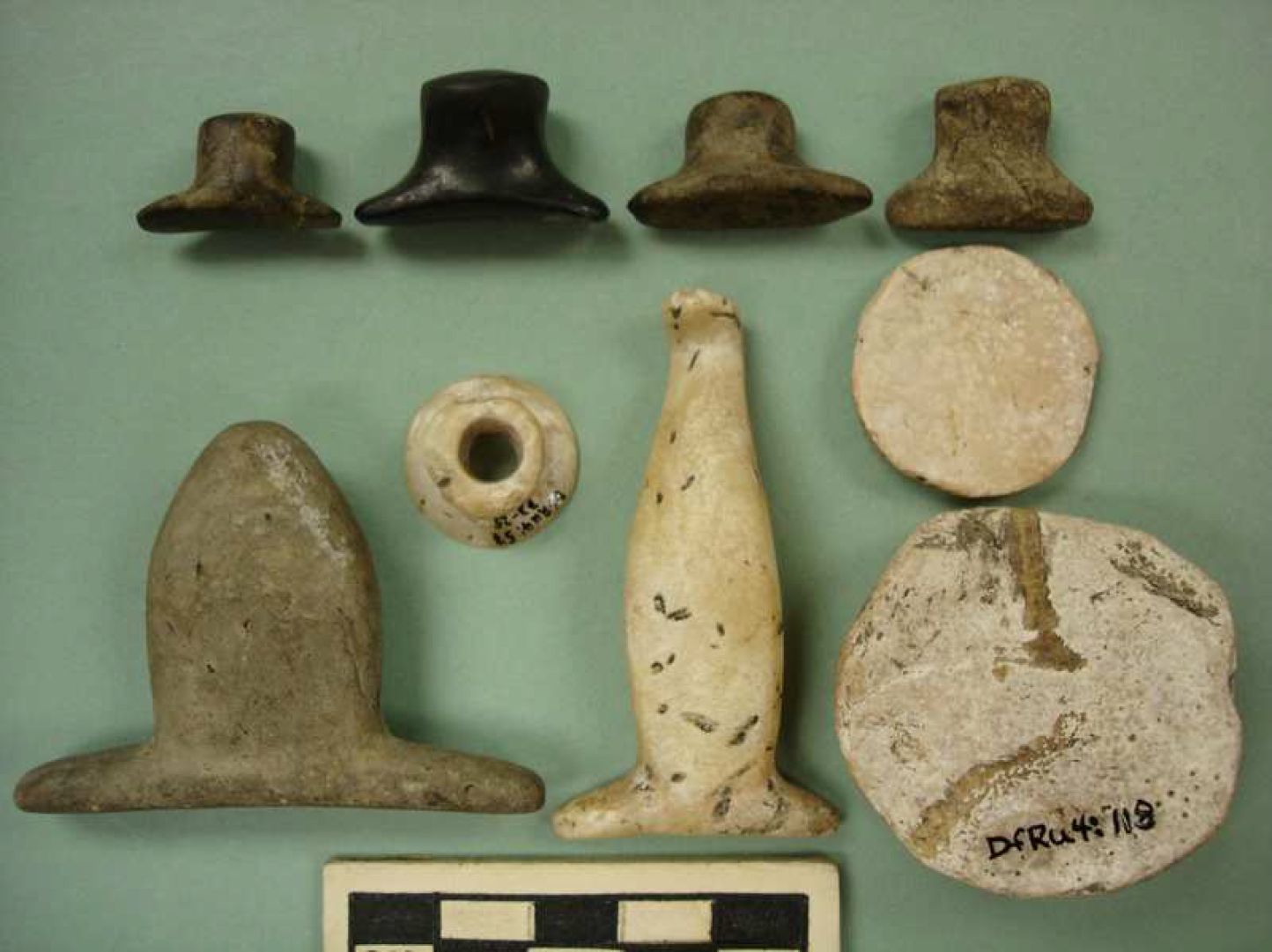
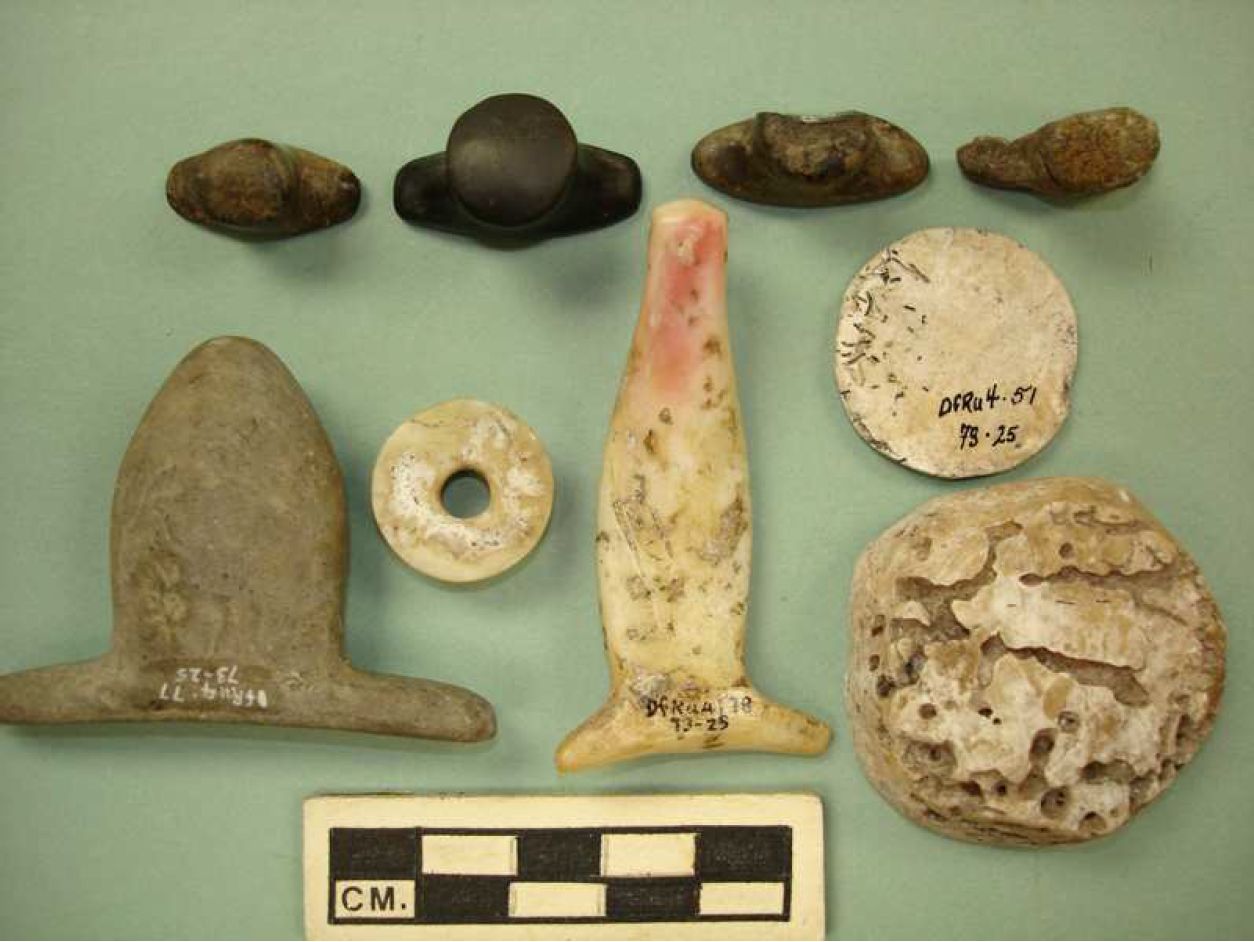
DfRu4:57. This problematic object could be either a circular flange short extended body labret or an ear spool. Raw Material: Purple hinge scallop. The object is composed of a short body with a hole through it, a slight flange at one end and a large, round and thin flange at the other end. There is a plaque-like substance on the flat surface of the larger flange which may be an adhesive compound – indicating that some other decorative part may have been glued on to this side. Alternately, the large flange may have been against the teeth and the plaque-like substance may be a result of chemical interaction with the shell and human saliva. If the latter was the case, the hole in the centre may have been for the insertion of a longer body which extending through the lip or a decorative inlay. Length: 8mm. Larger flange: diameter: 19mm by 19.4mm. Smaller flange diameter 12.6mm by 13mm. The diameter between the flanges is 12mm. The larger flange surface is slightly concave. The hole opening on smaller end is 5.3mm and 7mm on the other end. Weight: 2.2 grams.
DfRu4:78. Lateral flange extended body labret. A long tongue shaped body, with short up-curled distal end. Red /Pink natural colour on ventral side of distal end. Purple hinge scallop. Body: L. 58mm; W: 16.8mm; H. 8.5mm. Flange: W. 31mm; H. 8mm. There is a 13mm upward arc on the ventral side between the flange and distal end of body. Weight: 13.6 grams. Notes: Found with burial of adult & infant (#19).
DfRu4:56. Lateral flange short body labret. Siltstone-like. Body: L. 16mm; W. 10.5mm; H. 10.1mm. Flange: W: 22mm; H. 10mm. Weight: 3.08 grams.
DfRu4:35. Lateral flange short body labret. Stone. Body: L. 16mm; W. 13.9mm; H. 14mm. Flange: W. 27.6mm; H. 11mm. Weight: 6.3 grams.
DfRu4:73. Lateral flange extended body labret. Portion on one side is missing. Sandstone. Body: L. 16.8mm; W. 12.5mm; TH. (8mm). Flange: W. 22.5mm; H. [7.6mm]. (Old accession 73-25). Weight: [2.1] grams.
DfRu4:74. Lateral flange extended body labret. Portion on one side is missing. Siltstone-like. Body: L. 13.2mm; W. 12.2mm; H. (8.3mm). Flange: W. 22mm; H. 10cm. Weight: [3.93].
DfRu4:118. Possible labret inlay. Purple Hinge Scallop. Diameter: 40mm. L. 10.2mm – 14.5mm. The irregular concave dorsal surface is weathered. Sides and ventral surface are not weathered, and are ground at a slight angle as if made to fit into something. This may be a thick inlay for a large wooden labret. Weight: 32.7 grams.
Portland Island
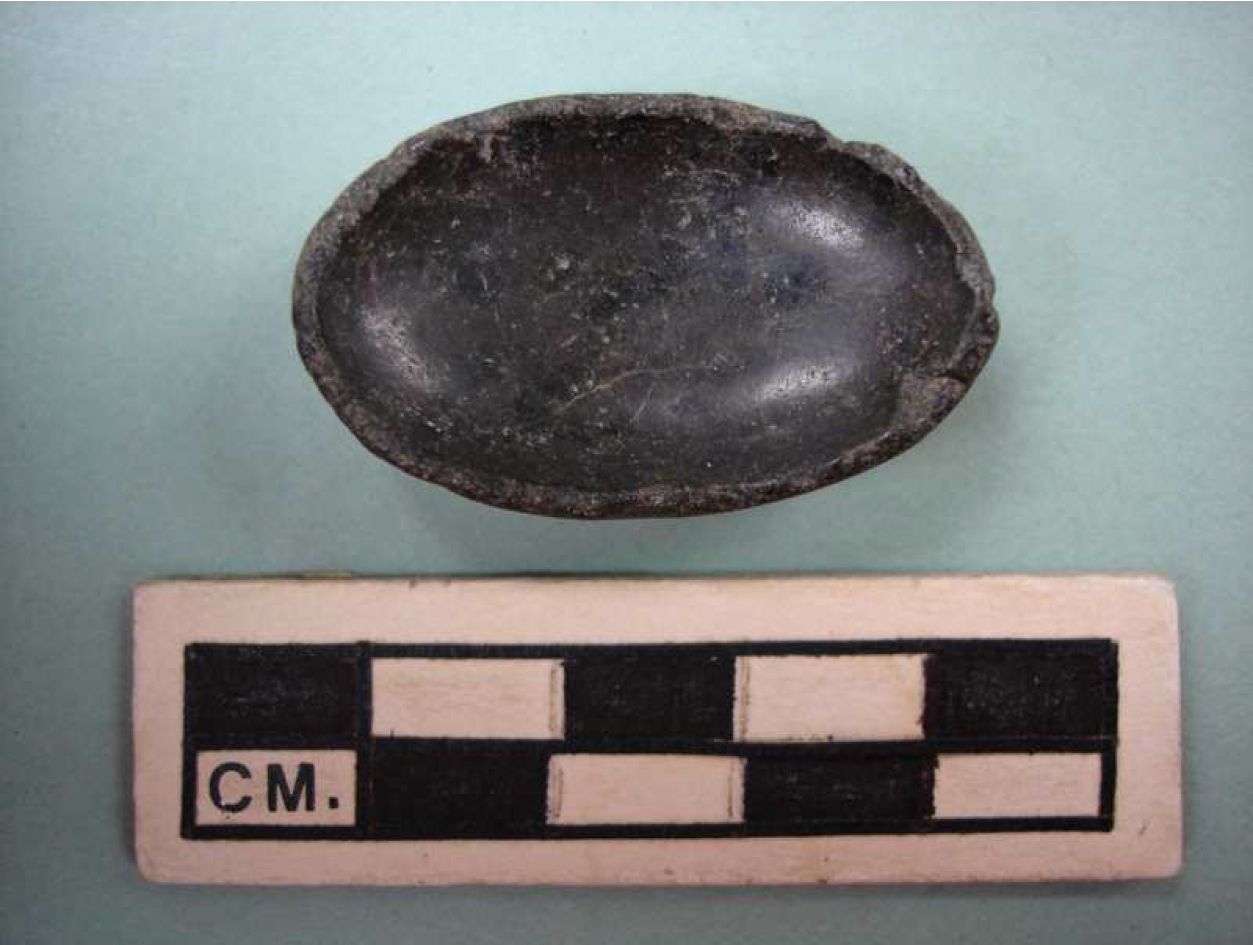
DeRu26:3. Portland Island. Raw Material: Nephrite. Circular flange labret. Tooth cord attachment hole penetrating on the left corner from the proximal surface to the side. Slightly convex proximal end and 2mm deep concavity of distal surface. Body: L. 9mm. Outer rim: L. 34mm, W. 21mm; Inner rim: W. 31mm, H. 20.4mm. Tooth cord attachment hole outer and inner concavity: 3mm. Weight 9.56 grams. Surface collected from Beach.
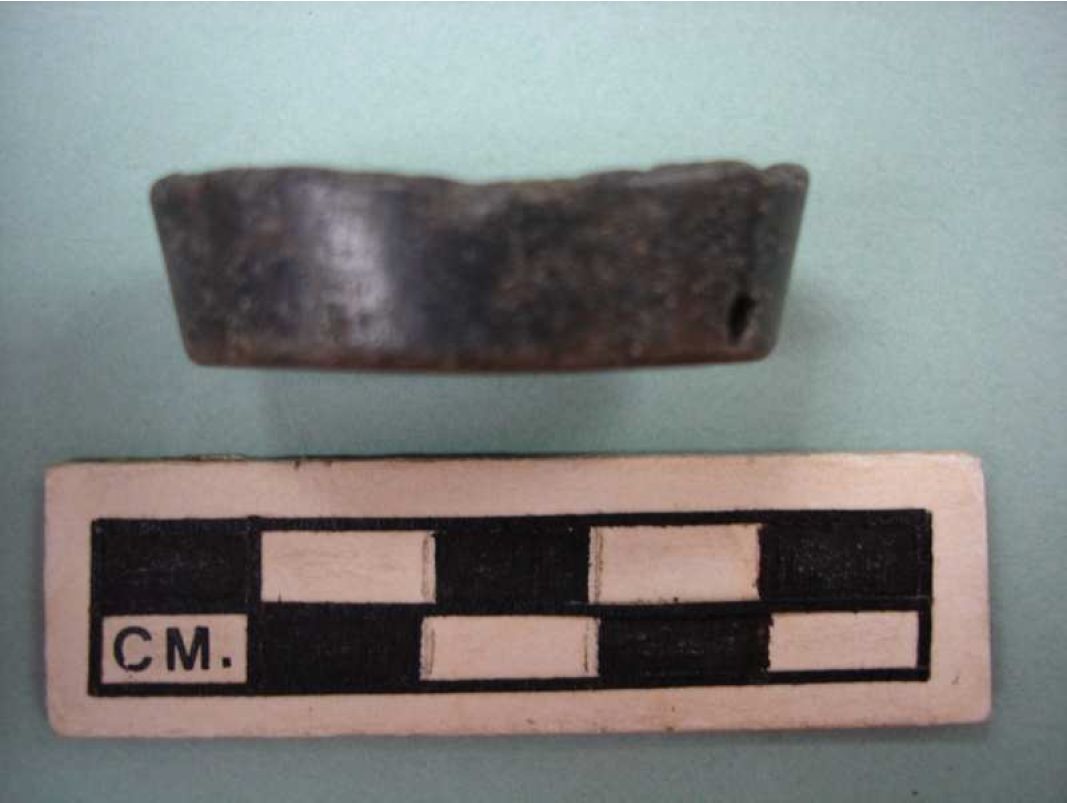
Lower Fraser River
Eight of the 14 labrets from the Beach Grove site were recovered during one project by Altamira Consulting LTD. Permit 1998-113. Six were excavated in 1979 by Stan Copp – Vancouver Community (Langara) College field school.
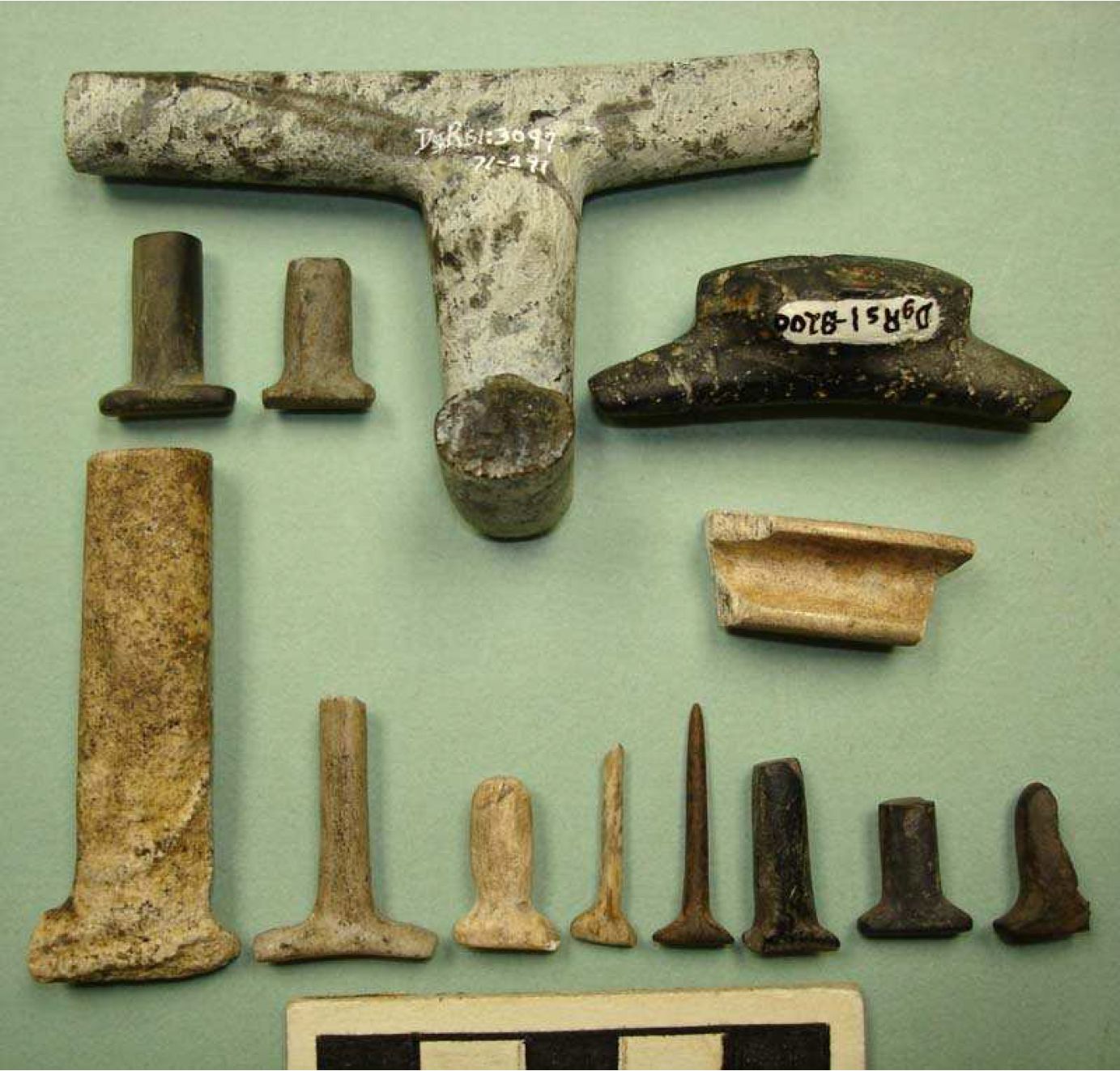
DgRs1:9200. Lateral flange short body labret. Shale-like stone. Chipping on edge of flange. Body: L. 13.7mm, W. 27mm; TH. 17.5mm. Flange: W. 46mm; H. 12.6mm. Weight: 13.27 grams.
DgRs1:3097. Beach Grove Site. Lateral flange short body labret. Steatitelike stone. The body extension turns down and then up at a sharp angle. This upward angle extension is [20.5mm] to where it is broken off. The diameter of the broken end is 12.5mm. Body: L. 45mm (not including angle extension), W. 15mm, H. 14mm (not including angle extension); Flange: [74mm] – (broken at one end – original L. c. 83mm), H: 11mm. Weight: [29.8] grams. The lack of wear polish would suggest this labret was broken during its manufacture. [Acc. #71-291]. Surface Collected.
DgRs1:8450. Beach Gove Site. Lateral flange extended body. Quartzite-like stone. The long uniformly straight body is oval in cross-section and the flanges are broken and weathered. Body: L. 51mm, W. 13mm, H. 9mm. Flange: L. [20mm] – original estimated at 25mm, H. 7mm. Weight: [11.1] gram. Stan Copp 1979.
DgRs1:8723. Beach Grove Site. Lateral flange extended body. The slightly tapering body extension is broken off. Quartzite. Curvature of flange base .6mm. Body: L. [26mm], W. 5.2mm, H. 4.5mm. Flange: W. 18mm, H. 4.5mm. Weight: [1.6] grams. Stan Copp 1979.
DgRs1: 8720. Beach Grove Site. Section of a circular labret rim that would be inlayed with a central body of other material. Quartzite-like stone. L. 11mm. Outer or distal flange rim width: 9.5mm. Inner rim width: 7mm. Mid rim width: 5mm. Weight: [1.7] grams. Stan Copp 1979.
DgRs1:8736. Beach Grove site. Distal portion of a thin lateral flange extended body labret. Small 2mm hole in distal end – likely for decorative inlay. Body: L. [32]mm, W. 4.0mm, H. 3.8 mm. Black slate-like material. Weight: [1] gram. Stan Copp 1979. (image not shown).
DgRs1:11446. Beach Grove site. Lateral flange extended body. Body: L. 17.4mm, W. 68mm, H. 6.8mm. Flange: W. 13.7mm, H. 6.3mm. Material: Shale. Weight: 1.9 grams. Notes: Collected May 28, 1998. Layer A, Level 2. 60cm from S.E. corner. 5cm from E. wall. DBD 25.5cm. Found with similar labret DgRs1:11445. Permit 1998-113.
DgRs1:11445. Beach Grove site. Lateral flange extended body. Body: L. 14.8mm, W. 6.8mm, H. 6.8mm. Flange: W. 11.3mm, H. 5.6mm. Shale-like material. Weight: 1.2 grams. Notes: Collected May 28, 1998. Layer A, Level 2. 60cm from S.E. corner. 5cm from E. wall. DBD 25.5cm. Found with similar labret DgRs1:11446. Permit 1998-113.
DgRs1:11951. Beach Grove site. Lateral flange extended body labret. Body: L. 13.2mm, W. 6.0mm, H. 6.0mm. Flange: W. 11.1mm, H. 5.0mm. Shalelike material. Weight: 0.84 grams. Notes: Collected June 23, 1998. 6-7N/7- 8W. Layer A, Level 2. Permit 1998-113.
DgRs1:11157. Beach Grove site. Lateral flange extended body labret. Body: L. 18.2mm, W. 5.5mm, H. 5.4 mm. Flange: W. [9.4]mm, H. 4.0mm. Shalelike material. Weight: 1.2 grams. Notes: Weathering of broken flange indicates it was worn after breakage. Collected May 27, 1998. 6-7N/8-9W. Layer C, Level 3. Permit 1998-113.
DgRs1:12025. Beach Grove site. Lateral flange extended body labret. Body: L. 15.0mm, W. [5]mm, H. 5.2 mm. Flange: W. [9.5]mm, H. 5.0mm. Steatite-like material. Weight: [0.8] grams. Notes: One flange end and lateral half of body missing. Collected June 5, 1998. Removed from matrix sample D, Trench 4, 2.8m N., 2.25m W. 30cm below surface. Permit 1998-113.
DgRs1:11138. Beach Grove site. Lateral flange extended body. Body: L. 16.5mm, W. 6.1mm, H. 5.9 mm. Flange: W. 10.4mm, H.5.0mm. Purple hinge scallop shell. Weight: 1.1 gram. Notes: Collected May 25, 1998. unit 8-9N/7-8W. Layer A. Permit 1998-113.
DgRs1:11352. Beach Grove site. Lateral flange extended body. Distal end of body missing. Body: L. 19.4mm, W. 2.4mm, H. 2.6 mm. Flange: W. 6.6mm, H.2.6mm. Bone (small mammal). Weight: 0.2 gram. Notes: Collected June 22, 1998. Excavation Unit 6-7N/4-5W. Layer A, Level 2. Permit 1998-113.
DgRs1:11241. Beach Grove site. Lateral flange extended body. Thin body tapers to sharp distal point. Body: L. 23.1mm, W. 3.0mm, H. 3.0 mm. Flange: W. 8.0mm, H. 4mm. Quartz-schist-like material. Weight: 0.4 gram. Notes: Collected June 11, 1998. Excavation Unit 4-5S/11-12W. layer D, level 8. Permit 1998-113.
DhRs19 (number to be assigned). Vancouver, Marpole. Liquid Air Site. Lateral flange. Oval body tapering from 27mm to 17mm wide at broken off distal end. Body: L. [46mm]. W: 27 mm; H. 21 mm (at proximal end). Diameter at broken distal end 15 mm by 17 mm. Flange: W. 64mm, H: 21mm. Weight: [39.2] grams. Raw Material: serpentine-like stone (burnt). Notes: Surface collected by Jim Garrison. A.S.B.C. Garrison catalogue number A269. DgRr6:7053. Glenrows Cannery. Lateral flange with extended body. Small labret with round thin body. Distal portion of body missing. Brown slate. Body: L. [12.8]mm; W. 4mm; Th. 3.8mm. Flange: W. 8.3mm, H.2.9mm. Weight: [0.3] grams. Surface collected.
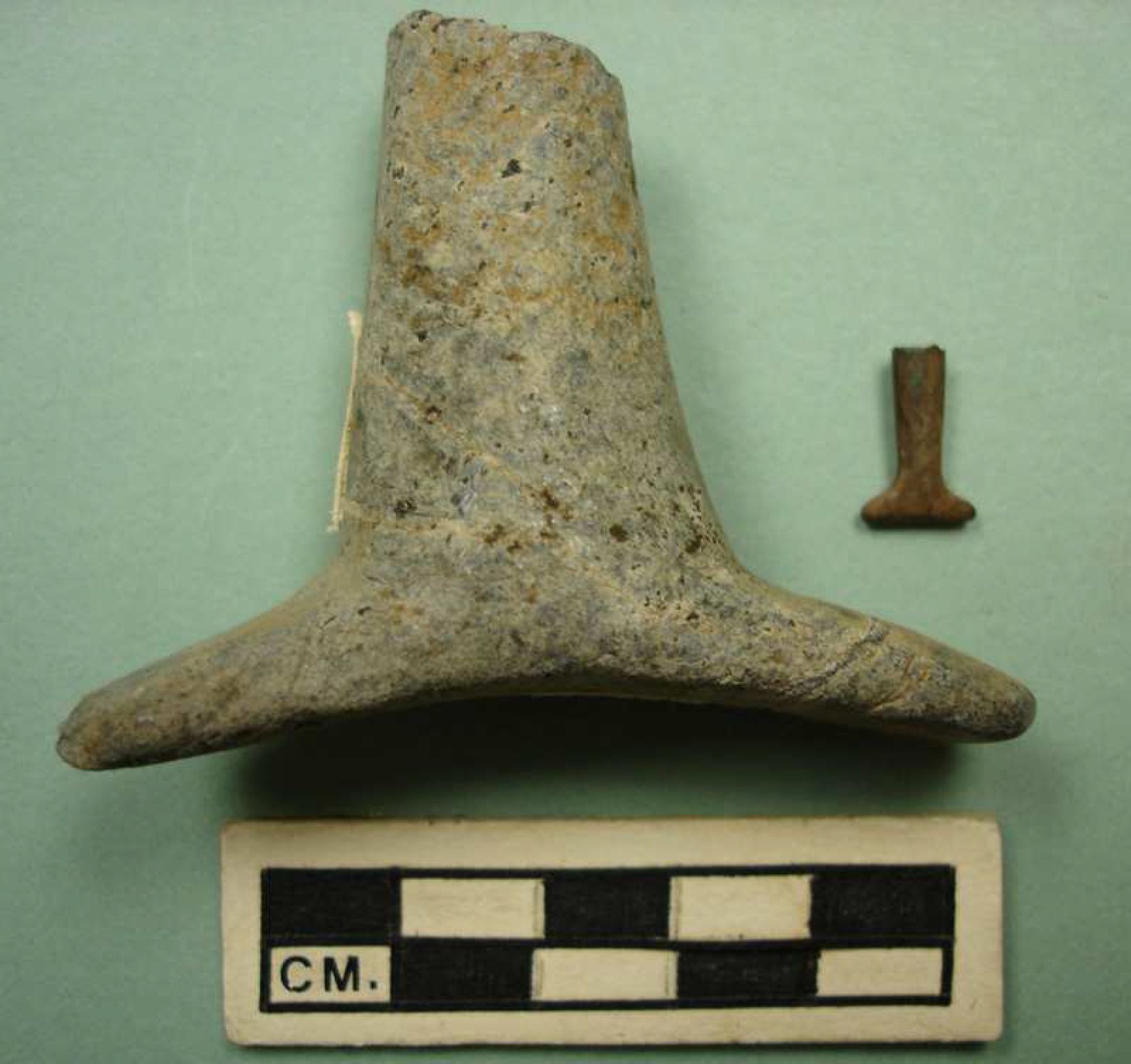
The Pitt River, Mary Hill Site DhRq21.
All fourteen labrets from this site were collected during excavations by Valerie Patenaude under Permit 1980-06: The Pitt River Archaeological Site DhRq21: A Coast Salish Camp on the Lower Fraser River, Vol. 1.
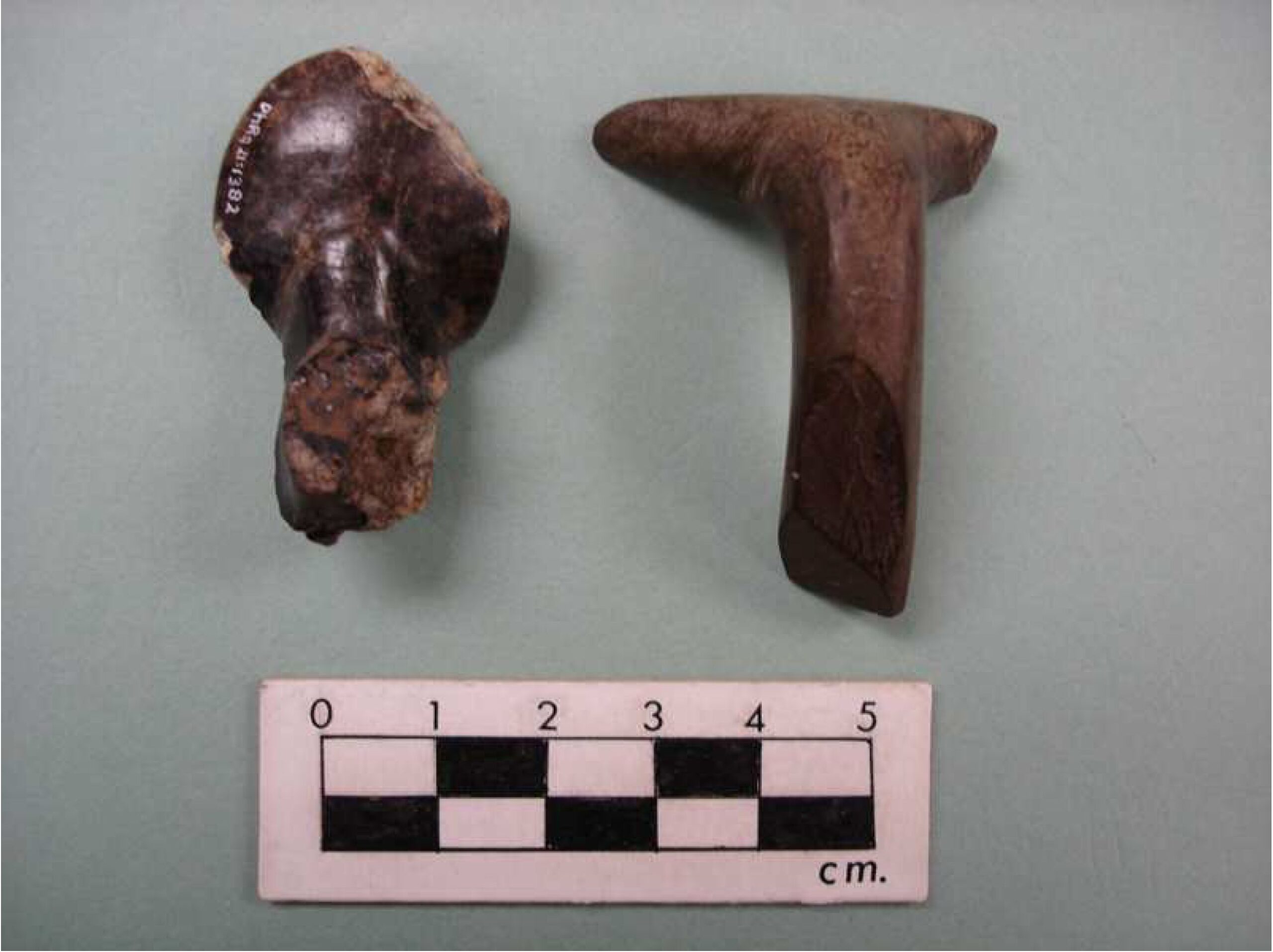
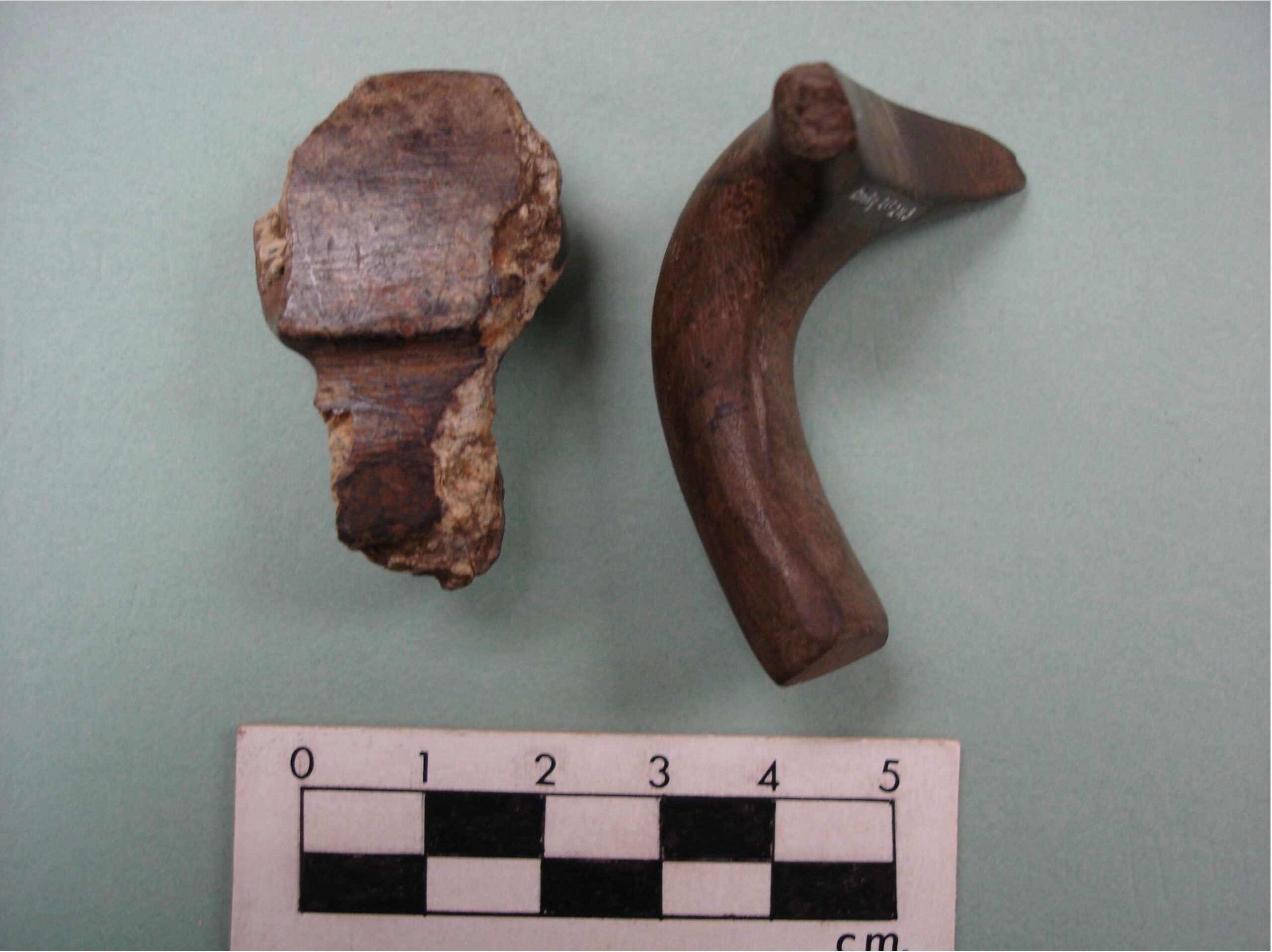
DhRq21:1382. Mary Hill. Pitt River area. Steatite-like material. This problematic specimen is broken off in several places making it difficult to ascertain the original shape. It appears to have had a circular-like body with an extension that angled up – but is broken off. The main body is 26mm wide with a height of 12.5mm. The grooves around the central round piece are irregular. Weight: 12.3 grams.
DhRq21:2113. Mary Hill. Pit River. Shale-like stone. Lateral flange extended body labret. Body extension curves downward. The distal end is 41mm foreword of a line extending from the centre of the flange. The end of one flange broken off. Body: L. 54mm (the body extends out 15mm and then turns down), W. max. 14 (to distal end at 11.5mm), H. 12.5 (to distal end at 8mm); Flange: W. [36.5] – original c. 40mm, H. 10mm. Weight: [13.6] grams.
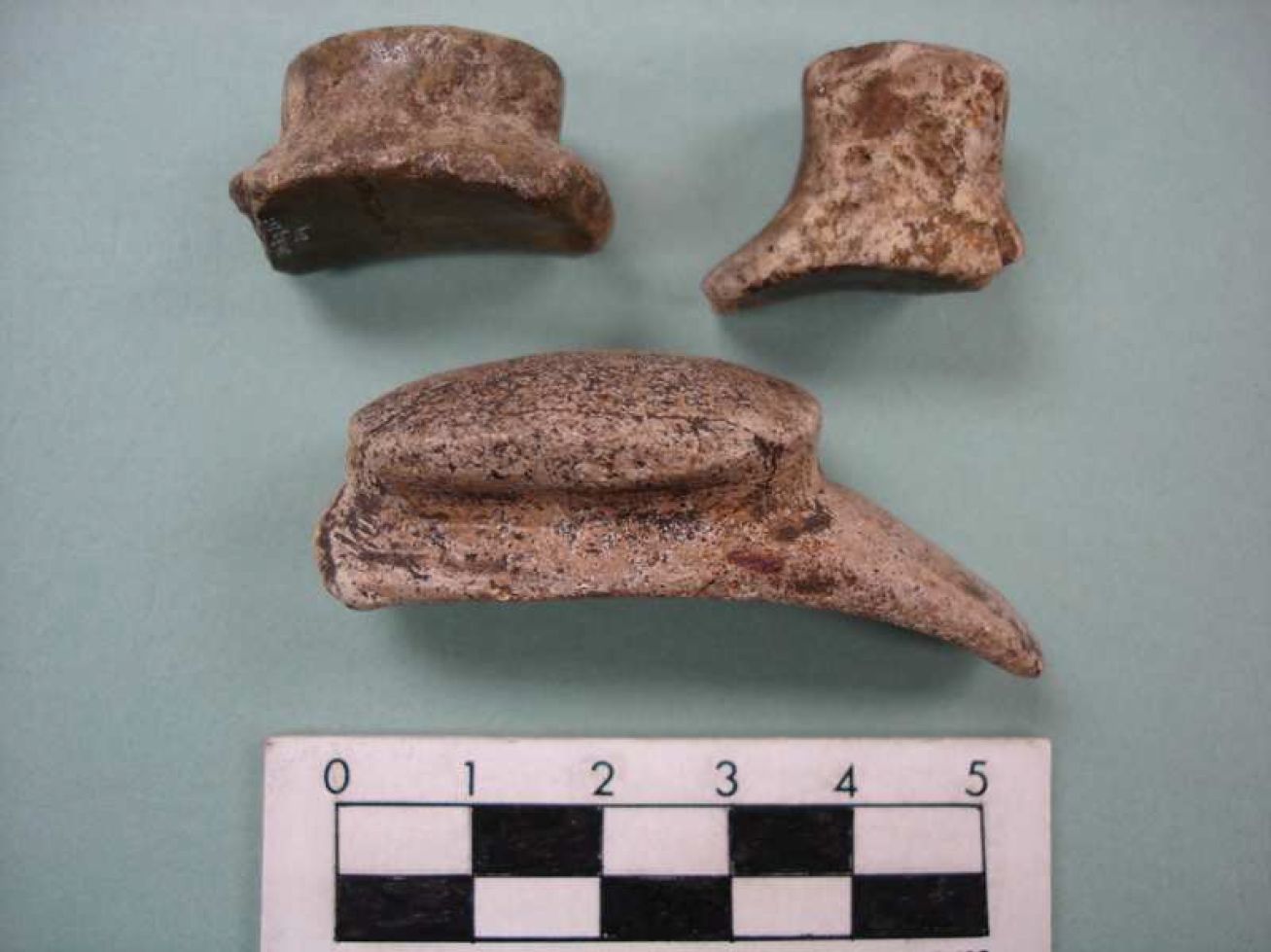
DhRq21:214. Mary Hill. Pit River Area. Stone. Lateral flange short body labret. One flange 2/3 broken off. The other flange appears to have been broken but worn from continued use. There is a distinct raised 7mm nipple at the centre of the distal end of body. Body: L. 15.5mm, W. 21mm, H. 17.4. Flange: W. [29mm], H. 19mm. Weight: [9.6] grams.
DhRq21:44. Mary Hill. Pit River. Stone. Lateral flange short body labret. One flange missing. Body: L. 18.5, W. 16mm, H. 14.4mm. Flange: W. [24mm], Original c. 30mm, H. [14mm], original c. 14.2. Weight: [6.6] mm.
DhRq21:3049. Mary Hill. Pit River. Stone. Lateral flange short body labret. One flange 2/3 broken off. Groove between flange and expanded distal end of body. Body: L. 16.7mm, W. 34mm, Original c. 36mm. H. 22.3mm; Flange: W. [53mm] Original c. 68mm, H. 18.5mm. Weight: [19.3] grams.
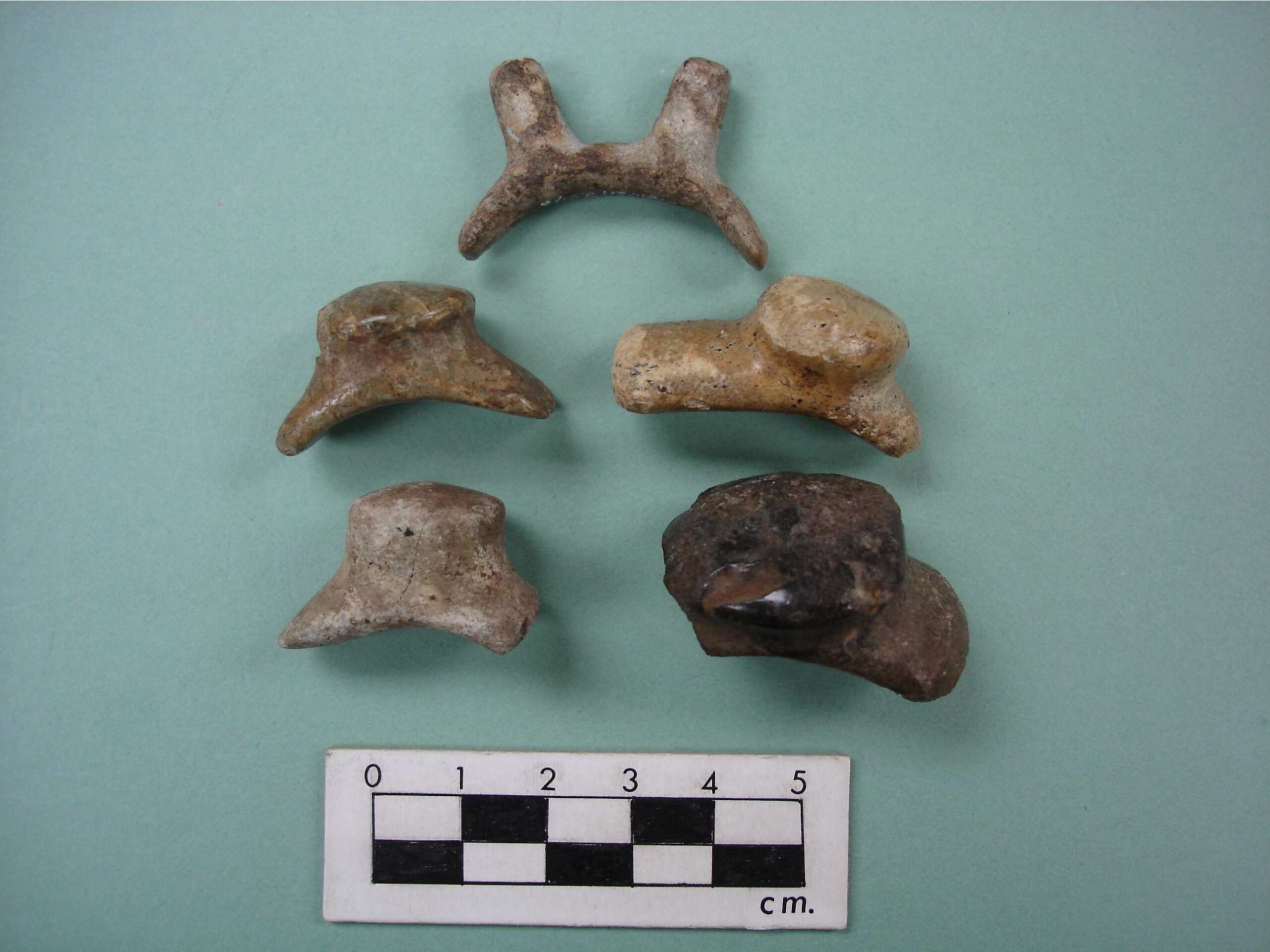
DhRq21: 3596. Mary Hill. Pit River Area. Stone. Small lateral flange double short body labret. Bodies: (1) L. 17.3mm, W. 8mm, H. 8mm; (2) L. 17mm, W. 8mm, H. 8.2mm. Distance between bodies: 7mm. Flange: W. 36mm, H. 8.4mm. L. (at centre); 5.9mm. Weight: 5.6 grams.
DhRq21:984. Mary Hill. Pit River Area. One end of a lateral flange double body labret. Small piece broken off side of body. This appears to have been re-used as a single body labret. Body: L. 13.4mm, W. [18.8mm] (original c. 20mm): Flange: 31mm, H. 15.5 (at body). Weight: [7.6] grams.
DhRq21:134. Mary Hill. Pit River Area. One end of a lateral flange double body labret. Body: L. 13.6mm, W. 17.5mm, H. 18mm; Flange: W. [26.8mm], H. 17mm (at body). Weight: [7] grams.
DhRq21:18. Mary Hill. Pit River Area. Stone. Lateral flange short body labret. One flange broken off. Body: L. 16mm, W. 17.5mm, H. 18.1mm; Flange: W. [30mm] Original c. 36mm, H. 16.1mm. Weight: [10] grams.
DhRq21:176. Mary Hill. Pit River Area. Stone. One end of large lateral flange double body labret. Body: l. 14.8, W. 26.3mm, H. 27mm; Flange: W. [35mm], H. 26mm. Weight: [23.6] grams.
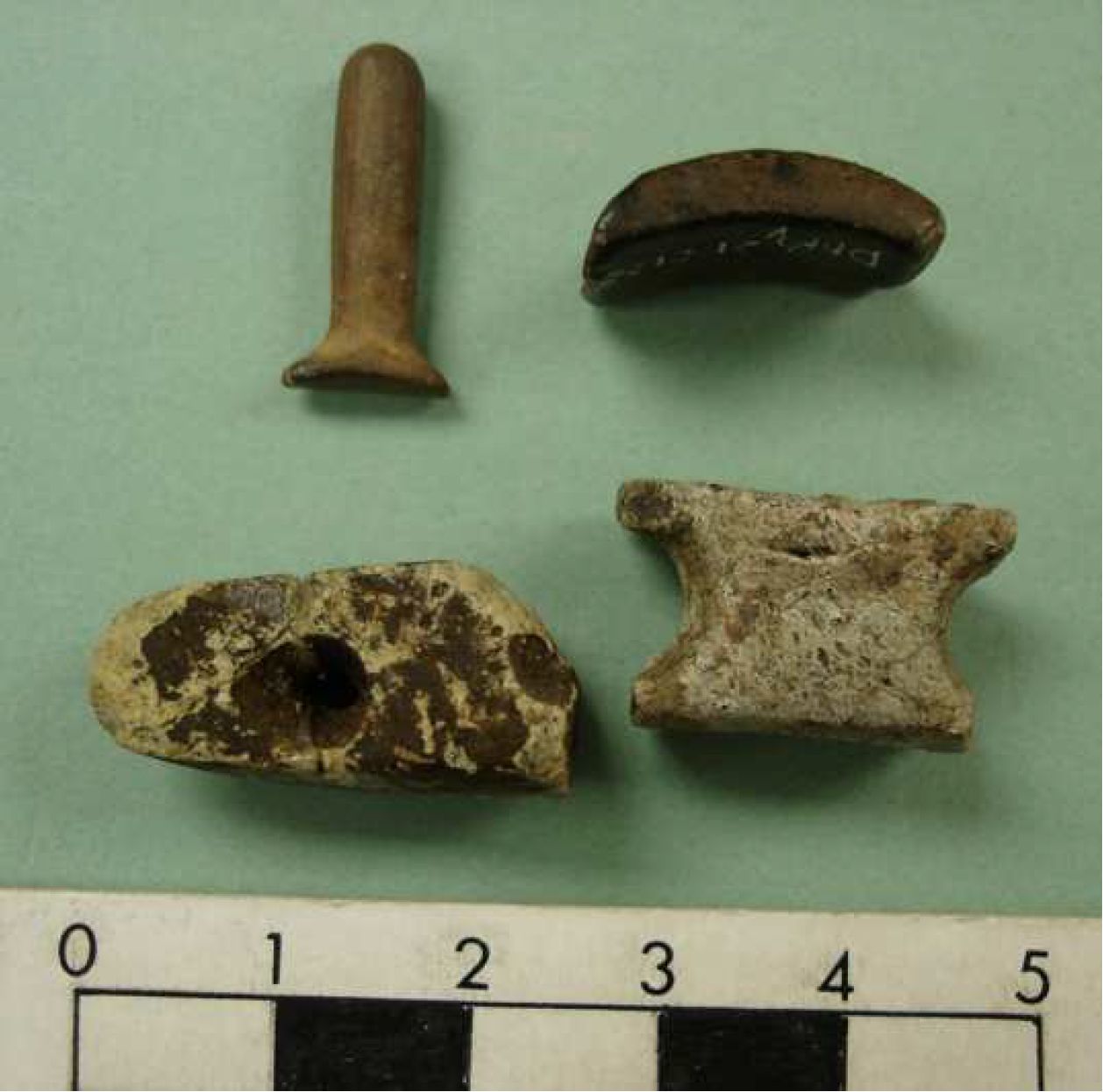
DhRq21:2198. Mary Hill. Pit River Area. Stone. Small lateral flange extended body labret. Body: L. 18.8mm, W. 5mm, H. 4.4mm; Flange: W. 9mm, H. 4mm. Weight: 0.7 grams.
DhRq21:2128. Mary Hill. Pit River Area. Stone. Circular flange hollow centre. Only a small portion of the flange is present. Steatite-like. W. [18.5mm], H. 11.8mm. Weight: [1.4] grams.
DhRq21:363. Mary Hill. Pit River Area. Stone. Lateral section of holed flange. W. [24mm], H. 11mm. 6mm bi-conically drilled hole. Slight curvature on end. Weight: [2.4] grams.
DhRq21:472. Mary Hill. Pit River. Stone. Mid section of two holed flange. W. [19mm], H. 12.2mm. Distance between holes: 13mm. Weight: [3] grams.
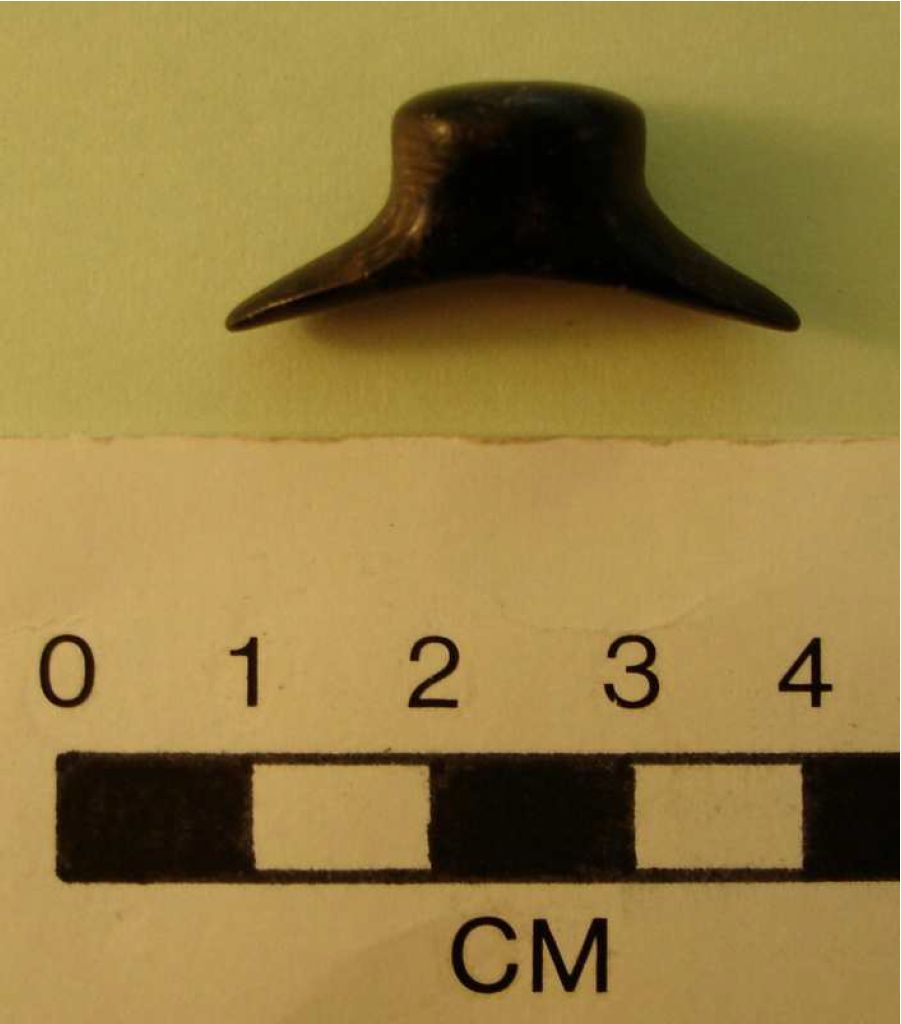
DjRi-Y:12. Fraser Canyon Spuzzum-Yale area (“Yale District”). Lateral flange short body labret. Nephrite-like. Body: L. 10mm, W. 13mm; H. 12.5mm. Flange: W. 30mm; H. 9.2mm. Distance in curve of flange: 3mm. Weight: 3.9 grams. Notes: [old # 3064, 1917-27]. Croucher collection. Surface find.
Southern Coast General Location
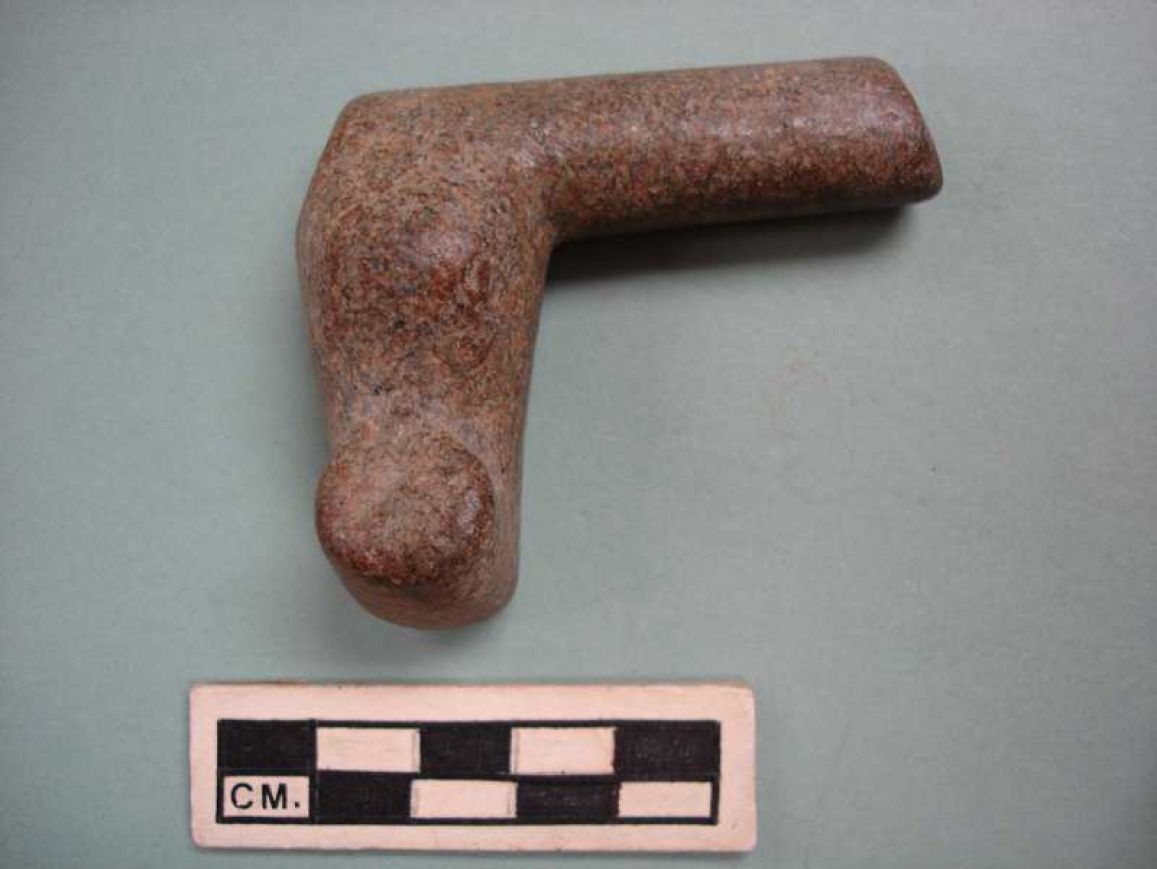

Y:1286. The provenience of this specimen is unknown, but it is most likely from the southern coast where similar examples occur and where most early museum donations were from. This large labret has a broken body extension that turns up at a sharp angle. The end of one side of the flange is broken off and the entire flange from one side is missing. There is a hole drilled into the body where the flange broke off – suggesting that the flange was re-attached with a dowel inserted between the body and flange. Similar design as DgRs1:3097. Body: L. 51.5 to where it angles up), W. 24mm, H. 19.5. Flange: W. [57mm], (original W. c. 110mm), H. 13mm. Weight: 48.8mm.
Central Coast. Price Island.
FcTe4:34. North End Price Island. Grant Anchorage. Circular flange extended body labret. The flange is a rectangular shape that tapers sharply down to the long thin body on all sides. The body gradually tapers to a point. Bone. Body: L. 37mm, W. 4mm, H. 3mm; Flange: W.7mm, H. 5.3mm. Weight: 0.4 grams. Notes: (accession #72-362), Systematic excavation, Simonsen 1973, fig. 20J, “novice’s labret”. In component with earlier date (uncorrected) of about 140 B.C. (2090-+100, Gak-2757). (Archaeological Investigations in the Hecate Strait-Milbank Sound Area of British Columbia. Mercury Series. Archaeological Survey of Canada, Paper No. 13).
FcTe4:277. North End Price Island. Grant Anchorage. Lateral flange extended body labret. Bone. The flange is a rectangular shape with a notch on each side above that distinguishes it from the body. The body gradually tapers to a squared off point. Body: L. 32.8mm, W. 8mm, H. 4mm. Flange: W. 11mm, H. 6mm. Weight: 1.8 grams. Notes: (RBCM accession #72-362), Simonsen 1973.
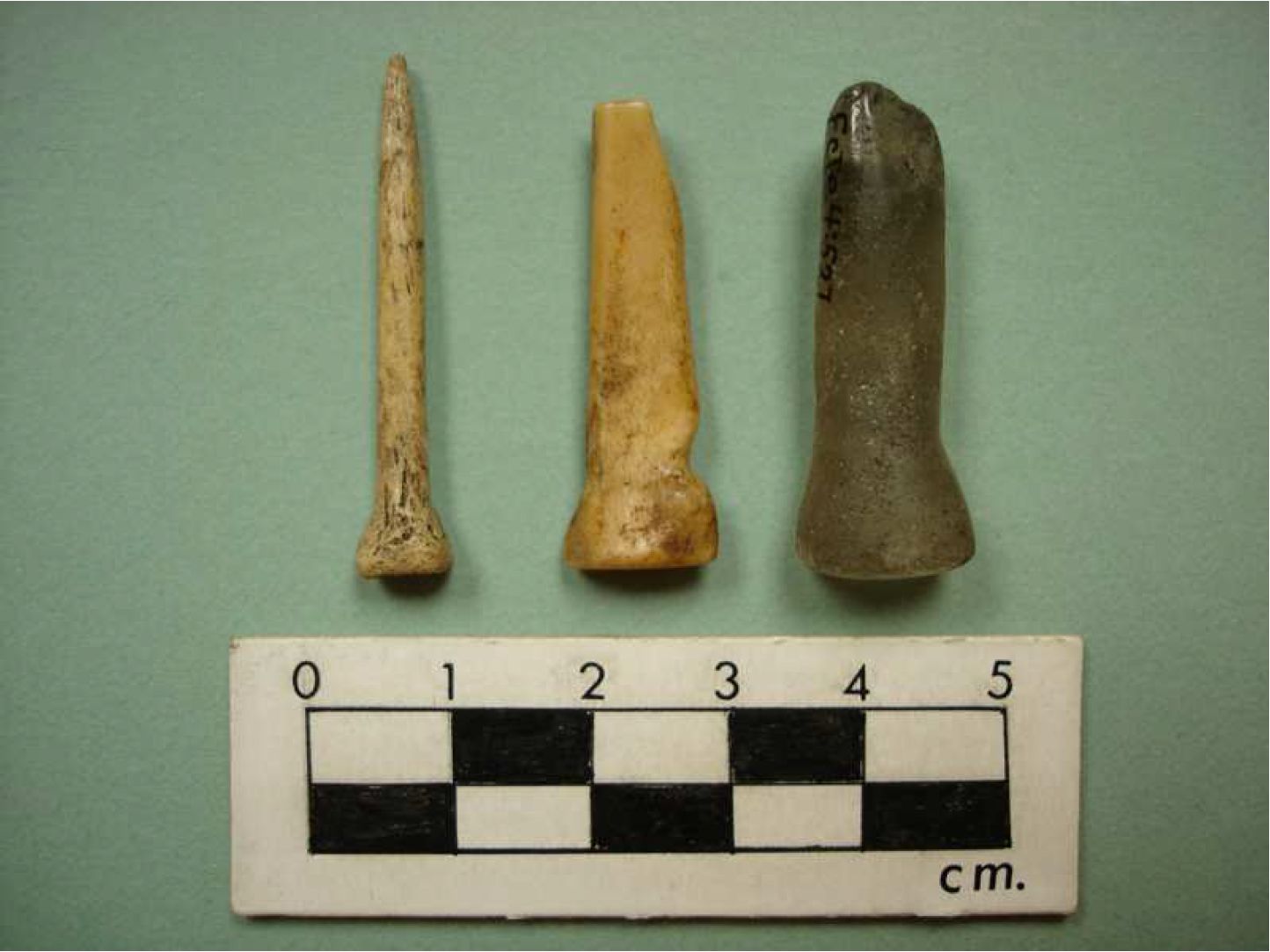
North End Price Island. Grant Anchorage. Circular flange extended and narrow body labret. The flange tapers shapely to the body. The body slightly expands in width from the proximal end but stays the same in height. Quartz Crystal. Body: L. 34mm, W. 9.5mm, H. 8mm; Flange: W. 12.2mm, H. 9.8mm. Weight; 5.3 grams. RBCM accession #72-362. Simonsen 1973, fig. 20b, “Pecked and ground quartz crystal”, Unit 1A, level 7, 2110+-110 B.P. uncorrected.
Northern Coast of B.C.
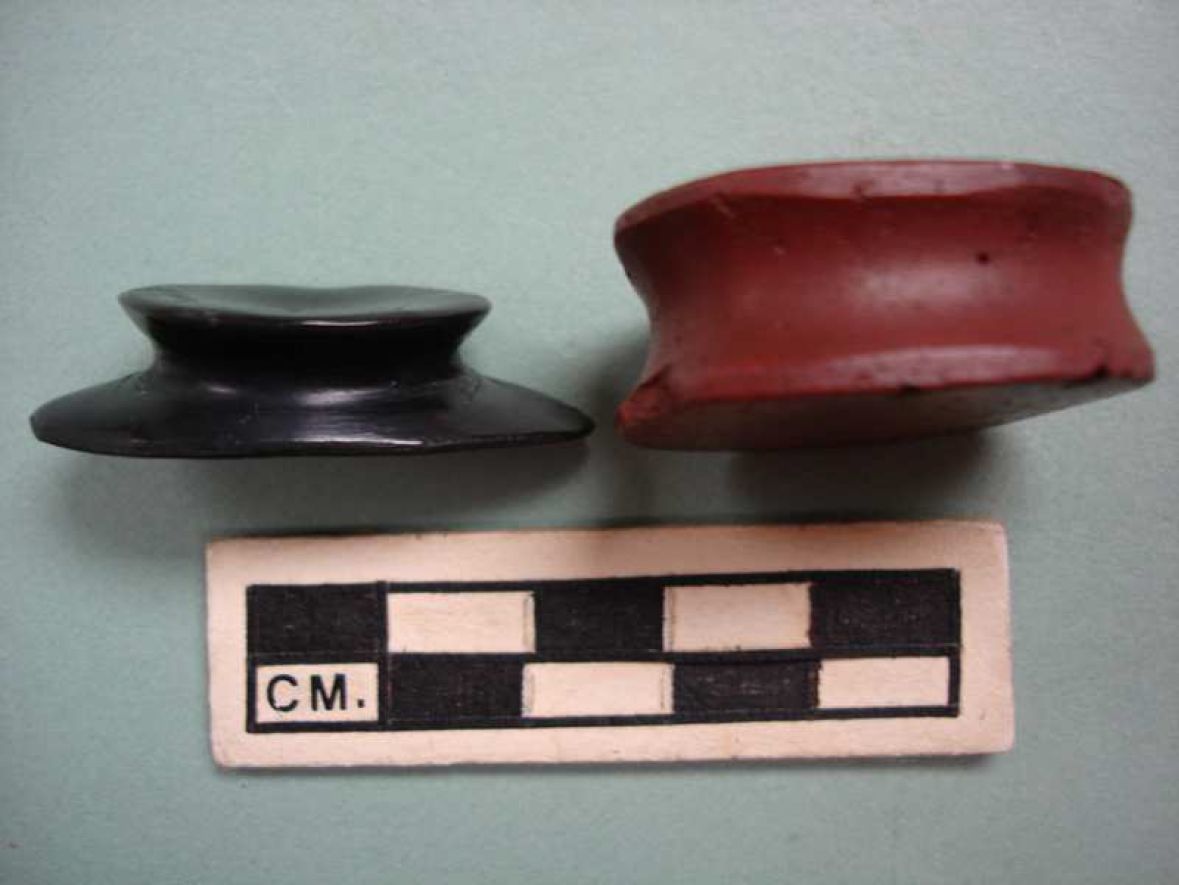

GbTo31:2179c. A lateral flange labret with body that expands to thin oval distal end. Original material: black stone. The thin flange extends out past the proximal end of the body on one side (and originally on both sides before an early breakage during its use life). The surface of the distal end in slightly concave. Teeth groove patterns can be seen on ventral surface of flange. Body: L.7mm; W. 24.3mm; H.18.9 mm. Flange W. 37.8; H. 17mm.
GbTo 31:x-468c. A circular flange labret. Flat surfaces. L. 13mm. Proximal surface: 32mm by 28mm. Distal surface 31mm by 27mm. The 8.5mm groove around the circumference is up to 2mm deep.
Appendix 1. Descriptive terminology.
Labrets should be described as they are worn in relation to the human body. The upper surface is dorsal and the under surface is ventral. Proximal is toward the face and distal away from it.
The distal end of a labret is the part exposed when the mouth is closed. The proximal end is the part inside the lip or cheek and in contact with the front of the teeth.
The two main parts of the labret that are measured are the flange that fits in the mouth behind the lip or cheek and the body (or bodies) that protrudes through the skin surface. Sometimes the body and flange may be separate parts that are attached together.
The length of the body is measured perpendicular to the human body. Length is from the middle of the proximal end of the flange to the distal tip of the body. In the large circular labrets where the proximal surface is sometimes exposed (as it is often represented in carved masks) the length is still the distance between the two large surfaces. These labrets need to be viewed as they are seen when the mouth is closed.
The height is measured vertically in relation to the axis of the human body. The highest portion of the body may be the juncture of the body with the flange or part of the body further outside the mouth. The height of the body and the height of the flange may be the same.
The flange has only two primary measurements of width and height.
Width is the distance horizontal to the axis of the human body – usually the longest distance. The height of the flange is measured at its centre. This is usually the highest part, but in multiple bodied labrets (two or more bodies extending out from the flange) the center height may be less than the height where the bodies join with the flange.
The length of the flange is not used as it is difficult to determine when the flange ends and the body starts. Technically the body and flange merge together. The body length measurement includes the length of the body and the central portion of the flange. When the flange is a separate part the length can be measured across the middle.
Labret Types
(1) Circular flange short body. The flange extends completely around the body and the body is shorter than the width of the flange.
(2) Circular flange extended body. The flange extends completely around the body and the body is longer than the width of the flange.
(3) Lateral flange short body. The flange extends from two sides of the body and the body is shorter than the width of the flange.
(4) Lateral flange extended body. The flange extends from two sides of the body and the body is longer than the width of the flange.
